
One of the legacies left by the nineteenth century railway builders was their failure to bring all lines to a common terminus in major cities. A glance at a pre-Grouping railway map reveals a comprehensive network of lines that was formed by competing companies eager to profit from the industries and towns they served; indeed Britain's railway system was anything but integrated with many towns linked by duplicate routes. This is clearly illustrated by the development of lines serving Bradford; the first to reach the town (Bradford wasn't granted city status until 1897) was opened by the Leeds and Bradford Railway on 1 July 1846; the  railway ran from Leeds via Shipley in the north and terminated at Market Street station. Four years later, the joint efforts of the Lancashire and Yorkshire Railway and the Great Northern Railway led to the opening of lines from the south to a terminus at Bradford Exchange station.
railway ran from Leeds via Shipley in the north and terminated at Market Street station. Four years later, the joint efforts of the Lancashire and Yorkshire Railway and the Great Northern Railway led to the opening of lines from the south to a terminus at Bradford Exchange station.
Fast-forward to the present day, however, and rail commuters must wonder why the rival railway companies did not embrace a plan to connect the two stations - both are so tantalisingly close, less that ½ mile as the crow flies. Such a collaboration would have established Bradford as a major railway centre, rather than consign such a great city to the backwater of the rail network.
Following the fanfare opening of the Stockton & Darlington Railway in 1825, a group of leading industrialists decided that a railway would provide a speedier transport system to convey their textile products, and founded the Leeds & Bradford Railway Company (L&BRC). In 1843 the company obtained an Act of Parliament to build a line from Leeds to Bradford; the engineer chosen for its construction was George Stephenson who, like the canal builders before him, opted to use the gentle contours of the Aire Valley through Kirkstall and Rodley to reach Shipley, where the line then slewed south along a flat valley floor to a terminus at Bradford Market Street near the Canal Basin at the bottom of Kirkgate. A later station was renamed Bradford Forster Square 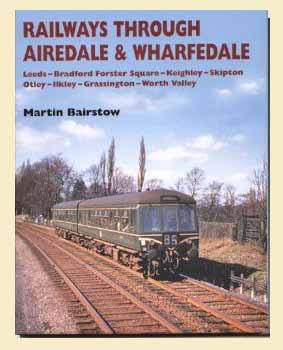 in 1924.
in 1924.
(Insets) A page on the Aire Valley Line would not be complete without mentioning the wonderful series of railway books by Martin Bairstow, including this one, 'Railways Through Airedale & Wharfedale - highly recommended. Click on image (left) to find out more. Also mention is made of the Aire Valley Rail Users Group (AVRUG) which campaigns tirelessly to support today's rail passengers using the Aire Valley Line and the routes from Airedale to Carlisle, Morecambe and London. To  ensure that rail passengers enjoy the best possible train services and station facilities, AVRUG has a close relationship with other rail user groups concerned with the promotion of a quality public transport. Click on photo-link to visit the AVRUG's interesting website.
ensure that rail passengers enjoy the best possible train services and station facilities, AVRUG has a close relationship with other rail user groups concerned with the promotion of a quality public transport. Click on photo-link to visit the AVRUG's interesting website.
In 1845 the fledgling Leeds & Bradford Railway Company obtained a further Act to build an extension of the line through the upper Aire Valley from Shipley to Skipton and beyond to Colne. The first section opened from Shipley to Keighley on 16 March 1847, followed by a second section between Keighley and Skipton on 7 September 1847 and the final section between Skipton and Colne on 2 October 1848. The following year the North Western Railway built a line from Skipton to Clapham, and in 1850 the company extended the line through to Morecambe. Then eleven years later the company - known also as the 'Little North Western' - opened a route from Clapham to Lowgill in the Lune Valley; this gave the MR access to Carlisle, but dissatisfied with the LNWR's handling of its traffic to the north, the Midland Railway opened its own line from Settle Junction to Carlisle in 1876, and this created a direct route for trains between London and Glasgow. The opening of the S&C established the Aire Valley line as a major Anglo-Scottish rail artery.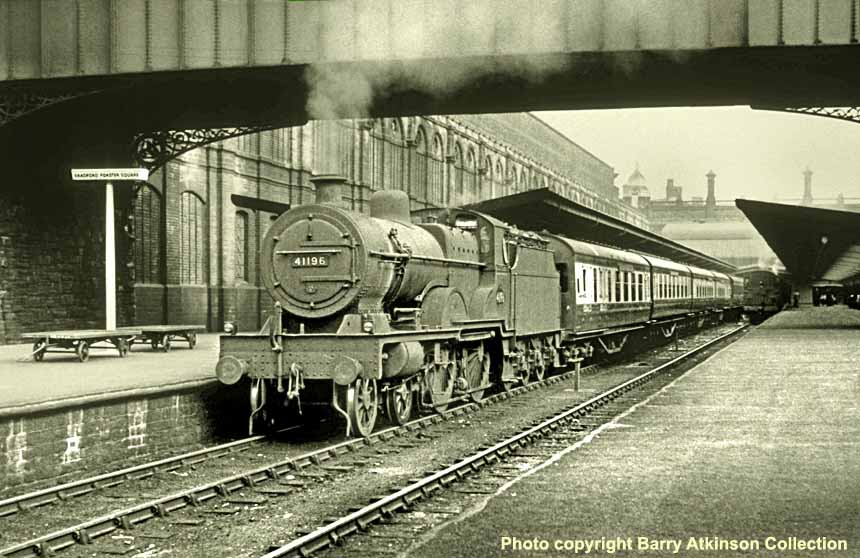
(Above) The Midland Railway's architect, Charles Trubshaw, designed a new Forster Square station in 1892; the station had six platforms and a fine overall glazed roof of the ridge and furrow pattern; the roof was dismantled in the 1950s and replaced with utilitarian 'butterfly' awnings; these can be seen in this evocative shot of former LMS 'Compound' No 41196 awaiting departure with the 15.55 Bradford portion of Bradford/Leeds/Morecambe residential in April 1958. (Inset-Below) The impressive roadbridge spanning the platform ends at Bradford Forster Square was supported by huge ornamental wrought iron brackets decorated with the Midland Railway's Wyvern - a winged two-legged dragon with a barbed tail - which sits in the middle of a garter that formed part of the company's coat-of-arms. Rail cameraman, Peter Thorpe, noticed them when taking photos at Forster Square during the Sixties; he writes - 'There were eight to ten wrought iron supports under the bridge and I was amazed to see this Wyvern in auction (John Manders BRA) many years later. I sold some smokebox number plates to pay for it and was delighted to own it until a few years ago when we downsized on retirement. The item was very heavy and the letters were cast separately and screwed to the 'ring' individually; an example can be clearly seen in this photo (below) of 'Royal Scot' class No 46128 The Lovat Scouts awaiting departure from platform six on 26 May 1964.'
(Inset-Below) The impressive roadbridge spanning the platform ends at Bradford Forster Square was supported by huge ornamental wrought iron brackets decorated with the Midland Railway's Wyvern - a winged two-legged dragon with a barbed tail - which sits in the middle of a garter that formed part of the company's coat-of-arms. Rail cameraman, Peter Thorpe, noticed them when taking photos at Forster Square during the Sixties; he writes - 'There were eight to ten wrought iron supports under the bridge and I was amazed to see this Wyvern in auction (John Manders BRA) many years later. I sold some smokebox number plates to pay for it and was delighted to own it until a few years ago when we downsized on retirement. The item was very heavy and the letters were cast separately and screwed to the 'ring' individually; an example can be clearly seen in this photo (below) of 'Royal Scot' class No 46128 The Lovat Scouts awaiting departure from platform six on 26 May 1964.' 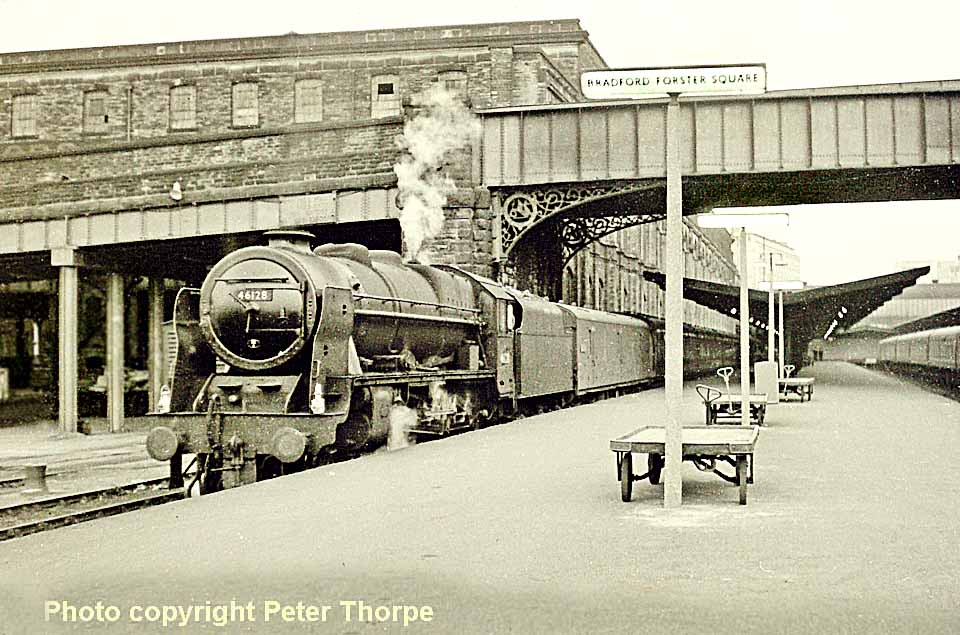
(Below) An enamel British Railways North Eastern Region station sign, measuring 29" x 13" with an arrow pointing the way to Bradford Forster Square Station went under the hammer for £1,800 at a Great Northern Railwayana Auction in April 2016. The enterprising GNRA auction house was started up by David Robinson, a railway enthusiast since he was a small lad until the age of 17, when other things got in the way! However, as the years have gone by he finds the urge to collect items of railwayana not only revives fond memories of his childhood spotting days, it helps in the running a top class Railwayana business based in the north. Click HERE to visit the fascinating GNRA website..
(Inset Right) The 1950s saw the beginning of a new era for Britain's railways when finance was given to build a fleet of diesel railcars to replace uneconomical steam locomotive workings throughout the rail network. The British Transport Commission (BTC) envisaged 3 types of railcar would be required to cover the various passenger services: branch line, local and suburban services and Inter-City services. Sadly, line closures were to outpace their introduction and the original plan for 4,600 vehicles was drastically cut to 3,810. This 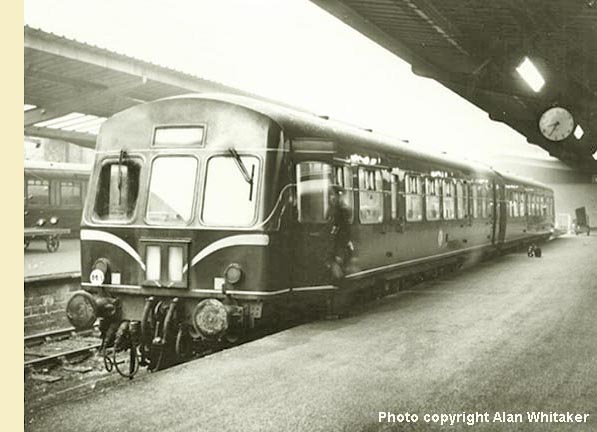 photo shows a Metro-Cammell 2-car set awaiting departure from platform 1 at Forster Square; the maker's style is quite unmistakable with a distinctive raked back cab and the bright aluminium windows on the bodyside. Later to become TOPS Class 101/102, the fleet was an amalgam of several batches of basically similar railcars ordered over a four year period; this example is fitted with a roller blind route panel beneath the cab windows; later batches appeared with a 4-digit panel at roof level.
photo shows a Metro-Cammell 2-car set awaiting departure from platform 1 at Forster Square; the maker's style is quite unmistakable with a distinctive raked back cab and the bright aluminium windows on the bodyside. Later to become TOPS Class 101/102, the fleet was an amalgam of several batches of basically similar railcars ordered over a four year period; this example is fitted with a roller blind route panel beneath the cab windows; later batches appeared with a 4-digit panel at roof level.
(Below-Inset) Dr Richard Beeching's report 'The Reshaping of British Railways' had a devastating affect on the Aire Valley Line. Stations at Apperley Bridge, Armley Canal Road, Newlay and Calverley & Rodley between Leeds and Shipley closed on Saturday 20 March 1965. The line from Bradford Forster Square to Skipton saw closures at Manningham, Frizinghall, Saltaire and Steeton & Silsden on the same day. This left just two stations at Kildwick & Crosshills and Cononley, both remaining open for the Sunday service before closing after the last train had gone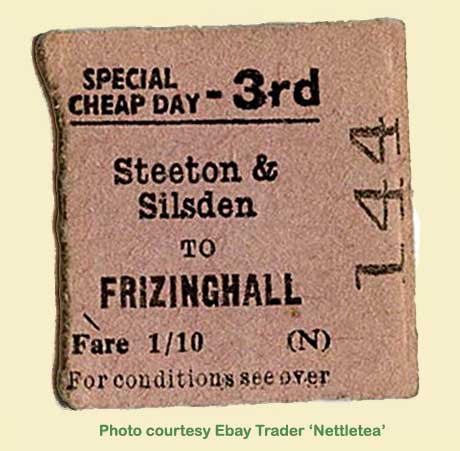 . Coincidentally this ticket stub (reproduced courtesy eBay Trader 'nettletea') relates to a 1957 train journey between Steeton and Frizinghall, both victims of the Beeching axe to reopen. The WYPTE's involvement has seen the reopening of Saltaire in 1984 followed by Frizinghall in 1987, Cononley in 1988 and Steeton in 1990; a new station was built at Crossflatts in 1982 (Below) Following publication of the Beeching Report in March 1963, formal closure notices were issued affecting all services on the Aire Valley Line and Wharfedale. A year later, the Minister of Transport Ernest Marples, political architect of the Beeching Plan, approved closure of 17 out the 22 stations concerned. In 1965 the local service to Leeds ceased. However, the decision to withdraw the service to Ilkley was deferred and this resulted in a reprieve for Bradford Forster Square. Here Peter Harris captures the scene at Forster Square's platform 1 in 1981.
. Coincidentally this ticket stub (reproduced courtesy eBay Trader 'nettletea') relates to a 1957 train journey between Steeton and Frizinghall, both victims of the Beeching axe to reopen. The WYPTE's involvement has seen the reopening of Saltaire in 1984 followed by Frizinghall in 1987, Cononley in 1988 and Steeton in 1990; a new station was built at Crossflatts in 1982 (Below) Following publication of the Beeching Report in March 1963, formal closure notices were issued affecting all services on the Aire Valley Line and Wharfedale. A year later, the Minister of Transport Ernest Marples, political architect of the Beeching Plan, approved closure of 17 out the 22 stations concerned. In 1965 the local service to Leeds ceased. However, the decision to withdraw the service to Ilkley was deferred and this resulted in a reprieve for Bradford Forster Square. Here Peter Harris captures the scene at Forster Square's platform 1 in 1981. 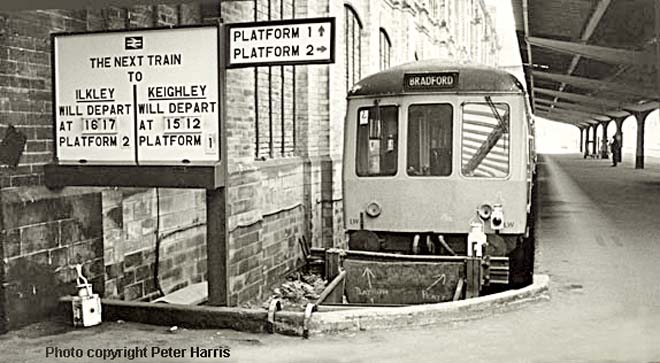
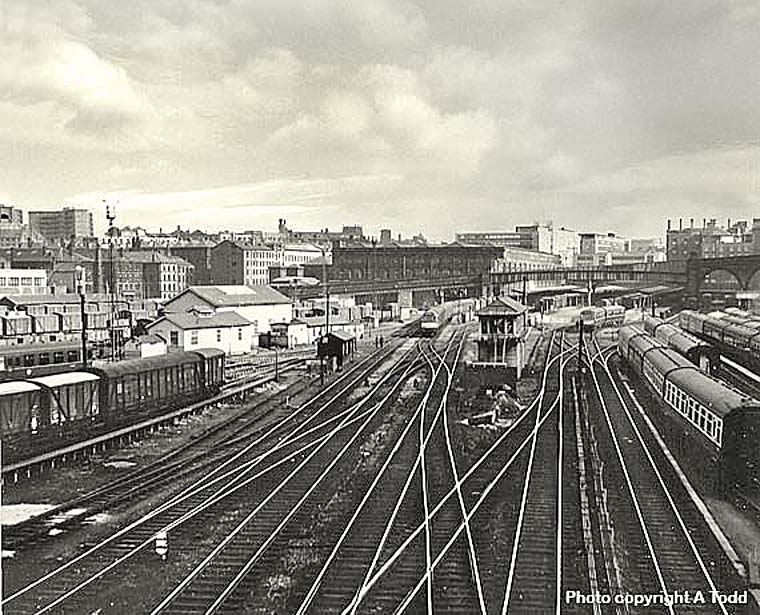
(Above) The Sixties heralded a period of endless upheaval on Britain's railways, with radical changes taking place across the entire rail network; this included the complete closures of main line passenger stations in major cities such as Manchester Central, Sheffield Victoria, the ex-GWR station at Birmingham Snow Hill and the ex-GNR terminus at Leeds Central, concentrating all traffic on Leeds City. British Rail proposed a scheme to close Bradford Forster Square by concentrating all passenger services on Exchange station; indeed all main line trains were eventually withdrawn from Forster Square in 1967, but two platforms 1-2 were fenced off to serve the local dmu services to Ilkley and Keighley which had survived the Beeching axe due to the subsidies provided by Bradford Corporation and local authorities in Shipley, Bingley, Keighley and Ilkley which stepped in to support the Wharfedale and Aire Valley lines. The responsibility for local rail services came under the auspices of the West Yorkshire Passenger Transport Executive (WYPTE) in 1974 after the new Metropolitan County Council was formed. The success of the WYPTE's involvement can be measured by the number of new stations that have opened on the Aire Valley Line. However, with only two platforms being used by local dmu services at Forster Square, the remainder of the station was turned over to the handling of parcels traffic, but in 1981 BR withdrew from the business of collecting and delivering parcels, and the redundant platforms 3-6, along with the adjacent Valley Goods Depot and extensive sidings fell into disrepair. In this photo (above) the once expansive rail layout can be clearly seen. By the mid-80s, all had gone leaving just two operational tracks serving platforms 1-2, with signalling remotely controlled by Shipley-Bradford Junction box. 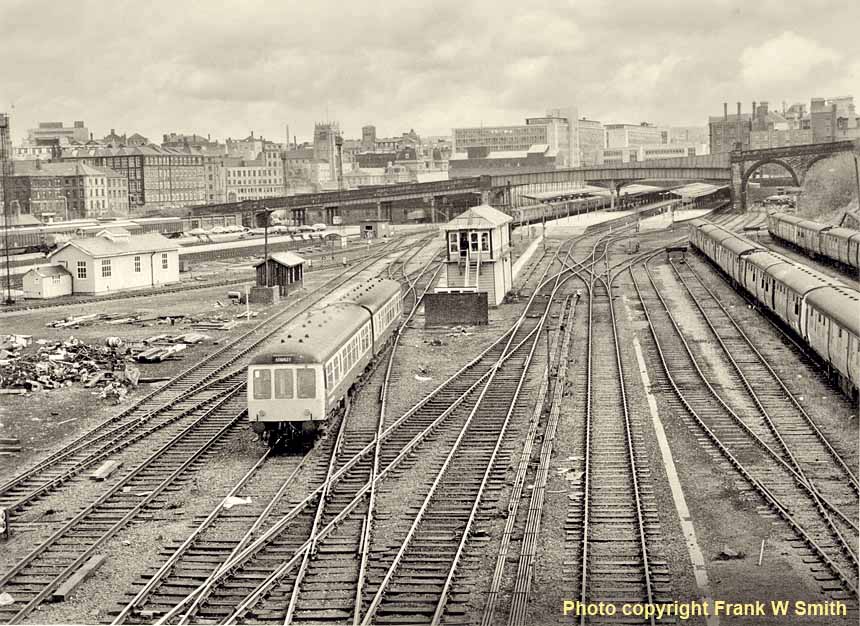
(Above-Below) This interesting shot by FW Smith shows the arrival of the 14.30 from Keighley formed of a 2-car Derby DMU on 11th April 1984. The train is most unusually about to enter platform 6 which had not been used for some considerable time. Evidence of withdrawn Class 306 electric 3-car sets can be seen stored in platform 5 and the carriage sidings on the right awaiting their final journey to Horwich Works for breaking up. (Below) Comparisons can be made with this shot of Bradford Forster Square, taken by Northern Rail driver, Mike Kaye, during a break in the diagram: three trips between Leeds and Bradford on 6th May 1990. Construction is underway on the 'new' Bradford Forster Square station with three platforms numbered 1-3 on the right. The original platforms numbered 1-6 can be seen in the 'old' station on the left. More photos of Forster Square and Bradford Exchange can be found on the excellent 'Lost Railways of West Yorkshire' website HERE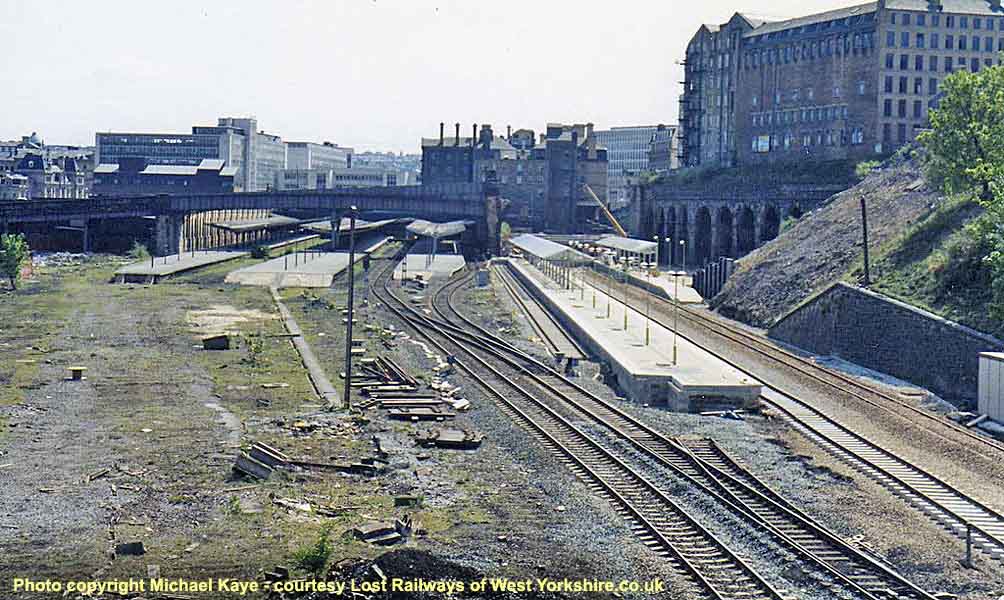
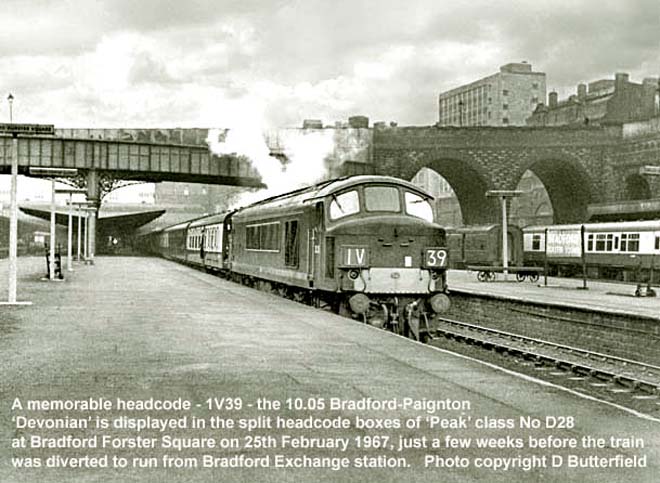
(Above) A memorable headcode - 1V39 - the 10.05 Bradford Forster Square-Paignton 'Devonian' is displayed in the split headcode boxes of 'Peak' class D28 at Forster Square on 25th February 1967, just a few weeks before the train was diverted to run from Bradford Exchange station. Inaugurated in 1927, the 'Devonian' was an inter-Regional titled train that originally applied to the Bradford-Torquay and Paignton section of through coaches, handed over by the LMS to the GWR at Bristol Temple Meads. The service came to an end at the outbreak of World War 2, but was restored in October 1946. The introduction of diesel haulage reduced the 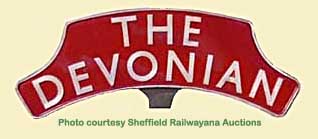 journey time to just over 8 hours. Latterly a Restaurant Car service was provided between Leeds and Paignton.
journey time to just over 8 hours. Latterly a Restaurant Car service was provided between Leeds and Paignton.
(Inset Left) A cast aluminium 'Devonian' headboard measuring 36" x 12½" was sold at Sheffield Railwayana Auctions for £4,500 in September 2011. For students of Britain's railway history the auction sites provide some fascinating background details on the items for sale. For example, the back metal of the 'Devonian' headboard (right) was stamped with the legend 'Train Name Board W786 26-4-49'. Similar inscriptions applied to the names of 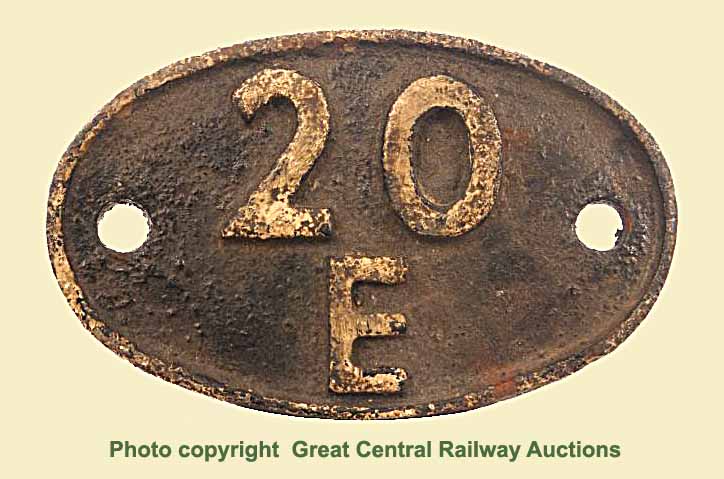 other headboards produced to the same dimensions, such as: 'The Red Rose', 'The Red Dragon', 'The Bristolian' and the 'Inter-City'. The back was also stamped with the word 'Bristol' indicating the owning depot.
other headboards produced to the same dimensions, such as: 'The Red Rose', 'The Red Dragon', 'The Bristolian' and the 'Inter-City'. The back was also stamped with the word 'Bristol' indicating the owning depot.
(Right-Below) This 20E shedplate, clearly in ex-loco condition, went under the hammer for £320 at a Great Central Auction in July 2013. A sub shed of 20A Holbeck Leeds, 20E was the code used by Bradford Manningham from 1935 to October 1956. This ex-MR shed was later coded 55F from 1957 up to closure on 30 April 1967. (Below) Built at Derby in July 1924, this Class 4P 4-4-0 3-Cylinder Compound No 41063 stands side by side with Class 4F shedmate 44400 in the stalls at Manningham shed. The sacking over the chimney is an ominous sign; No 41063 was withdrawn from Manningham on 31 October 1960 and cut up at Doncaster Works.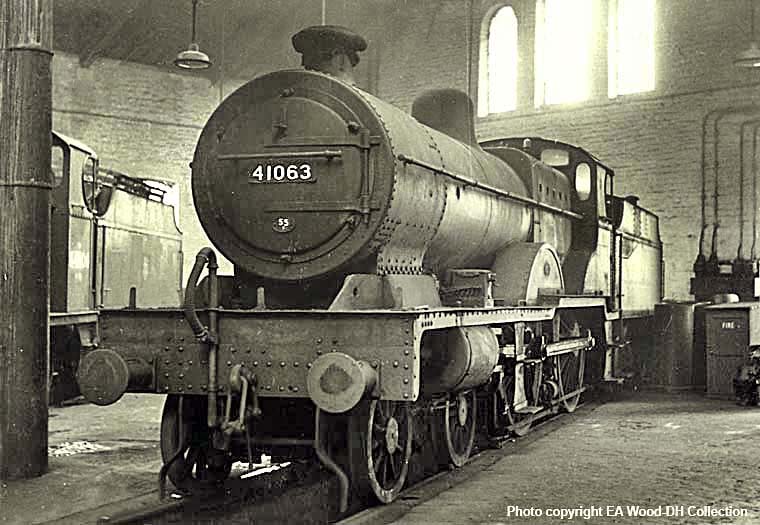
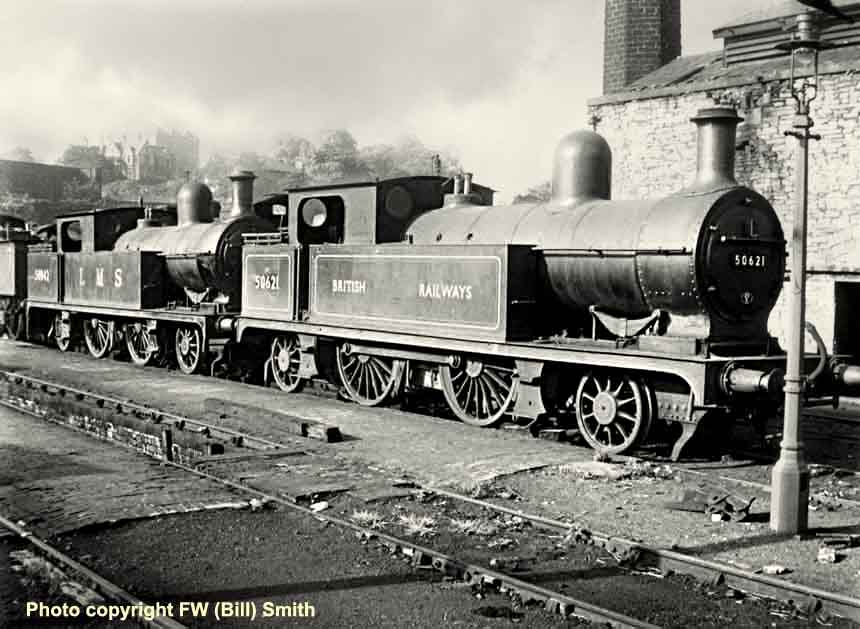
(Above-Below) Ex-LYR 2-4-2Ts Nos 50621 and 50842 at Manningham shed on 2nd August 1951. Note the different safety valves. (Below) Introduced to traffic in December 1952, 'Britannia' Class 7MT No 70035 Rudyard Kipling began service at Norwich Thorpe depot (32A). 70035 later moved to March shed (31B) in June 1958, but soon returned to Norwich in January 1959 until being ousted by new diesels. 70035's next allocation was to Immingham (40B) during October 1961, then back to March (31B) in June 1963 for a period of six months, before moving to Carlisle Kingmoor MPD (12A) to eke out the final four years of its rather short service life. The now-nameless 70035 is being coaled up at Bradford Manningham shed's dilapidated coal stage shortly before closure of the depot in April 1967. The poor external condition of 70035 was typical for the period, showing a grime-encrusted livery rendering the company crest invisible, but otherwise looking fit for purpose. No 70035 was withdrawn from Carlisle Kingmoor on Saturday 30th December 1967.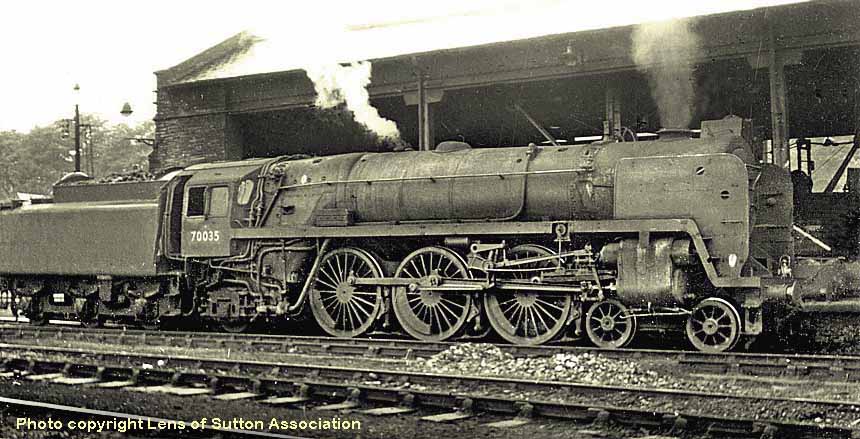
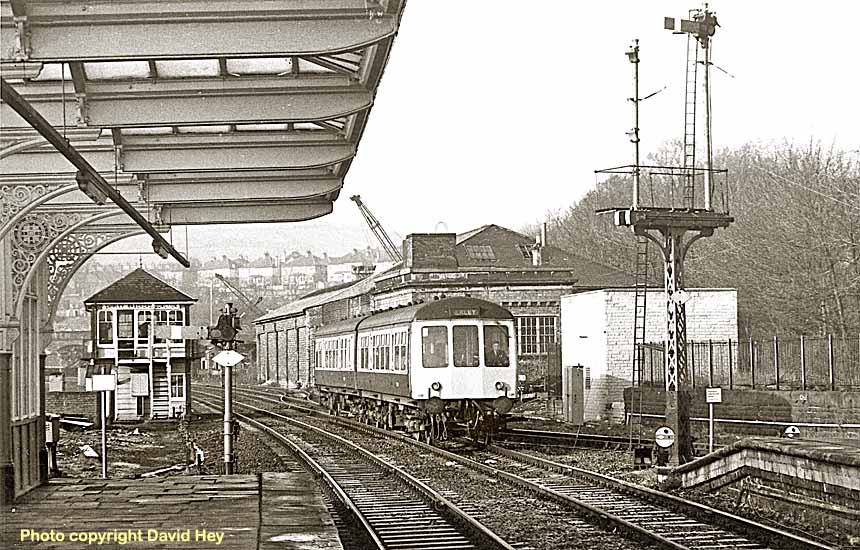
(Above) Shipley Bradford Junction box controlled the west side of the Shipley triangle; in October 1984 a small panel was installed on the block shelf to control the line to Bradford after Bradford Forster Square and Manningham Station Junction boxes were closed. This was later replaced in June 1990 when new platforms were provided at Forster Square to accommodate the return of InterCity trains via Leeds to Kings Cross.
(Below) Built at Crewe between 1951-52, the ten BR Standard Class 6MT Clan Pacifics were divided equally between Polmadie in Glasgow (66A) and Carlisle Kingmoor (12A) for duties previously worked by the LMS 'Jubilee' and 'Patriot' classes; Nos 72000-4 went to Polmadie and Nos 72005-9 were assigned to Carlisle Kingmoor (12A). Here, No 72009 Clan Stewart makes a spirited departure from Shipley with the 3.40pm Bradford to Carlisle all stations marathon on 16 April 1964. The Clans based at Carlisle were occasional visitors on this working and the out-and-back trip was often used as a running-in turn by Kingmoor shed. No 72009 was withdrawn on 28 August 1965 and cut up by Motherwell Machinery and Scrap Company Ltd in November that year. 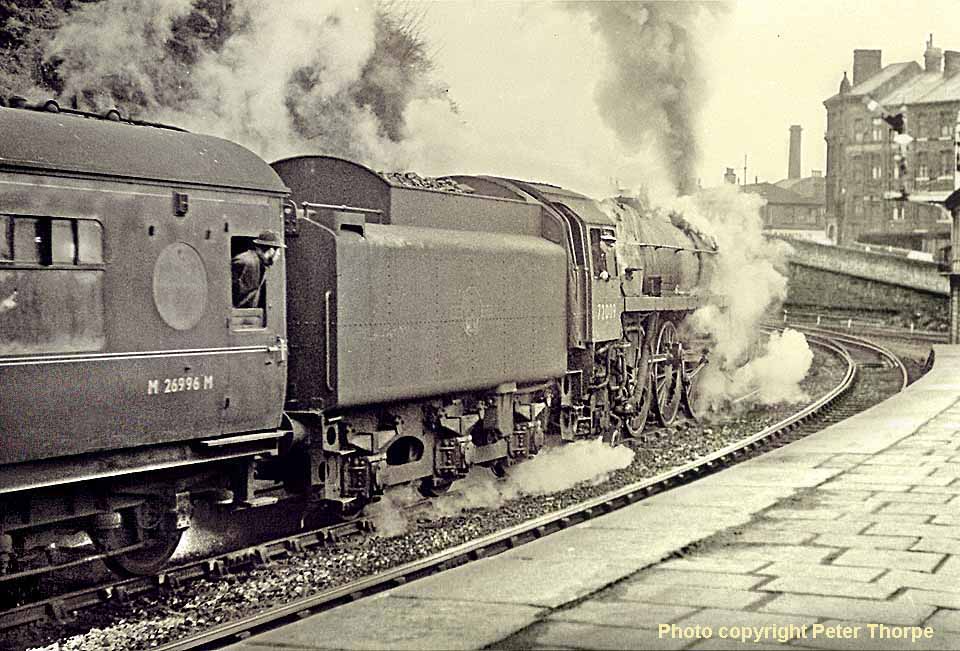
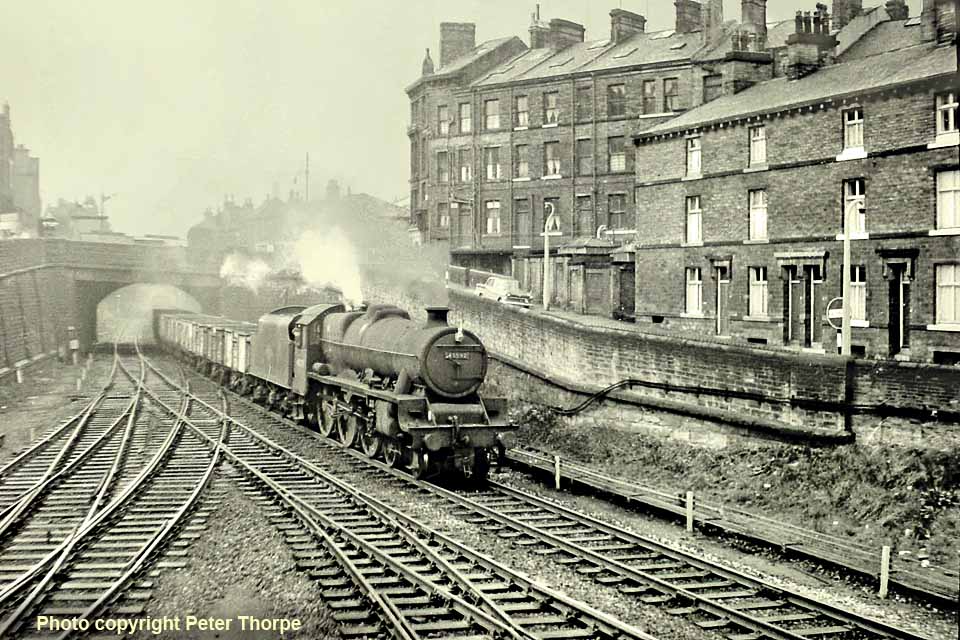
(Above) Just five months prior to withdrawal, Carnforth's Jubilee class No 45592 Indore heads a rake of empty coal wagons through Shipley-Keighley Junction on 25 April 1964. More Shipley photos can be found on Rail Cameraman Peter Thorpe's page 63. Photo details 1/500sec @ f2.8
(Below) As mentioned on the previous page, the triangular layout of the station at Shipley has taken more than 130 years to evolve. It began in September 1847 when the L&BRC created a junction on the Leeds-Bradford line to accommodate the railway's extension to Keighley and Skipton. Platforms were provided on the Bradford to Leeds curve and the Bradford to Skipton curve, but the Leeds-Skipton main line remained 'platformless'. This meant that local Leeds-Skipton service had to pass through the Leeds-Bradford platform then reverse into the Bradford-Keighley platform, involving signalmen in no end of lever-pulling and clanging of bells at both the Shipley-Bradford Junction box (above) and Shipley-Bingley Junction box (below). The ex-MR semaphore is the No 19 'Down' Bradford home to 'Down' Main; this was operated by Shipley-Bingley Junction box for the Bradford-Skipton trains using the bi-directional platform 2 at Shipley; the semaphore was replaced by a two aspect colour light signal in 1994. Following closure of the signalbox on 25th June 1994, the structure was dismantled and moved to the KWVR the next day. It is anticipated the box will be commissioned in time to celebrate the 50 year anniversary of the opening of the Keighley & Worth Valley Railway in 2018. Click HERE to vist the excellent KWVR website.. 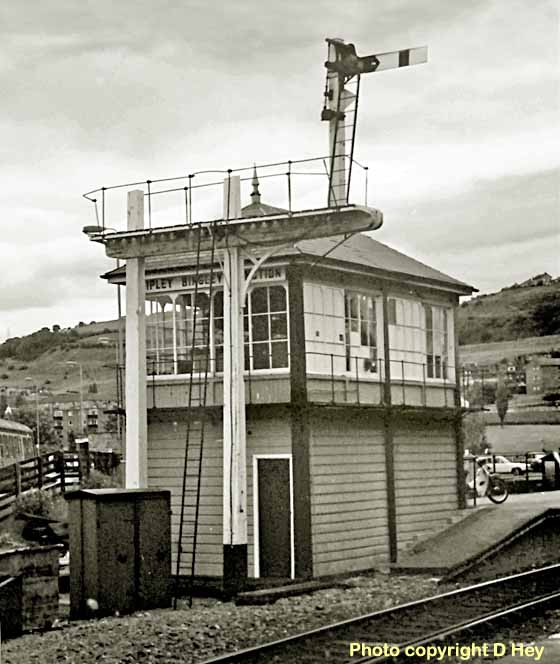

(Above) At the beginning of the 1980s, the future of the Settle-Carlisle line as a major rail artery was in some doubt, but it wasn't until August 1983 that the rumour of closure was confirmed. By then, only a modicum of freight, together with two daily passenger services in each direction between Leeds and Carlisle formed the line's regular service. The announcement was coincident with the introduction of Class 40 No 40122 (D200) into regular service on the line. The loco, based at Carlisle, worked the 10.40 Carlisle-Leeds and 16.10 return. Repainted in original green livery (with white lining at cantrail height) the Class 40 departs with the return working to Carlisle from the single bi-directional platform opened in May 1979 on the Leeds-Skipton curve. It wasn't until 1992 that a new platform on the 'up' line (to Leeds) was opened. 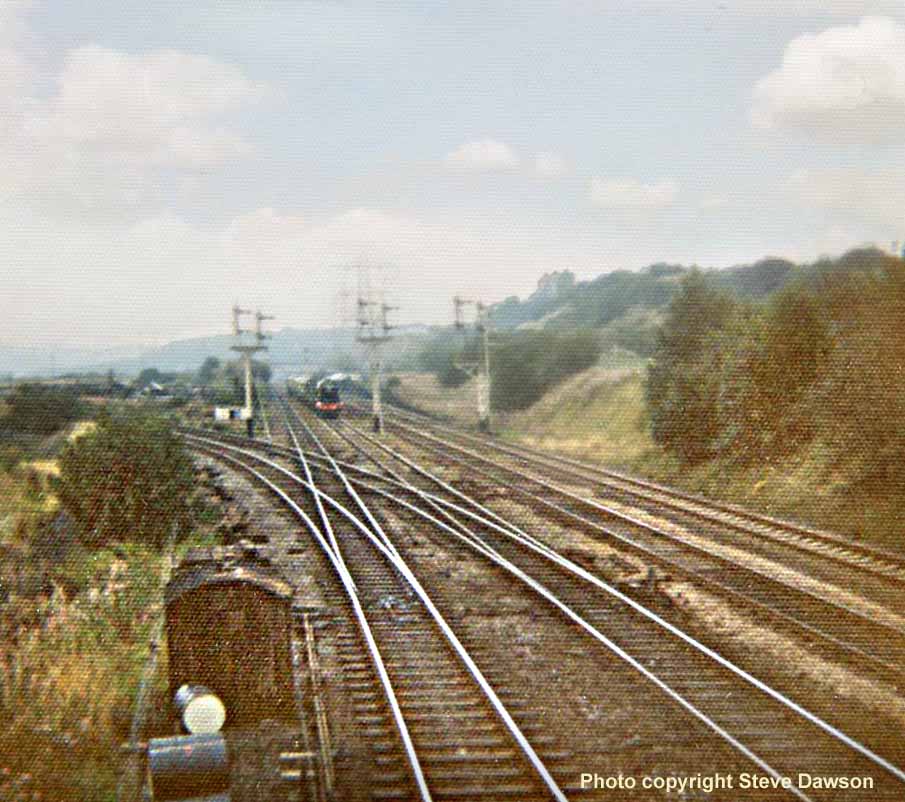
(Above-Inset)This view from Guiseley Junction signal box shows the divergence of the branch to Guiseley and Ilkley from the Aire Valley line. The shot was taken on a Kodak Instamatic camera by signalman, Steve Dawson, who was operating the frame on the day that Class A3 No 4472 Flying Scotsman and ex-Great Western 'Hall' class were returning to Carnforth after taking part in the 'Cavalcade of Steam' celebrations at Shildon to commemorate the 150th anniversary of the Stockton and Darlington Railway in August 1975. The 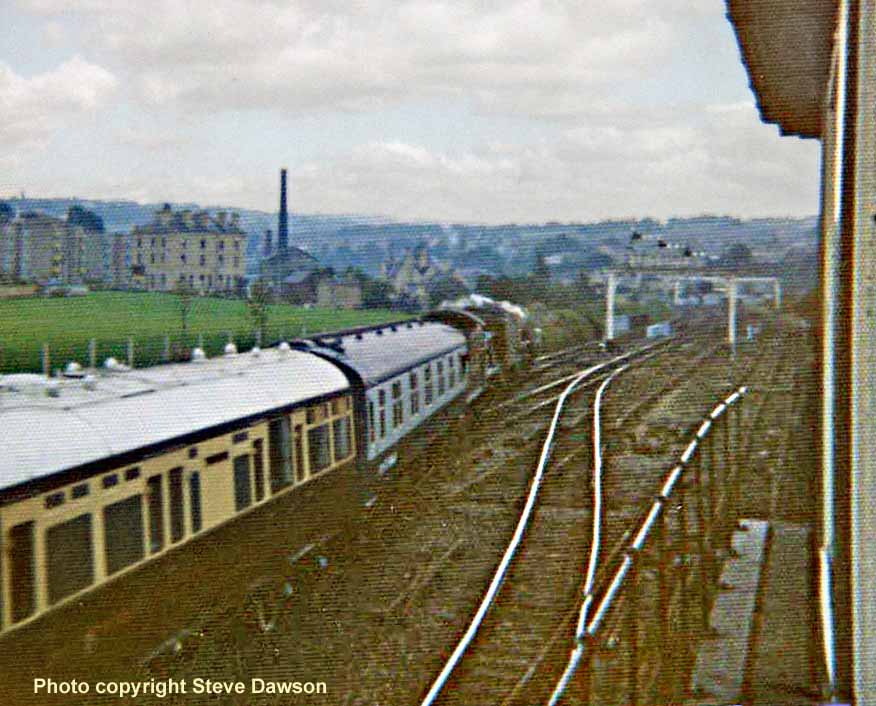 locomotives were hauling a mixed rake of Victorian coaching stock and arrived at Guiseley Junction in the middle of the teatime rush; since a Class 5 train (Empty Coaching Stock) had little priority, Steve held them there for about 15 minutes whilst other express and local traffic was dealt with. This allowed numerous photographers to descend on the scene, which was very unusual on British Rail metals in 1975. The inset shot shows much evidence of track rationalisation as the ensemble proceeds towards Shipley-Bingley junction box.
locomotives were hauling a mixed rake of Victorian coaching stock and arrived at Guiseley Junction in the middle of the teatime rush; since a Class 5 train (Empty Coaching Stock) had little priority, Steve held them there for about 15 minutes whilst other express and local traffic was dealt with. This allowed numerous photographers to descend on the scene, which was very unusual on British Rail metals in 1975. The inset shot shows much evidence of track rationalisation as the ensemble proceeds towards Shipley-Bingley junction box.
(Below) By the mid-1980s the Aire Valley's heydays of Anglo-Scottish expresses and locomotive hauled passenger traffic from Leeds to Carlisle and Morecambe were just a memory. The line's freight traffic also slumped; the Heysham traffic ceased and the quarry at Ribblehead no longer despatched ballast for Healey Mills. The bitumen terminal at Skipton closed and the only regular freight traffic on the route was the Tilcon trains from the Swinden Quarry at Rylstone. This is the loaded train (6D03) for Hunslet East, seen passing Guiseley Junction behind a pair of 31s. 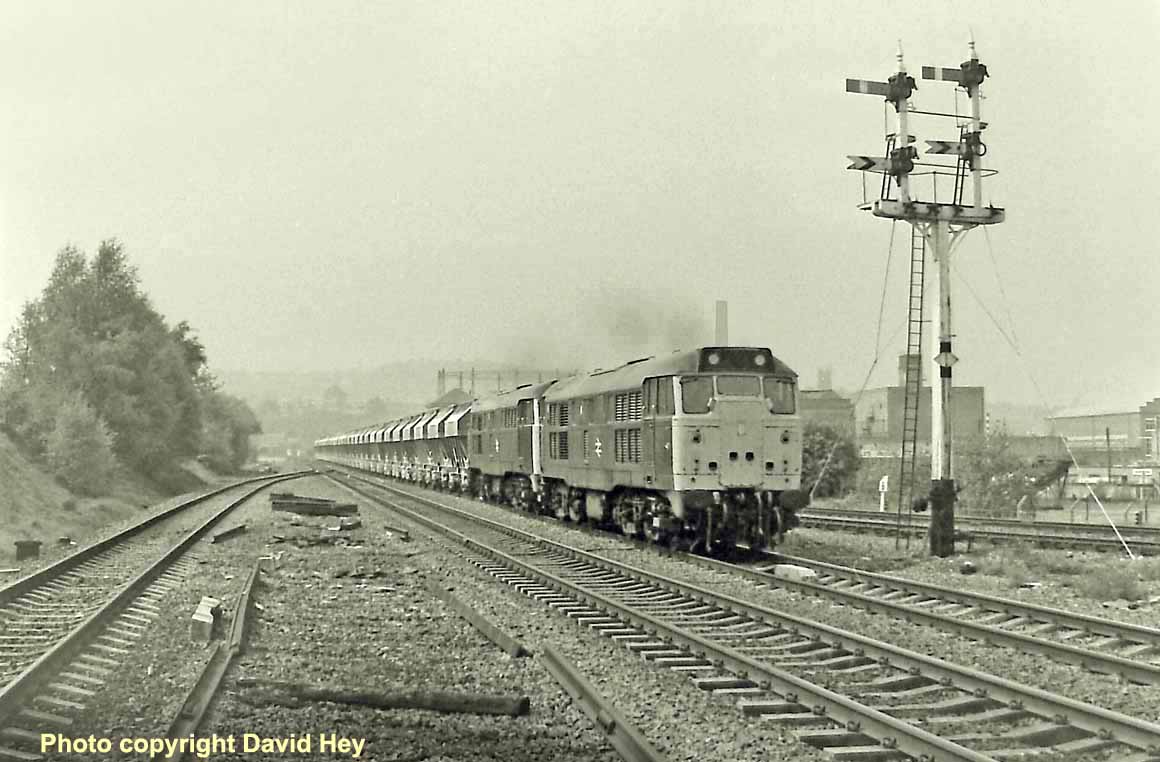
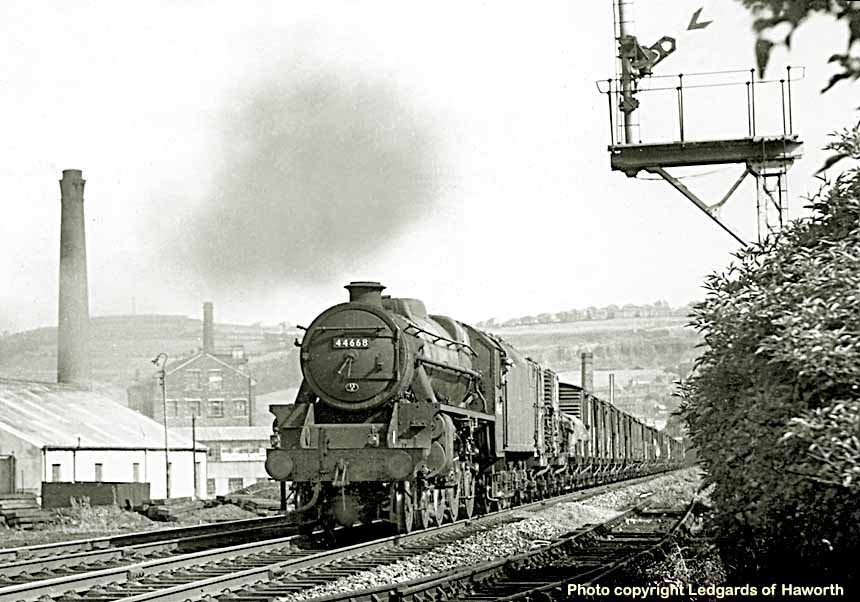
(Above-Below) A fine study of Carlisle Kingmoor's 'Black 5' No 44668 heading a northbound freight between Shipley and Saltaire. (Below) With the digital age gathering pace, rail enthusiasts can now engage their interest in trains in a number of ways. Among the most recent is the penchant for digital modelling using computer software. This enables them to build a working model of a favourite line and simulate train operations and cab rides. Either way, it takes a great deal of skill and patience to create an accurate computer model; the first thing they need to do is thoroughly research the subject in order to accurately replicate the railway infrastructure: station buildings, track layouts, embankments, cuttings, bridges and tunnels, and the numerous signal boxes which were demolished years ago when the semaphores were replaced by colour lights. Here is a screenshot from Keith Rigby's computer simulation of the Aire Valley Line between Leeds and Skipton. 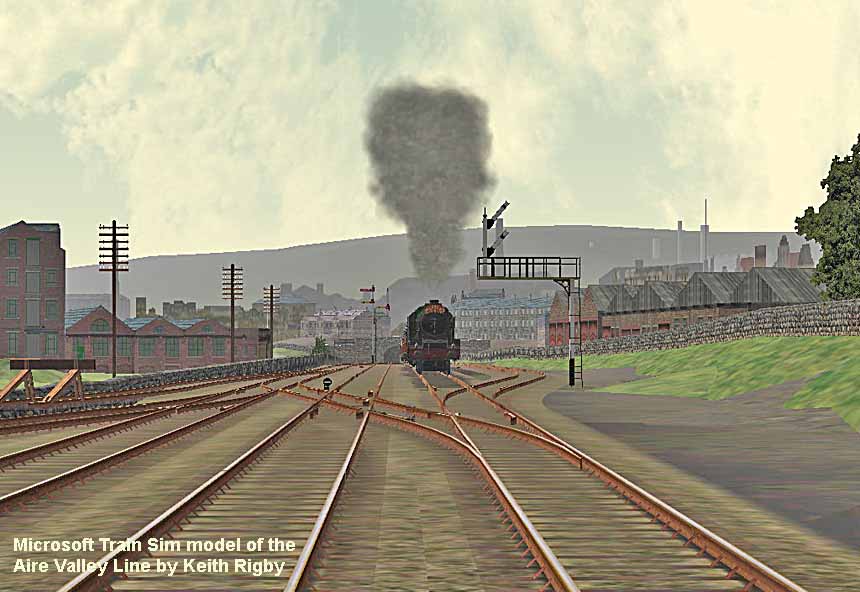
(Below) This view in the opposite direction shows the four-track section still intact, as 'Royal Scot' class 46130 The West Yorkshire Regiment approaches Shipley with the 'up' 'Waverley' express in June 1961. The goods loops between Shipley and Saltaire were lifted in 1967.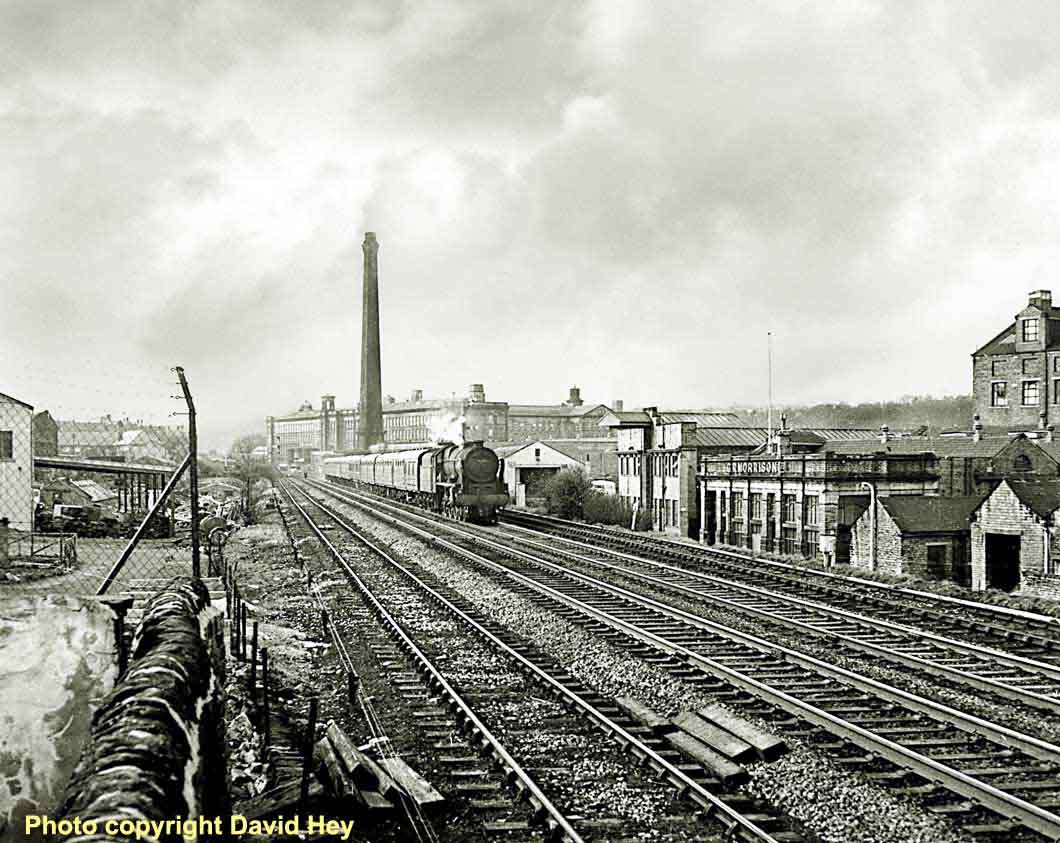
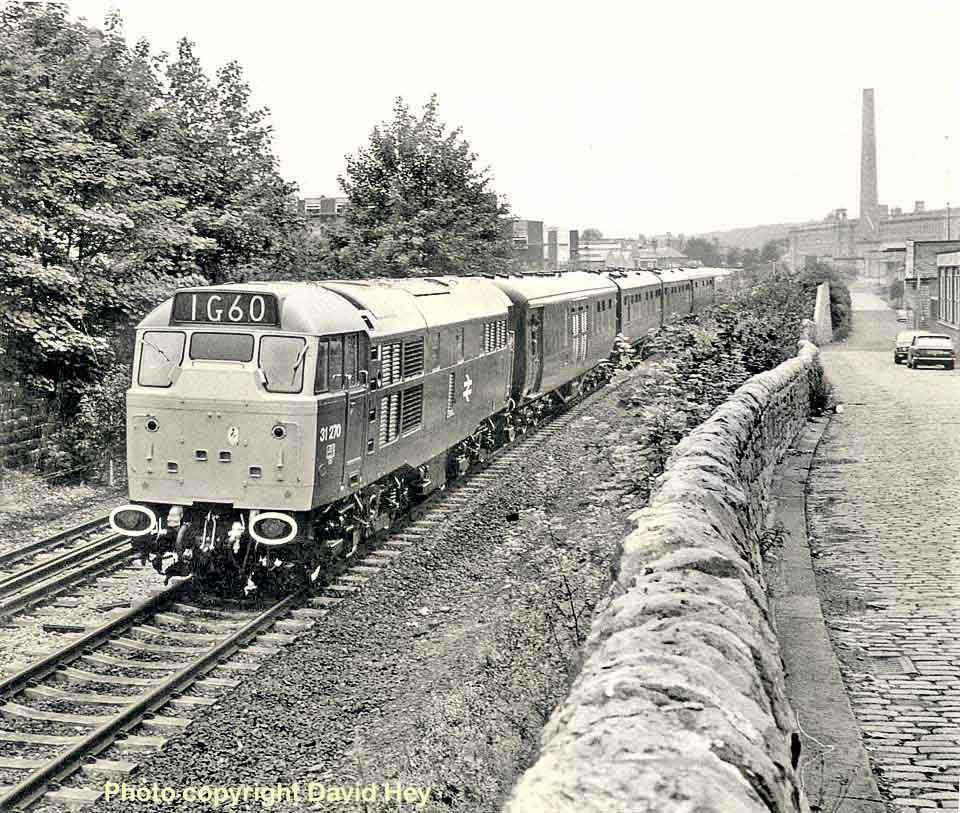
(Above-Below) 'Tarted up to the nines,' as they say in Yorkshire - even the defunct roof-mounted headcode boxes of this ageing Class 31 31270 have been revived for the occasion - 1G60 Royal Train duties - probably its most prestigious working. The ensemble is seen approaching Shipley on a date I have yet to establish. (Below) Following its obligatory stop at Saltaire, this early-liveried Class 108 2-car set has a mere ¾-mile to go before its next stop at Shipley in June 1961. In the background can be seen Saltaire's famous mill complex, regarded as one of the finest examples of an intact Victorian industrial village and designated a conservation area by the Department of Environment. Saltaire Village was founded in 1851 by Sir Titus Salt, a leading industrialist in the woollen industry, who moved his business of five separate textile mills from Bradford to one large mill beside the Leeds-Liverpool Canal at Saltaire. His workers were provided with housing, school, church and a hospital.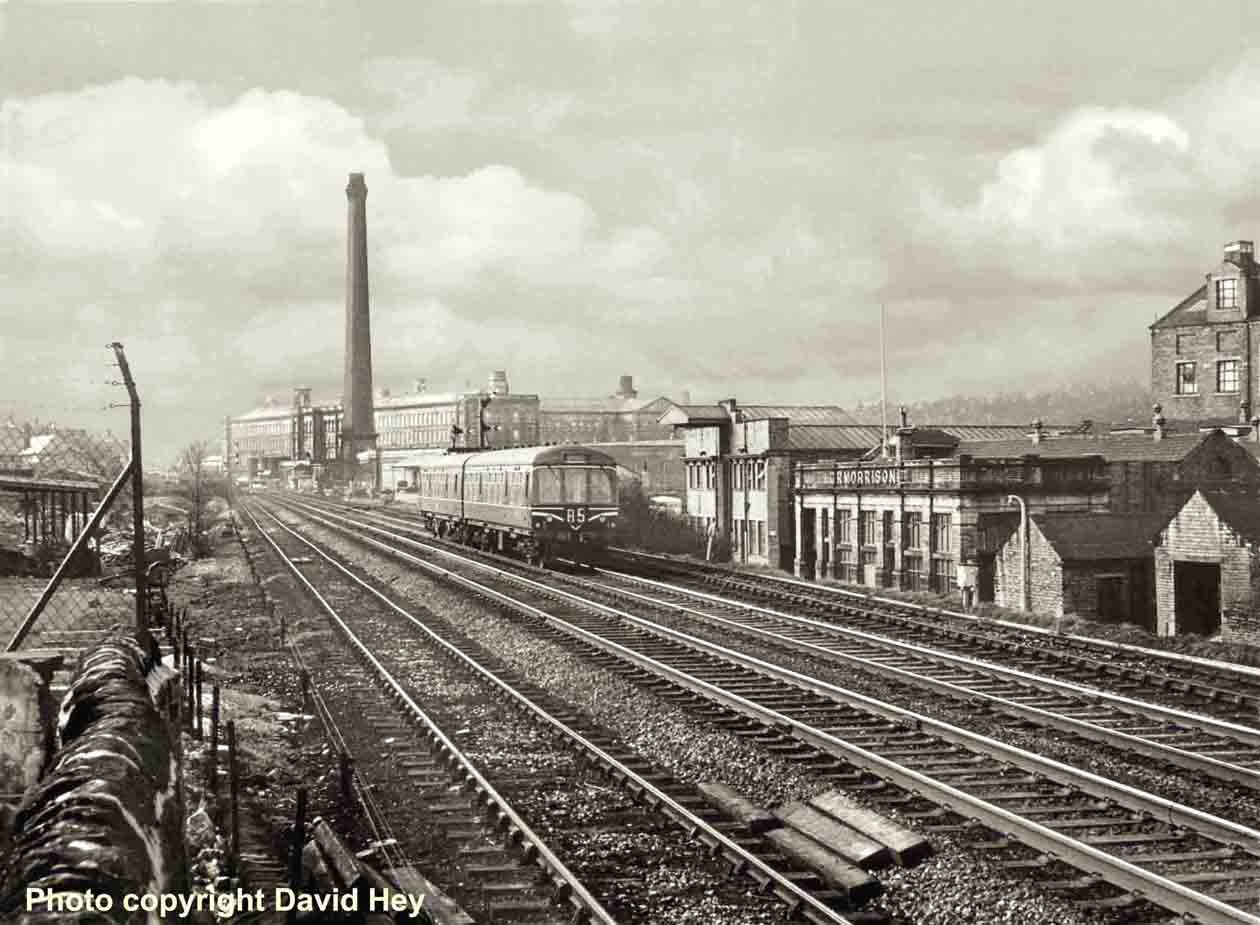

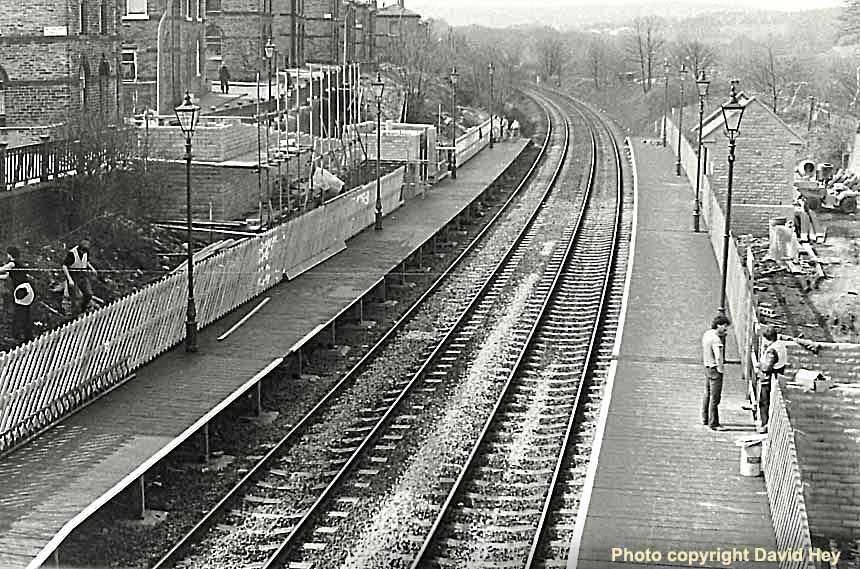
(Above-Below) Saltaire railway station was demolished soon after the withdrawal of local passenger services in 1965. The service was resumed in 1984 when the West Yorkshire Passenger Transport Executive (WYPTE) financed a new station, built generously in local stone to comply with the conservation standards laid down for the ten acre 'Palace of Industry'. Following closure of the textile mill in February 1986, the building was renovated and now accommodates a number of small businesses from commerce and leisure, plus an art gallery featuring the work of Bradford-born artist, David Hockney.
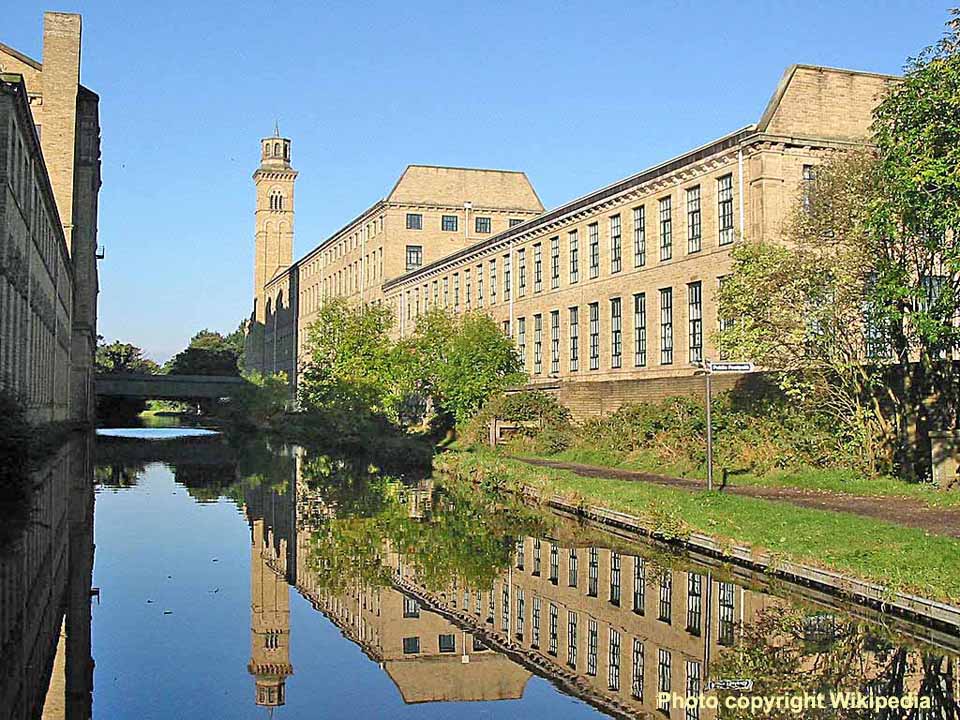
(Above-Below) Opened in 1816, the 127 mile-long Leeds-Liverpool Canal lays claim to be the longest of England's inland waterways, and the first to cross the Pennines connecting the industrial heartlands of the West Riding and East Lancashire; it certainly helped the Aire Valley's textile trade. The biggest clue of the mill owners' reliance on the canal is the large number of weaving and spinning mills built along its banks, a classic case being the mill at Saltaire founded by Sir Titus Salt...click HERE to visit the Wikipedia site. (Below) Saltaire's Baroque Chapel tower can be seen on the horizon ¾ mile away, as 'Black 5' No 44892 - sporting a Carnforth (24L) shedplate - heads a Leeds-Morecambe train towards Bingley; the sidings on the right served an iron foundry at Hirst Wood. 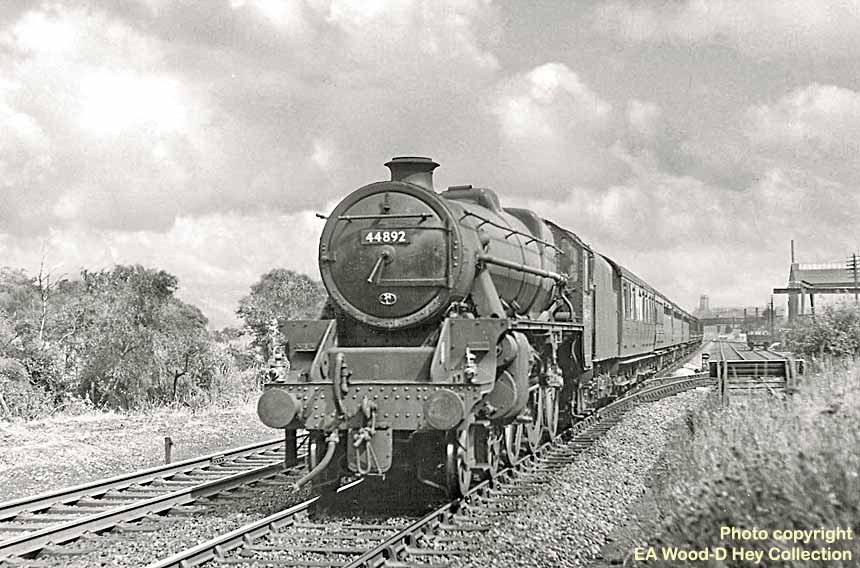
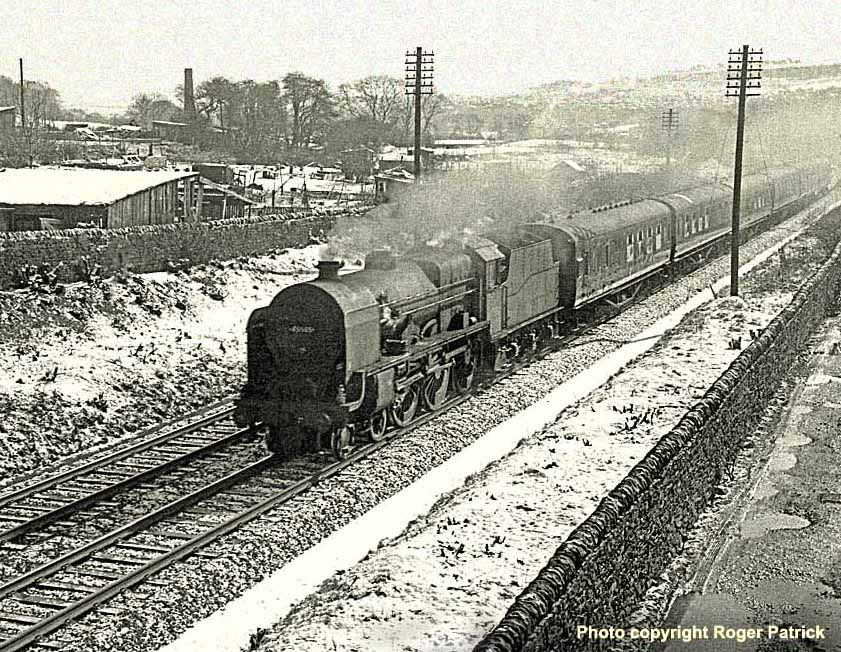
(Above) This shot by Roger Patrick of 'Patriot' class No 45505 The Royal Ordnance Army Corps heading a Leeds-Morecambe train brings back fond memories of childhood spotting days. The 3-cylinder LMS 6P5F 'Patriot' 4-6-0s Nos 45500-45551 were built at the end of Sir Henry Fowler's reign as CME of the LMS (1925-1932). Fowler created his design by using a combination of standard parts, consisting of a 3-cyliner front end and motion on the lines of his earlier 'Royal Scot' class and the enlarged G9 ½" S boiler as utilised on Bowen and Cook's London and North Western 'Claughton' class. Often referred to as 'Baby Scots' on account of their likeness (in appearance) to the larger parallel boilered 'Royal Scot', the 'Patriots' were fast and powerful engines for their size. Between 1946-1948, eighteen locomotives were rebuilt by Ivatt with double chimneys, new cylinders, large 2A tapered boilers and designated Class 7P; the remainder continued in their unrebuilt form until the summer of 1962 when an influx of new Type 2 diesels led to the mass withdrawal of nine members; this included 45505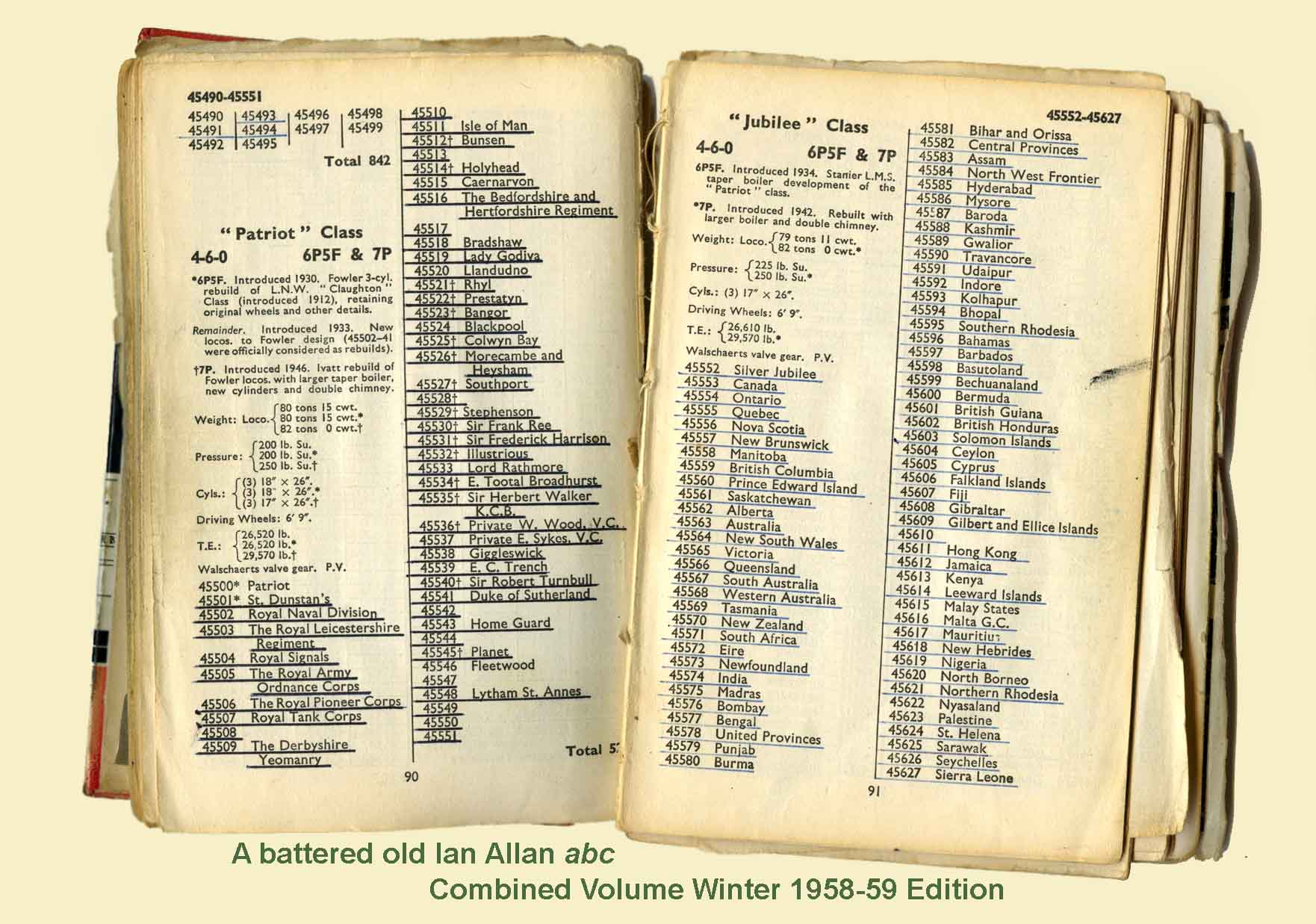 seen here heading the 14.30 Leeds to Morecambe through the wintry landscape at Bingley. Built at Crewe in July 1932, No 45505 was withdrawn from Lancaster Green Ayre shed (24J) in June 1962.
seen here heading the 14.30 Leeds to Morecambe through the wintry landscape at Bingley. Built at Crewe in July 1932, No 45505 was withdrawn from Lancaster Green Ayre shed (24J) in June 1962.
(Inset) The full compliment of 'Patriot' class locos are shown here in a tatty Ian Allan abc combined spotters book Winter 1958-59 edition.
(Below) The withdrawal of the nine 'Patriots' Nos 45505/10/15/17/37/38/41/42/48 in the summer of 1962 left just two unrebuilt members of the class still in traffic: Nos 45543 and 45550. Here, sporting a Lancaster Green Ayre shedplate on the smokebox door, No 45543 Home Guard gets the right away at Bingley with the 12.20 Morecambe-Leeds. Built at Crewe Works in March 1934, 45543 was delivered new to Edge Hill (8A) followed by spells at Carlisle Upperby (12A) Crewe North (5A) Preston (24K) Longsight (9A) Lancaster Green Ayre (24J) and finally Carnorth (24L) from where the engine was withdrawn on 17 November 1962. The following month, the final unrebuilt 'Patriot' No 45550 was withdrawn from traffic at Carnforth on 1st December and disposed of at Crewe in August 1963....the class extinct! However, that's not the end of the story...click HERE to visit the incredible LMS Patriot.Org website. The aim of the Group is to build a new National Memorial engine to the same Sir Henry Fowler parallel boiler design, and name it 'The Unknown Warrior' in time for the 100th Anniversary of the Armistice in 2018. Perhaps you can help?...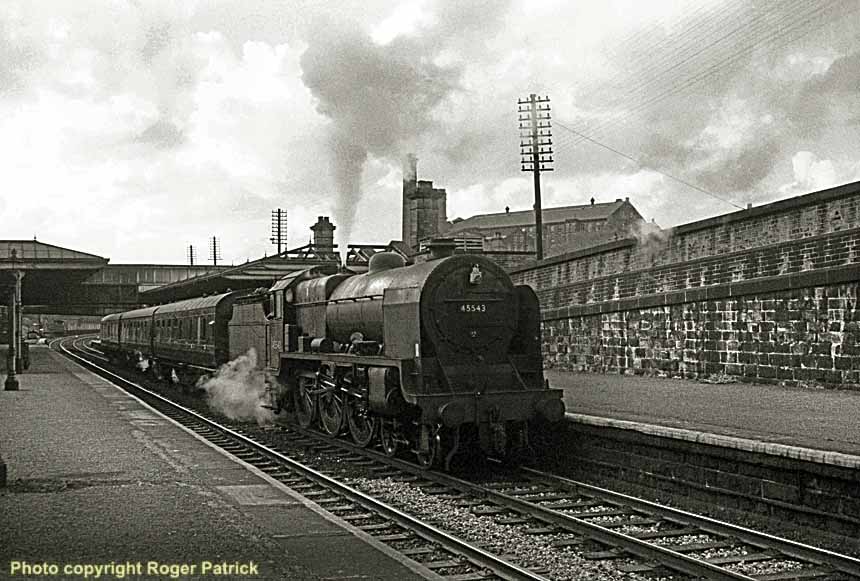
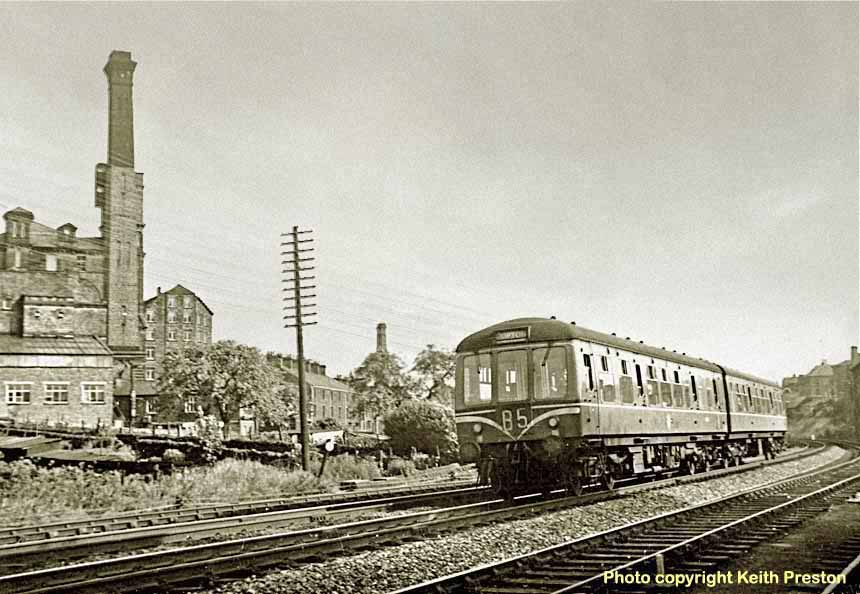
(Above-Below) The basic premise of diesel multiple unit (dmu) operation is that the engines of several railcars could be coupled together to meet varying traffic needs, therefore the power available becomes proportional to the length of the train. However, as the new diesel programme progressed, several different types of transmission were introduced and many of the first-generation dmus became incompatable and unable to work in multiple with each other. As a result, the control systems were colour-coded so that jumper leads could not be connected in error. In all, five transmission codes were introduced: Red Triangle, Yellow Diamond, White Circle, Orange Star, and Blue Square - the latter being the most common category covering 3,206 vehicles out of the fleet of 3,810 dmus. With the Blue Square symbols painted on the front end (visible between the marker lights and buffers) this Derby Class 108 2-car set departs Bingley on the service to Skipton. (Below) In the opposite direction, perhaps the same 2-car set as the above photo, Keith Preston captured this shot of a return working approaching Bingley. Both photos feature the addition of a cab front 'V'-shaped chevron, dubbed 'cat's whiskers' by railwaymen. These were added in an attempt to warn permanent way staff. The chevrons were later replaced by rectangular yellow warning panels. This photo gives us a brief glimpse of the spectacular Bingley 5-rise staircase locks on the right, but of particular interest to enthusiast are the number of semaphores compared to the shot below.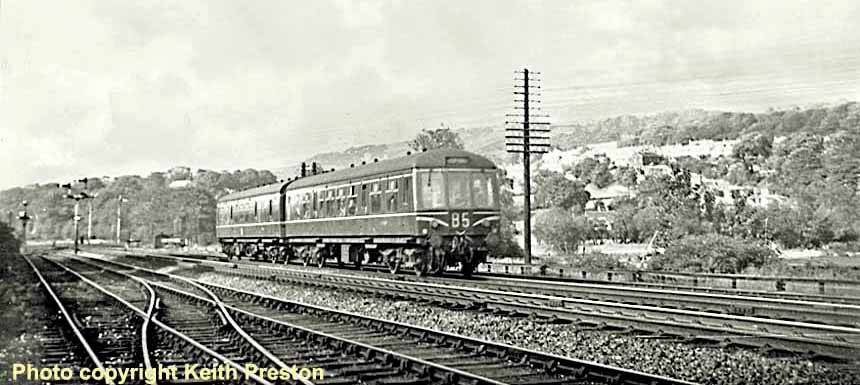
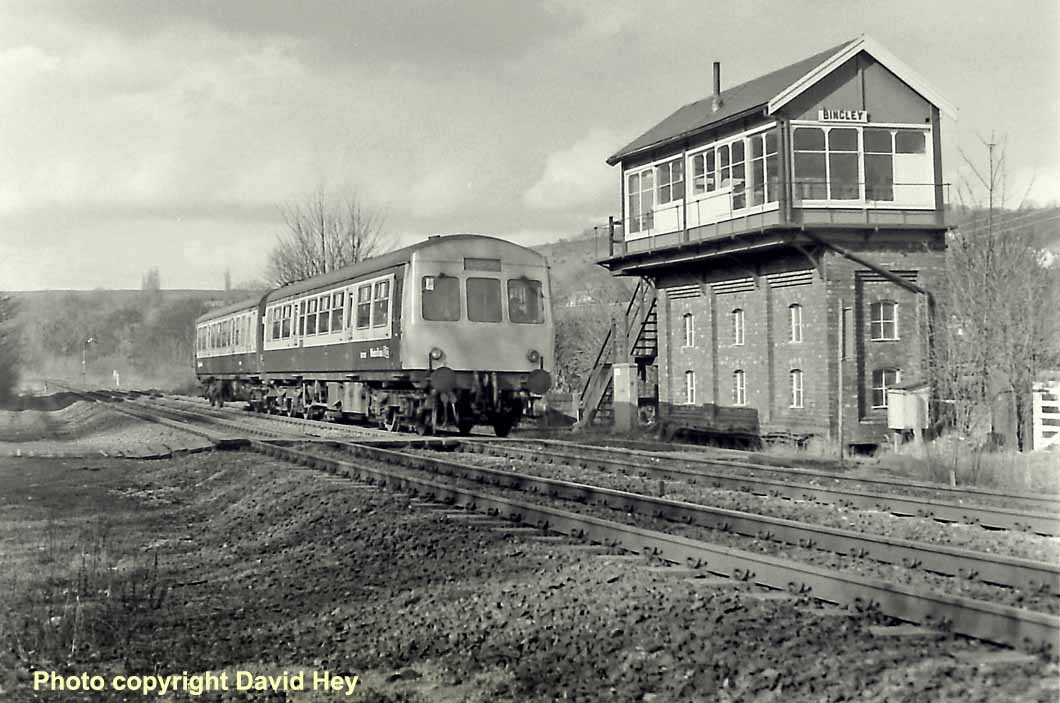
(Above-Below) Perhaps the following shots will be of interest to the discerning modeller. A 2-car Metro-Cammell dmu rattles past Bingley signalbox on the Skipton-Bradford Forster Square service on 18th March 1983. With the exception of Bingley, the MR boxes on the Aire Valley Line were constructed wholly of timber and had 'hipped' roofs (sloping on all four sides). (Below) This is the view of the opposite side; sorry...none taken at the rear. Bingley differed by having a gabled roof (sloping front and back only) and the operating cabin was wider than the brick base, overhanging at the front; it was the newest of the traditional style cabins, replacing two previous boxes at Bingley North and Bingley South. A familiar sight on the Bingley skyline was the Damart factory chimney; the company manufactures thermal clothing. 
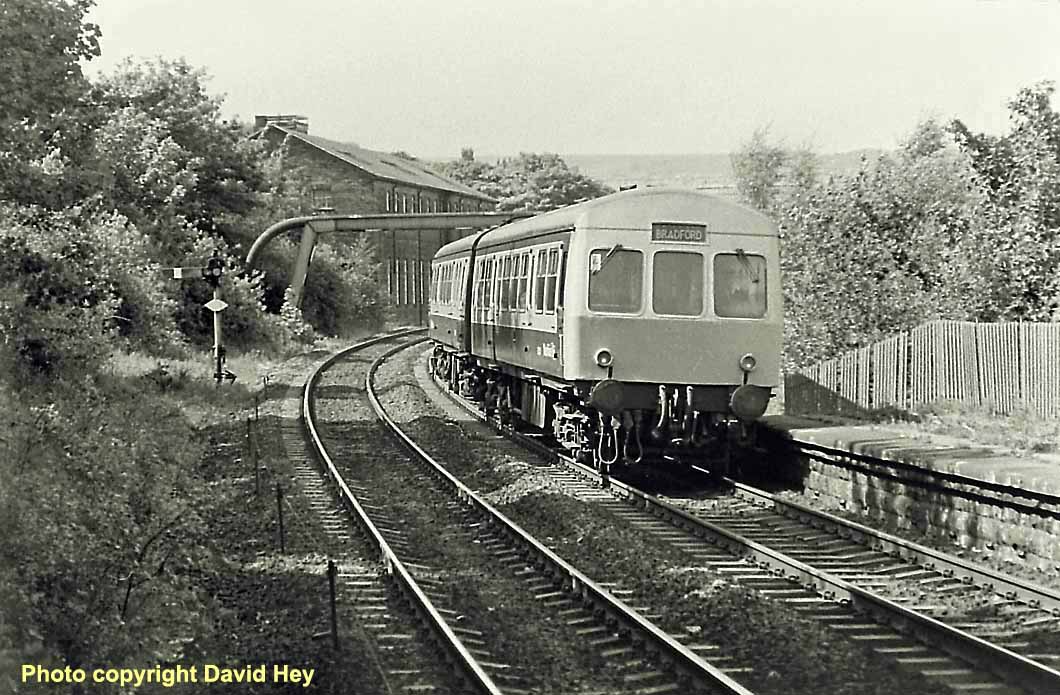
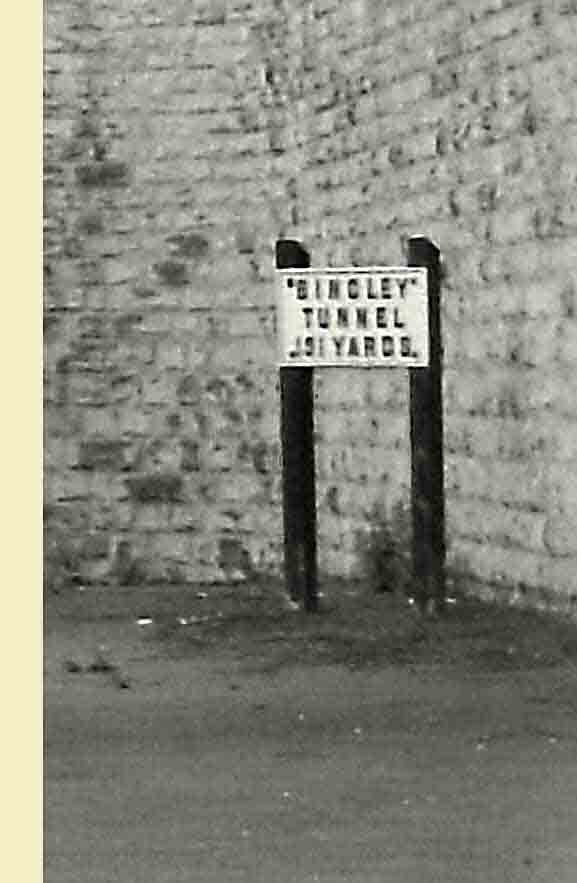 (Above-Inset-Below) Following the rationalisation of running lines and sidings, the number of operating levers at Bingley were reduced from 50 to just five during its final years. Both 'up' main and 'down' main distant signals were colour lights operated by 'cut-down' levers in Bingley box; this was to remind signalmen that no physical effort was required to pull them 'off'. The remaining three signals were semaphores; the one at the Keighley end of the 'down' platform (above) operated as both the 'home' and 'starting' signal. This signal governed entry into the next block section at Keighley Station Junction. In the opposite direction Lever 21 operated the 'Up' main home and No 19 the 'Up' main starter (below) at the entrance to the 151 yard Bingley Tunnel. A familiar lineside feature of the Midland Railway's network of lines was the diagonally-positioned notice boards at tunnel entrances (inset right) which informed engine crew of the name and length, in this case Bingley Tunnel - 151 Yards.
(Above-Inset-Below) Following the rationalisation of running lines and sidings, the number of operating levers at Bingley were reduced from 50 to just five during its final years. Both 'up' main and 'down' main distant signals were colour lights operated by 'cut-down' levers in Bingley box; this was to remind signalmen that no physical effort was required to pull them 'off'. The remaining three signals were semaphores; the one at the Keighley end of the 'down' platform (above) operated as both the 'home' and 'starting' signal. This signal governed entry into the next block section at Keighley Station Junction. In the opposite direction Lever 21 operated the 'Up' main home and No 19 the 'Up' main starter (below) at the entrance to the 151 yard Bingley Tunnel. A familiar lineside feature of the Midland Railway's network of lines was the diagonally-positioned notice boards at tunnel entrances (inset right) which informed engine crew of the name and length, in this case Bingley Tunnel - 151 Yards. 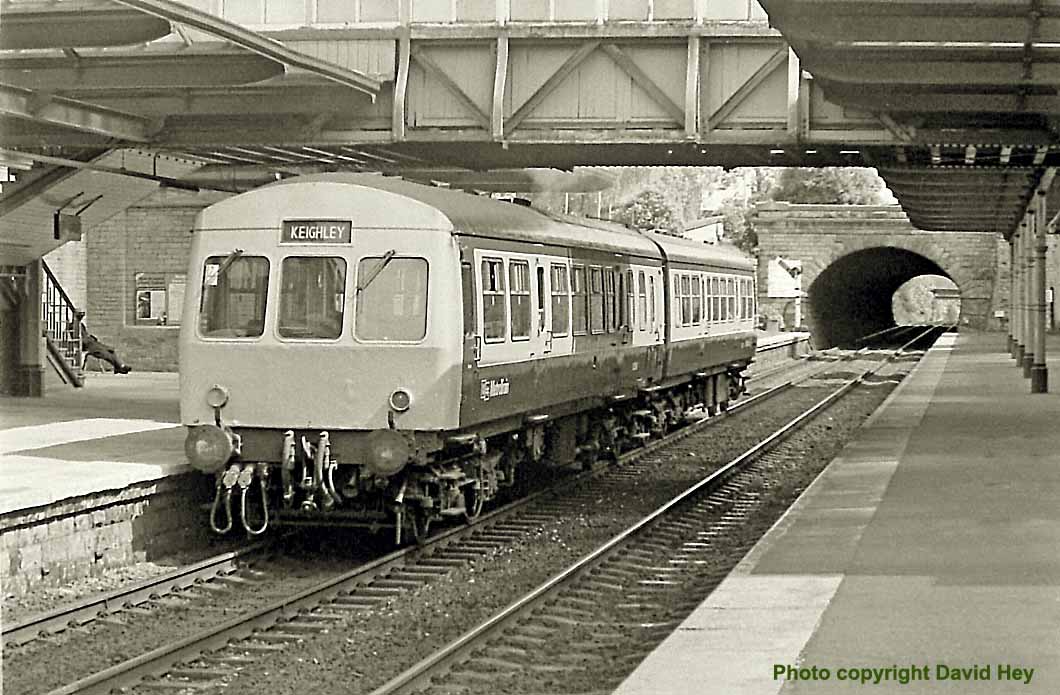
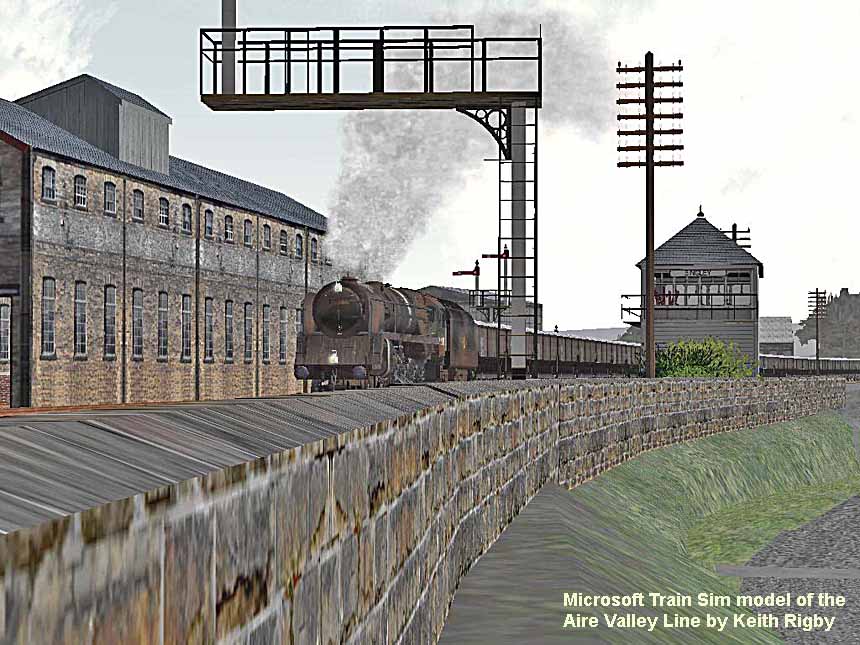
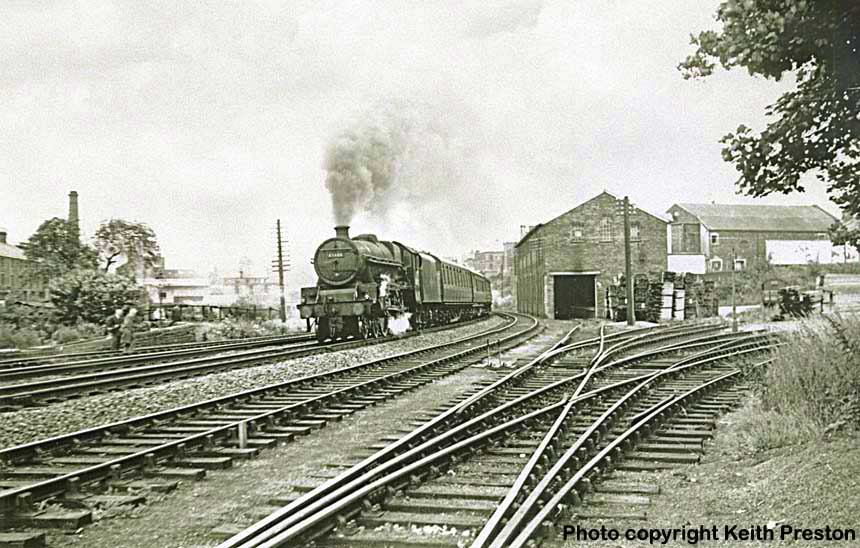
(Above-Below) The naming of steam locomotives is a fascinating subject, especially with the Stanier 5XP 'Jubilee' class. The first, No 5552, was turned out in a gloss-black livery with chromium-plated brightwork and named 'Silver Jubilee' to commemorate the Silver Jubilee of King George V and Queen Mary in 1935. The rest of the 'Jubilees' were named after celebrated heroes and famous ships of the Royal Navy, but the class 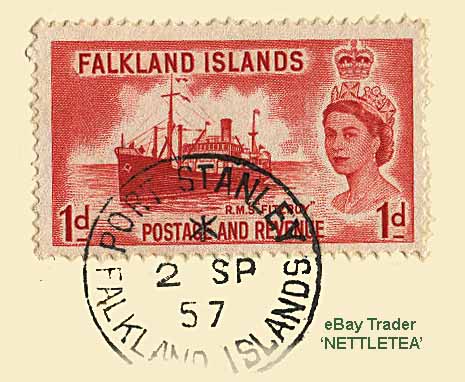 is best known for bearing the names of countries belonging to the British Empire; a poignant reminder of the old Commonwealth countries that have now gone their separate ways. Perhaps the best known British territories are the Falkland Islands. The controversy over Britain reasserting its rule in 1833, led to Argentinean forces invading in 1982; the outcome of the Falklands War then led to a return to British administration, but Argentina's claim to territorial rights is never far away. Here 'Jubilee' class No 45606 Falkland Islands makes a spirited exit from Bingley with a Leeds to Morecambe train; modellers seeking a prototypical solution to cramped baseboard spaces will be interested in the complex pointwork leading into the goods yard. (Below) The intrusion of the A650 Trunk Road dominates this 2014 shot of a Class 333 emu departing Bingley for Skipton, but the large goods shed remains a prominent feature. The majority of services on the Aire Valley Line use Class 333 units operated by Northern Rail between Leeds, Bradford, Skipton and the Wharfedale Line to Ilkley.
is best known for bearing the names of countries belonging to the British Empire; a poignant reminder of the old Commonwealth countries that have now gone their separate ways. Perhaps the best known British territories are the Falkland Islands. The controversy over Britain reasserting its rule in 1833, led to Argentinean forces invading in 1982; the outcome of the Falklands War then led to a return to British administration, but Argentina's claim to territorial rights is never far away. Here 'Jubilee' class No 45606 Falkland Islands makes a spirited exit from Bingley with a Leeds to Morecambe train; modellers seeking a prototypical solution to cramped baseboard spaces will be interested in the complex pointwork leading into the goods yard. (Below) The intrusion of the A650 Trunk Road dominates this 2014 shot of a Class 333 emu departing Bingley for Skipton, but the large goods shed remains a prominent feature. The majority of services on the Aire Valley Line use Class 333 units operated by Northern Rail between Leeds, Bradford, Skipton and the Wharfedale Line to Ilkley.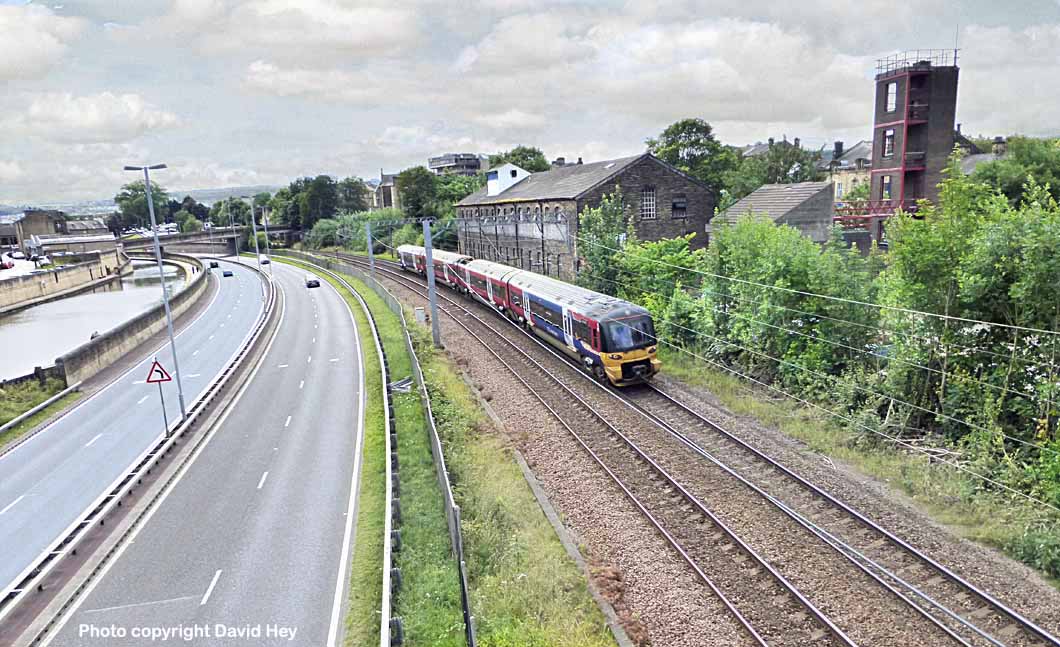
(Below) Sporting a Carlisle Kingmoor (12A) shedplate on the smokebox door, a grimy BR 'Britannia' Class 7MT 70011 Hotspur storms through Bingley with a 'Thames-Clyde Express relief on 29th December 1963. Introduced to traffic in May 1951, 70011 was allocated initially to Norwich Thorpe shed (32A), where the engine served for a little over ten years until 10th September 1961, giving very good service to the Great Eastern section. March depot (31B) in Cambridgeshire was the locomotive's next venue for just over two years until December 1963, then arriving the same week as many classmates at Carlisle Kingmoor MPD (12A), the ultimate destination for the majority of the Britannias. Although the engine was reallocated to Carlisle Upperby depot (12B) from March 1965 until early December 1966, 70011 returned to Kingmoor to complete its service, lasting just another twelve months. Withdrawal took place on 23rd December 1967.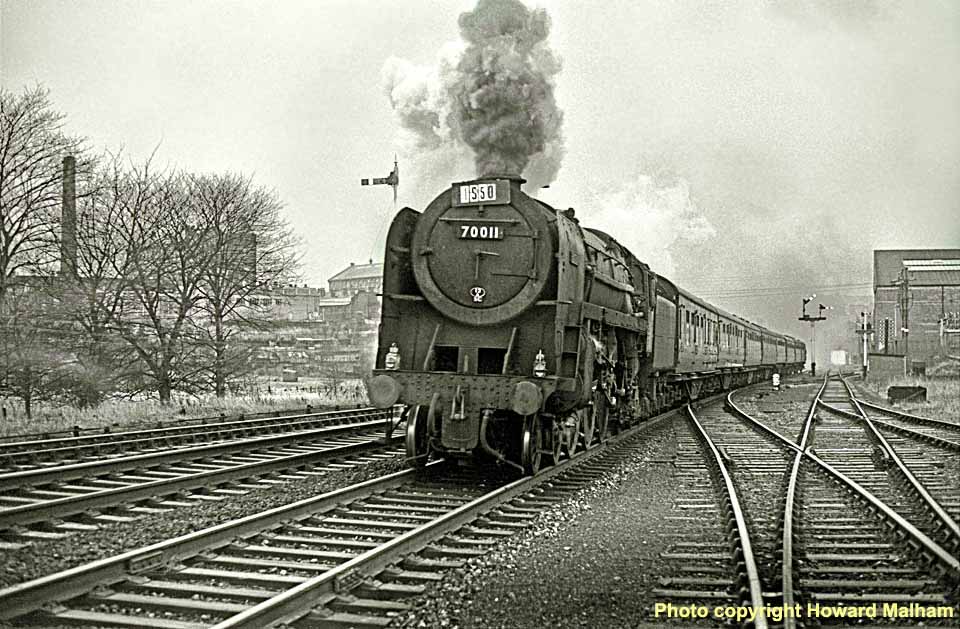
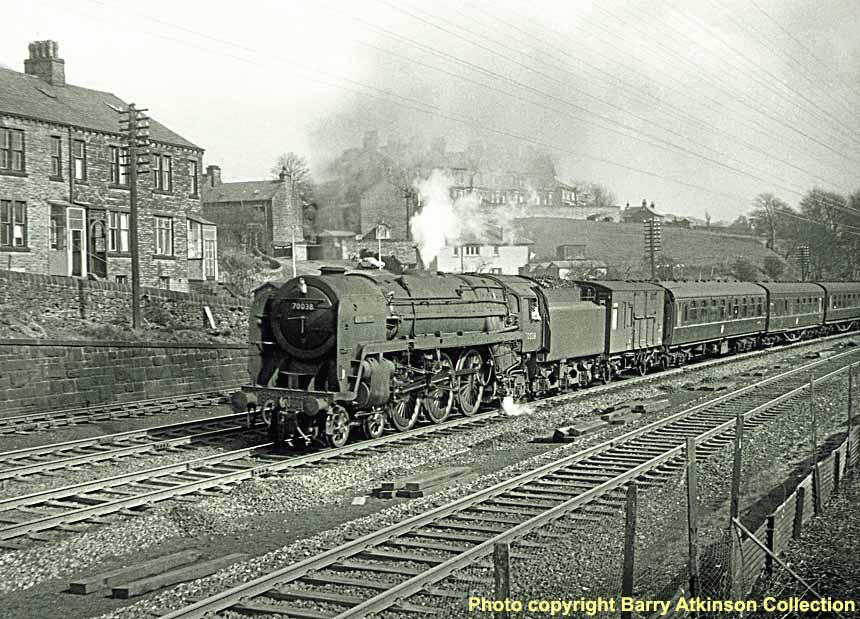
(Above-Below) The Aire Valley Line has been subject to many rationalisations since the 1965 Beeching cuts. Situated some 14½ miles from Leeds and 6½ miles from Bradford Forster Square, both the 'up' and 'down' Goods Lines between Bingley and Thwaites Junction were removed in 1967; indeed much of what you see in this shot of BR Standard Class 7MT 'Britannia' No 70038 Robin Hood heading (what is thought to be the 15.30 Bradford-Carlisle) is barely recognisable today. Not only has the railway infrastructure drastically changed, the houses in the background have now disappeared since construction of the A650 Aire Valley Trunk Road alongside the railway just beyond the wall. (Below) The details of this picture make interesting reading; on 17th March 1965, Howard Malham took this shot of a rather grimy Class 25 No D7587 enroute from Derby to Hellifield with two immaculate MR locomotives and LTSR Thundersley in tow. The antiques were to be stored at Hellfield steam shed alongside other preserved steam locomotives before dispersal to more permanent homes. Although Hellifield shed had been closed for two years, the depot building was still intact with a complete roof and glazed windows, but as a further precaution BR secured all windows and doors with 3" X 2" batons and six inch nails to keep out intruders.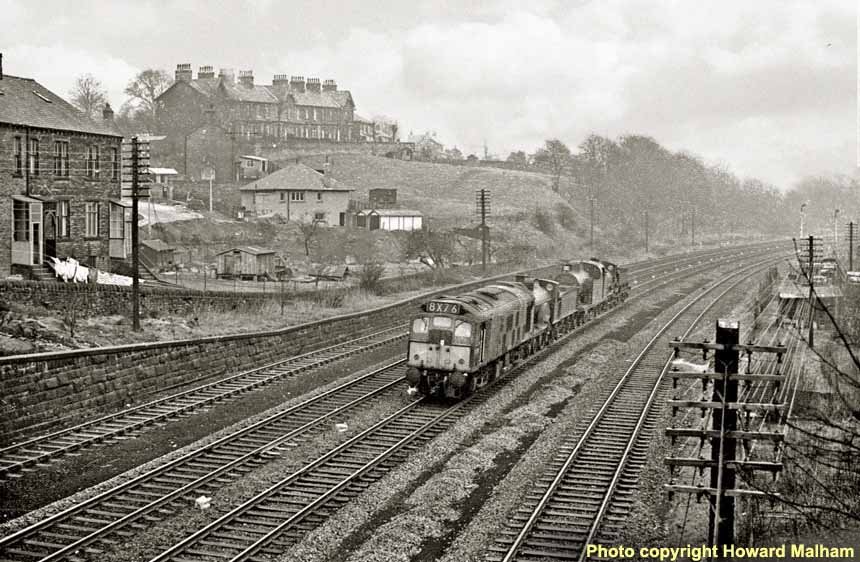

(Above-Below) It is not always easy to take before-after shots from precisely the same spot. Today the dequadrified section of Aire Valley Line just ½ mile from Bingley is occupied by the new Crossflats station. Opened by the WYPTE on 17 May 1982, the station was built on an entirely new site whereas the new stations at Saltaire and Frizinghall occupy the sites of previous stations closed by Beeching in the Sixties. In this view above, construction of the station is well underway as preserved 'Jubilee' class No 5690 Leander heads the 'Trans-Pennine Pullman' on 12 April 1982. (Below) This is the view of the present-day station (August 2014) looking towards Bingley with the A650 Aire Valley Trunk Road on the left. 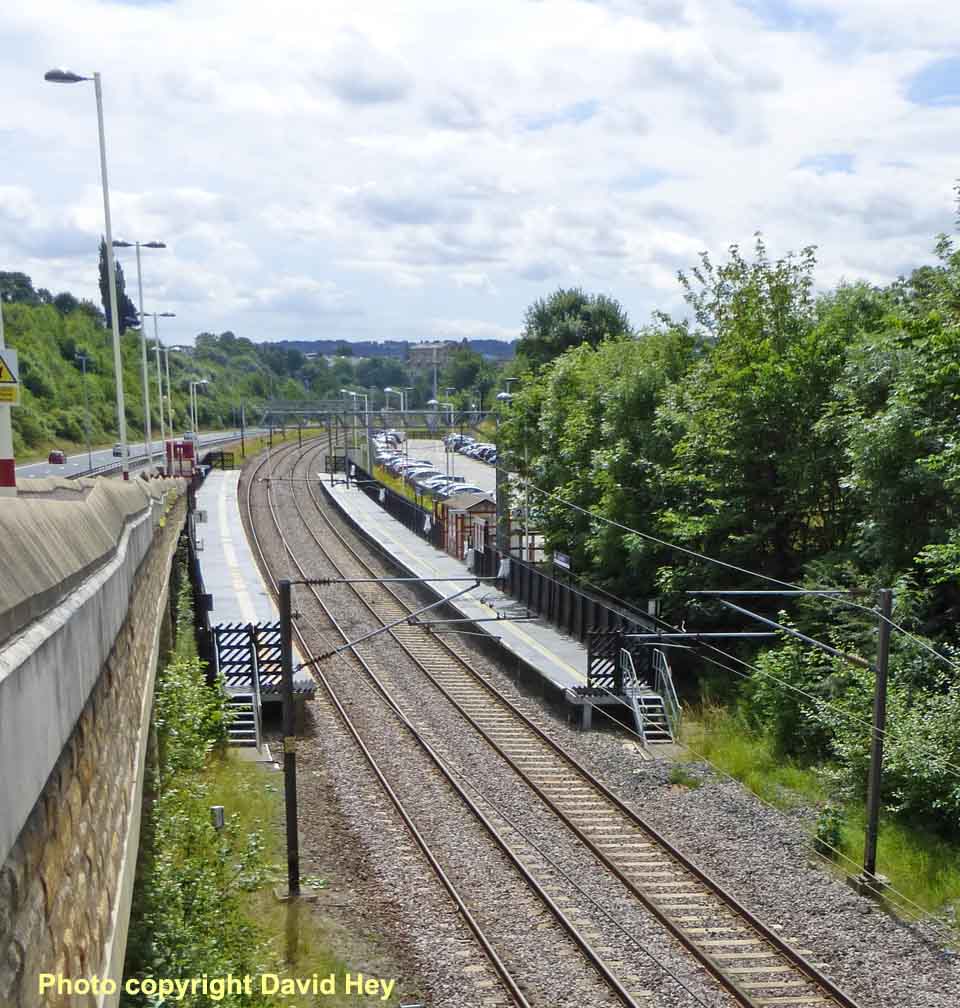
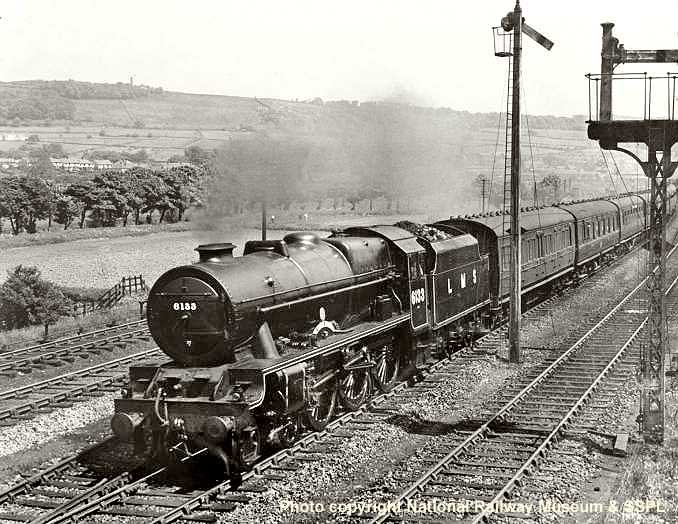
Above-Below) This photograph of Marley Junction appeared in the 1947 ABC Locomotive Series booklets series - 'My Best Railway Photographs No 5' published by Ian Allan - in which Canon Eric Treacy describes his visit to the signalbox on June 28th.
He writes - 'A sweltering afternoon. The section of line I had chosen runs beside a sewerage farm, and - to be quite frank - it stank! Every train was a disappointment: the engines were filthy, the weather was too hot for exhaust, and there was a dreary lack of variety - one class '5' after another. But there came a hail from Scotty Boyle in the near-by signal box: 'What about a cup of tea?' While the kettle boiled we chatted together and found that we were neighbours in the Normandy battle for Caen. Before becoming a signalman he was a bus driver; now his only complaint about his present job was that ever-present sewage farm. Soon I was drinking as good cup of tea as ever came out of a pot. Then with a roar came into sight the 9.55am St Pancras to Glasgow and with a beautifully clean locomotive working hard and making much smoke. It was No 6133 Green Howards, a re-built 'Scot' on which much elbow grease had been expended...'
Okay, it is hardly edifying stuff but it does give you a measure of the great man; indeed in the first paragraph of the booklet he writes: 'However adept I may or may not be at composing sermons, extensive searching of the heart over a period of weeks have failed to produce any new and significant thoughts with which to introduce this fresh collection of photographs...'
It's heartening to know that I'm not the only one straining to find something to say in captions! The locomotive is sporting the black livery with straw lining adopted by the LMS during the Second World War to reduce the cost of regular cleaning. The photo is reproduced courtesy of the NRM's archives. The National Railway Museum in York has a collection of 1¾ million photos covering the history of Britain's railways from 1850 to the present day. The NRM's archives are currently being digitalised to make them  available to a wider audience and preserve them for the future - a visit to the 'Euston Collection' here is highly recommended.
available to a wider audience and preserve them for the future - a visit to the 'Euston Collection' here is highly recommended.
(Inset) There are thousands of great railway websites on the Internet, but perhaps the most interesting are the railwayana auction sites; the wealth of research that goes into describing each lot is quite remarkable! Here we have a locomotive nameplate 'The Green Howards', measuring 51½" long and complete with a replacement brass badge, which went under the hammer at a Sheffield Railwayana Auction in June 2013. No 6133 was built by the North British Locomotive Co (Works No 23628) in 1927. Originally named 'Vulcan' (after the loco built for the Liverpool & Manchester Railway in 1831) the 'Royal Scot' class was renamed in May 1936 after the renowned North Yorkshire based Regiment. The engine was delivered new to Polmadie in September 1927, followed by allocations to Crewe North, Carlisle Upperby, Holbeck, Kentish Town and Newton Heath, from where it was withdrawn on 21 February 1963 and cut up at Crewe Works in May 1963. Click here to visit the fascinating GCR Auctions website.
KEIGHLEY & WORTH VALLEY RAILWAY
by Richard S Greenwood MBE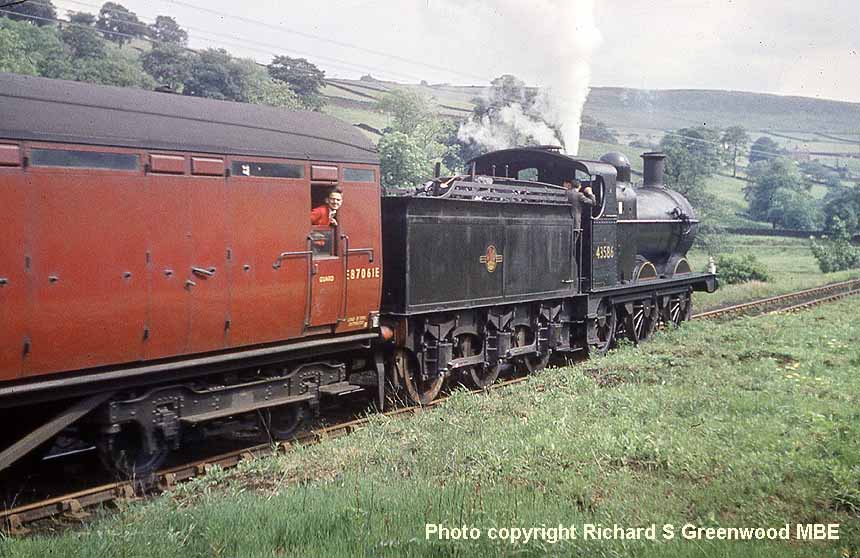
(Above-Below) Keighley station became the junction for a branch to Oxenhope in 1867; this was followed in 1884 with the opening of the GNR line to Bradford Exchange and Halifax via the Queensbury triangle. After closure in 1962, the 4¾ mile-long branch to Oxenhope was rescued by the fledgling KWVR Society and re-opened for passenger services in 1968. Here Manningham Shed's Midland 3F 0-6-0 No 43586 worked the last BR train on the Worth Valley line on 23 June 1962 - a special charter organised by the then embryonic Preservation Society.

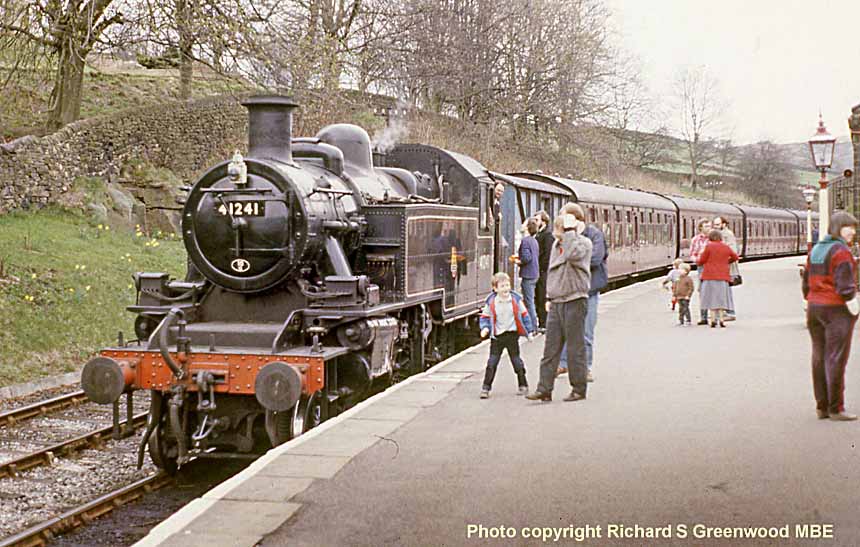
(Above) Introduced in 1946, the Ivatt 2MT Class 2-6-2Ts were widely distributed across the London Midland Region, many being motor fitted for pull-push workings on branch line services. A number went to the North Eastern Region and some to the Southern Region, while others operated in the London area and in 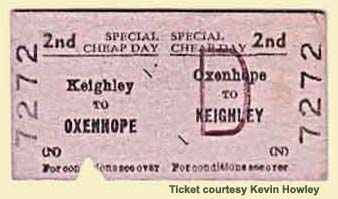 the West Country. Built at Crewe Works in 1949, No 41241 was allocated new to Bath Green Park shed (71G) on the SR. This was followed by spells at Wellington (84H); Leamington Spa (2L); Bangor (6H) Croes Newydd (6C) and Llandudno Junction shed (6G), before ending her BR working days at Skipton (10G) in 1965. Following withdrawal in December 1966, 41241 arrived under her own steam for preservation at the KWVR, an appropriate destination for the locomotive, as the Ivatt 2-6-2T was one of the class which worked the branch in BR days. No 41241 had the distinction of hauling the re-opening special in June 1968.
the West Country. Built at Crewe Works in 1949, No 41241 was allocated new to Bath Green Park shed (71G) on the SR. This was followed by spells at Wellington (84H); Leamington Spa (2L); Bangor (6H) Croes Newydd (6C) and Llandudno Junction shed (6G), before ending her BR working days at Skipton (10G) in 1965. Following withdrawal in December 1966, 41241 arrived under her own steam for preservation at the KWVR, an appropriate destination for the locomotive, as the Ivatt 2-6-2T was one of the class which worked the branch in BR days. No 41241 had the distinction of hauling the re-opening special in June 1968.
(Below) The Class 25 'Ironclad' 0-6-0 was designed by Barton Wright as the standard good engine for the Lancashire and Yorkshire Railway. No 957 (later BR No 52044) was among the final batch of 50 locomotives built at the Beyer Peacock's Manchester Works in 1887. Following withdrawal by British Railways the locomotive was privately purchased in 1959 and moved to KWVR in 1965 where it became famous for its role as the 'Green Dragon' in The Railway Children film. By 1975 No 52044 was in need of a major overhaul and spent a significant amount of time on display at Oxenhope museum. The locomotive returned to service in 2001 as No 52044 and is seen here departing Oakworth station sporting BR black livery; the loco reverted to its L&Y guise of No 957 a couple of years later. 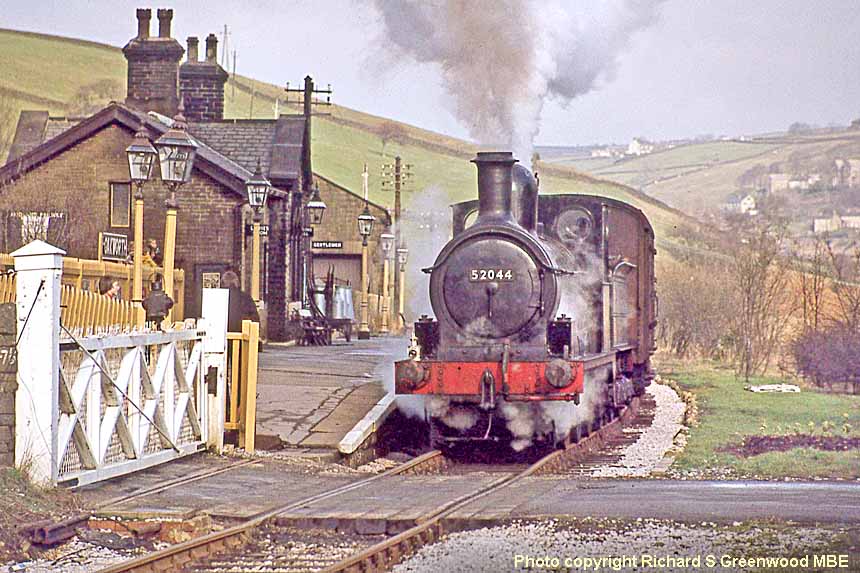
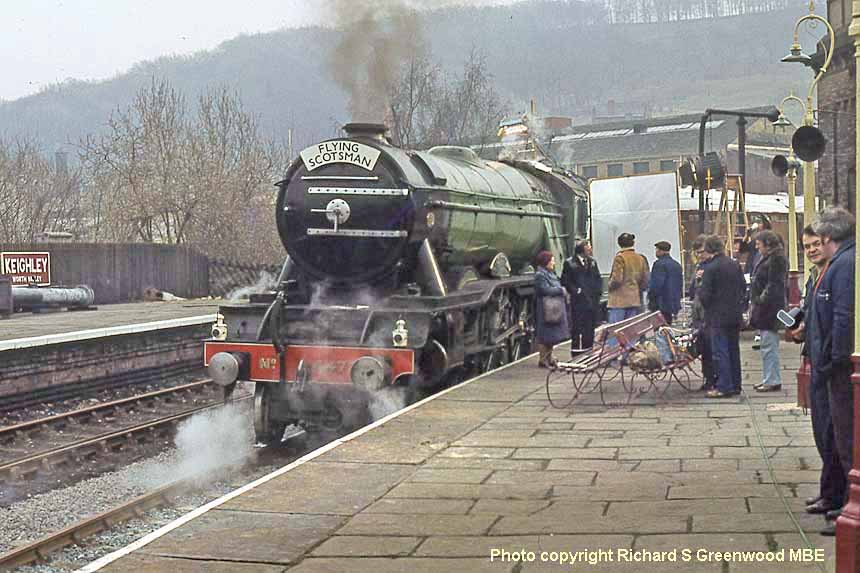
(Above-Below) There's no mistaking the classic lines of Gresley Class A3 Pacific No 4472 Flying Scotsman - arguably the most famous steam locomotive in the world - seen here earning a crust during the filming of a Hovis advert at Keighley KWV station. (Below) Staying with the big boys, the Bullied Light Pacific was 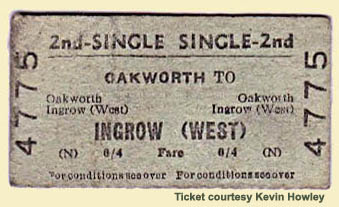 essentially a scaled-down version of the earlier 'Merchant Navy' class introduced in 1941. The new engines were named after cities, towns and tourist spots in south-west England, and became known as the 'West Country' class, whereas later examples had wartime commemorative names, mostly taken from RAF Squadrons associated with the Battle of Britain. Here, 'West Country' class No 34092 City of Wells (built at Brighton in 1949 - preserved in 1971) is ready to depart Oxenhope adorned with Golden Arrow regalia, unusually facing downhill. No 34092 was among the final batch of 20 West Country Class locomotives ordered, and during its time based at Stewarts Lane (73A) was often called upon to haul the Golden Arrow service. Today, no fewer than 20 have been preserved, nine of them in unrebuilt condition, which is a fitting tribute to the Bulleid design.
essentially a scaled-down version of the earlier 'Merchant Navy' class introduced in 1941. The new engines were named after cities, towns and tourist spots in south-west England, and became known as the 'West Country' class, whereas later examples had wartime commemorative names, mostly taken from RAF Squadrons associated with the Battle of Britain. Here, 'West Country' class No 34092 City of Wells (built at Brighton in 1949 - preserved in 1971) is ready to depart Oxenhope adorned with Golden Arrow regalia, unusually facing downhill. No 34092 was among the final batch of 20 West Country Class locomotives ordered, and during its time based at Stewarts Lane (73A) was often called upon to haul the Golden Arrow service. Today, no fewer than 20 have been preserved, nine of them in unrebuilt condition, which is a fitting tribute to the Bulleid design.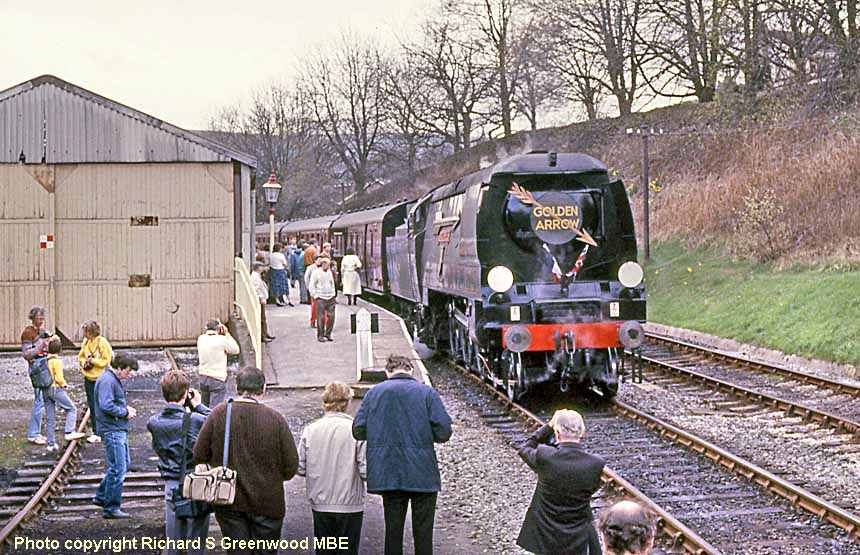
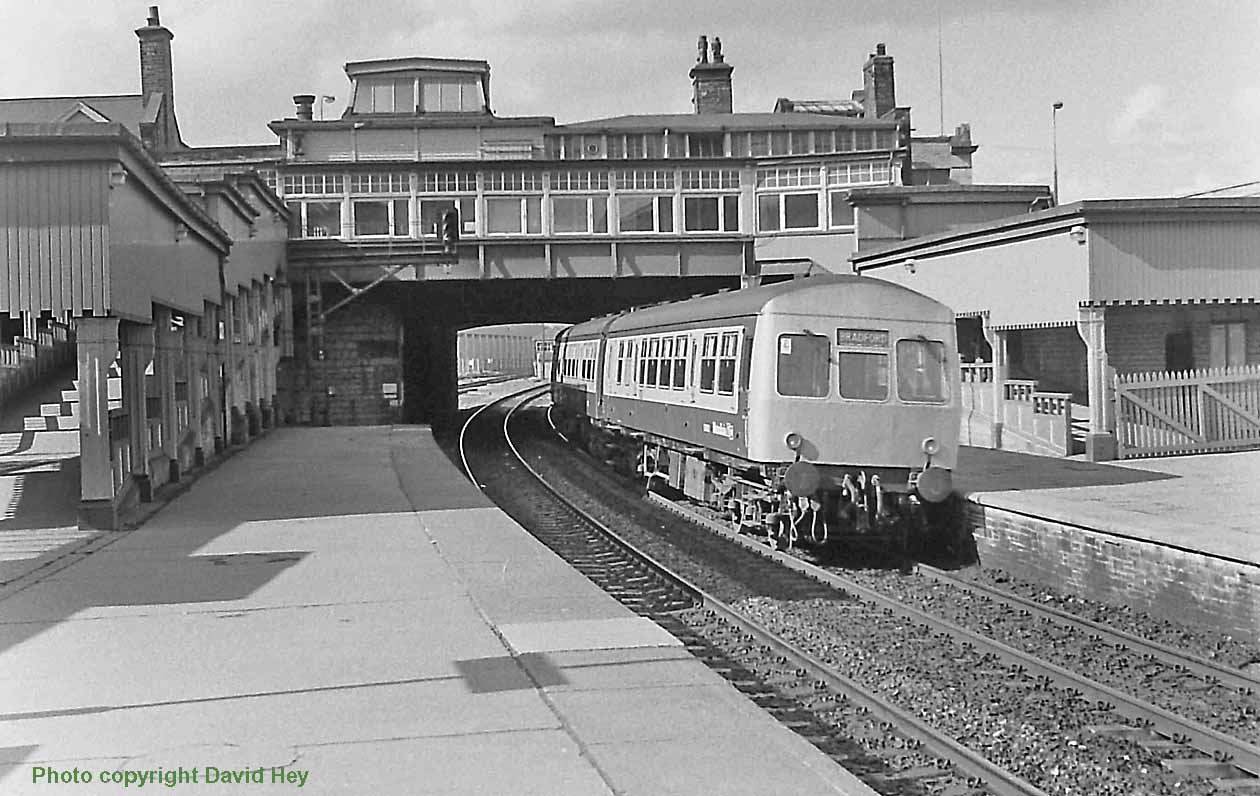
(Above-Inset-Below) Putting together this website has been a rewarding experience because it gives me chance to revive memories the Fifties and Sixties. However, there are times when you can become so blinkered by events in the past that you rarely stray beyond a rose-tinted perspective of the Sixties; this might be popular with 'oldies' like myself, but there is a whole new generation of enthusiasts out there who view the current railway scene in a more upbeat mood; the last thing they need is some patronising old geezer imposing  ideological 'hippy' ideals about steam days.
ideological 'hippy' ideals about steam days.
So I was happy to meet up with Phil Hodgetts at Keighley station, a place I last visited during a photo reconnaissance in the 1980s (above). It was Phil who brought me up to date on train services at Skipton. Currently there is a train movement on average every 5 or 6 minutes. The Leeds trains depart at 20 minute intervals, and in between these are the departures of the Bradford trains at 20 minute intervals. Both services are spaced 10 minutes apart. In between these locals are the trains to Morecambe and Carlisle; Phil advised me that the 'limited stop' afternoon train from leeds to Morecambe provides an advantageous gap in the passenger timetable for the Rylstone train to follow. Sure enough, no sooner had Phil spoken and a Class 66 (inset) powered through Keighley station, and not too many minutes later another Class 66 (below) loomed into view on the 'up' line - an altogether impressive sight, even for a hard-nosed steam nut!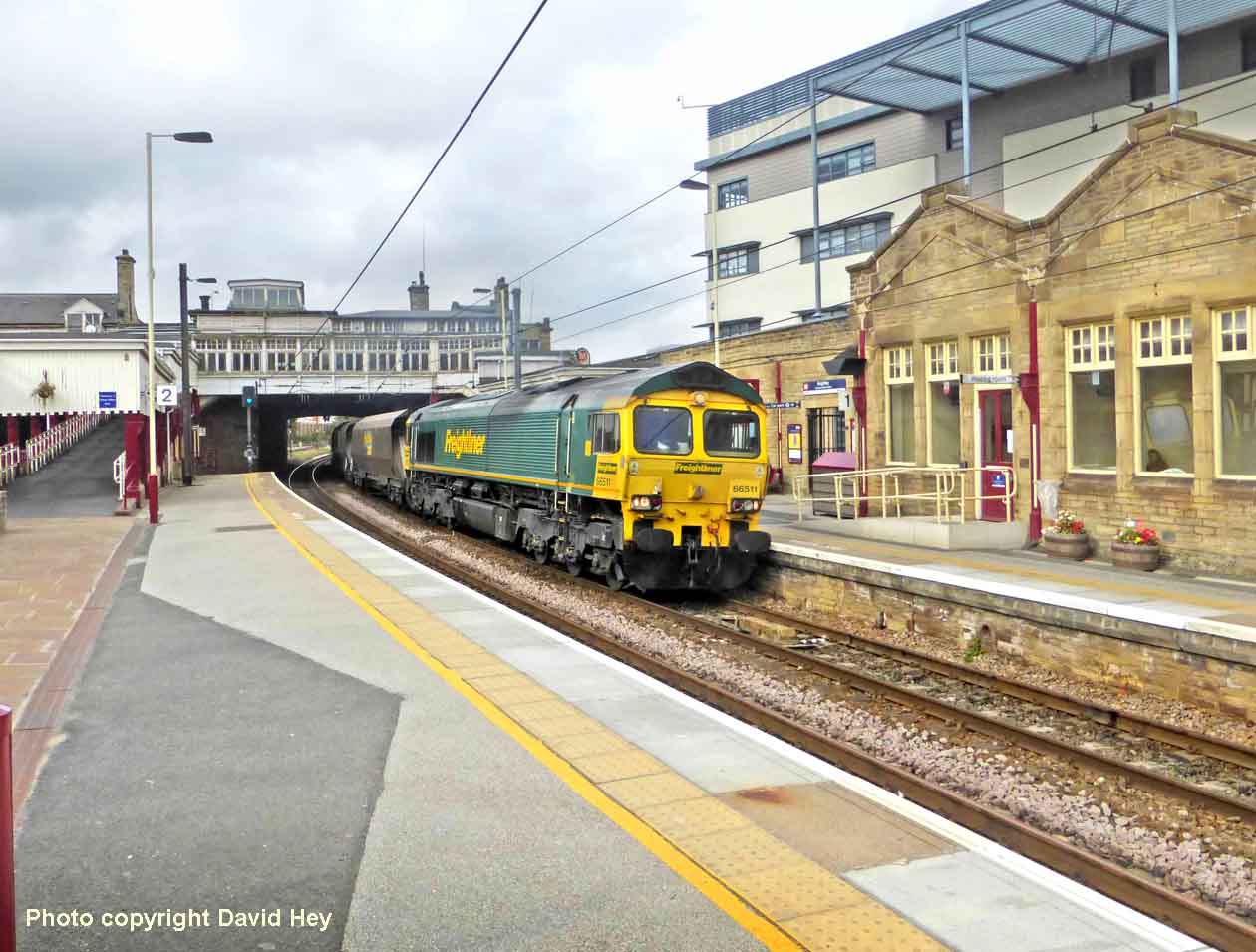
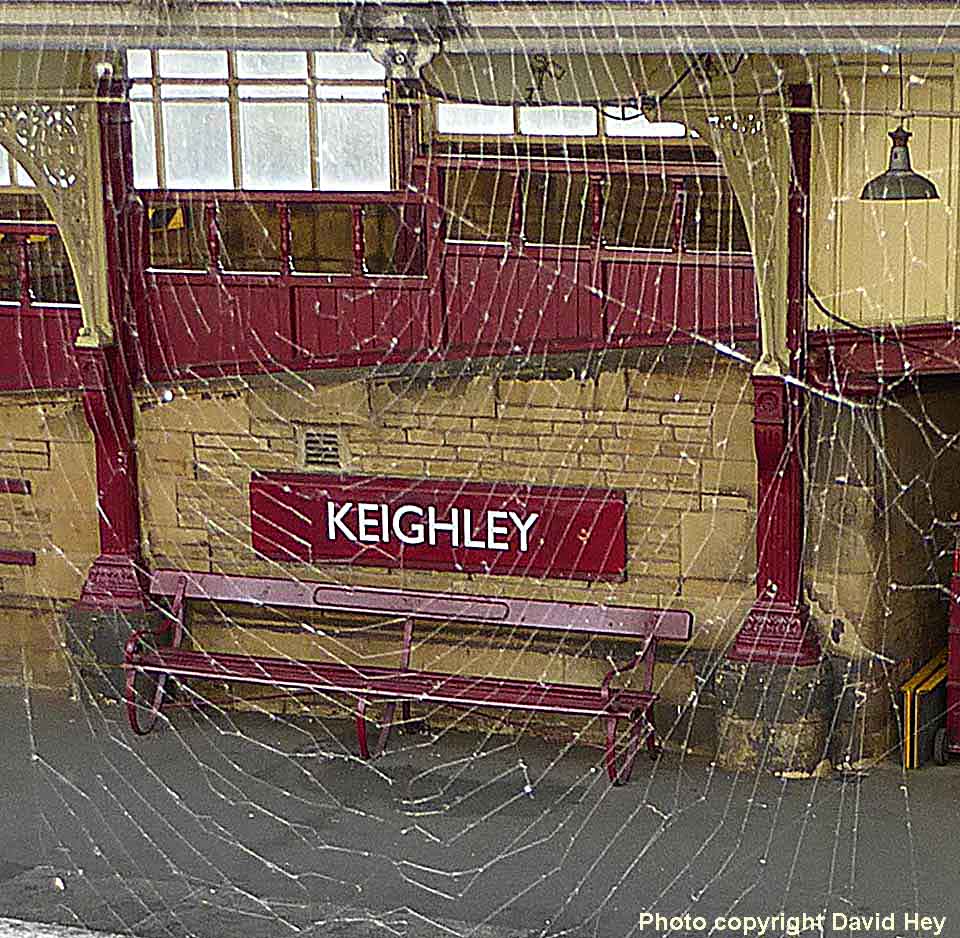
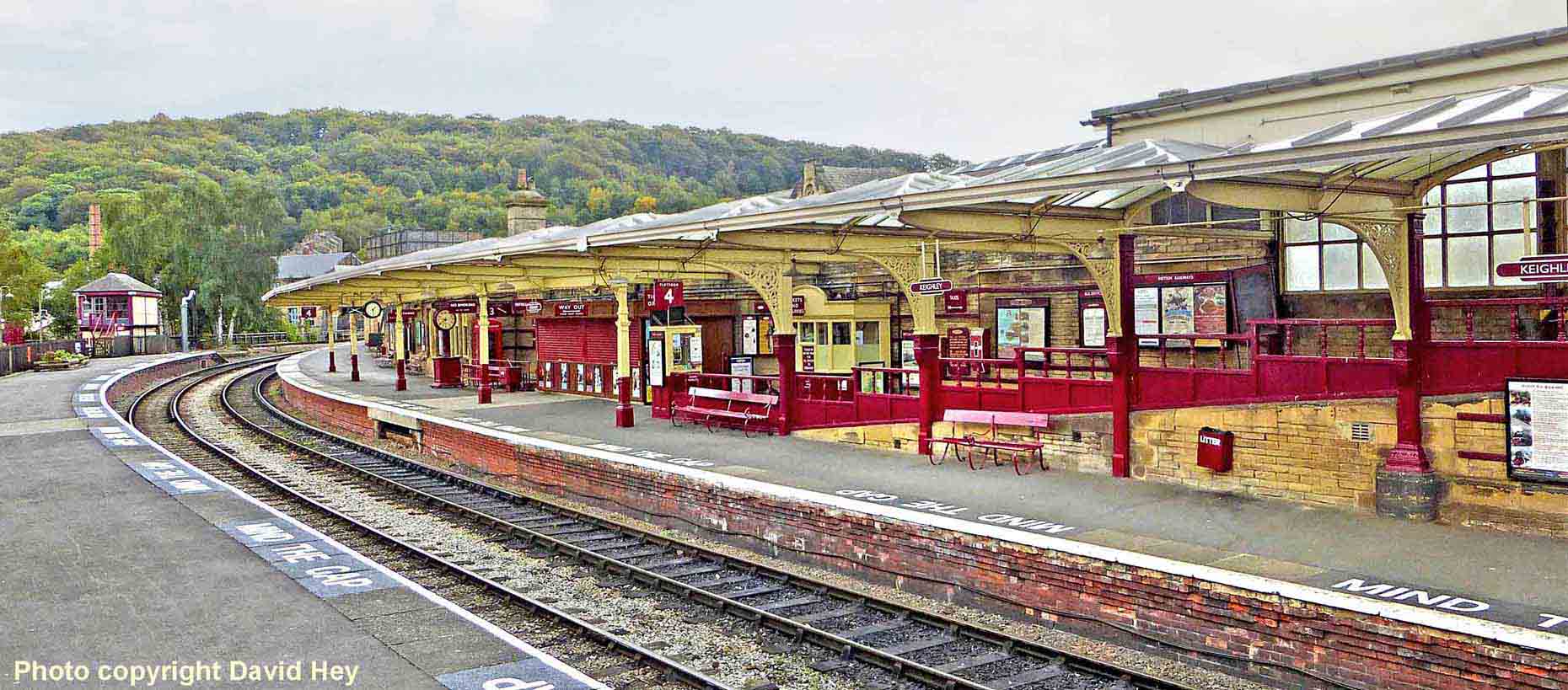
(Above-Below) Although Keighley station has retained many of its fine buildings, the difference in the décor of the main line station and the adjoining KWVR terminus is immediately apparent to visitors descending from street level to the platform. It has taken many years of renovation by dedicated KWVR staff to restore the ex-MR canopy and station buildings to their former state, whereas the main line station looks very plain in comparison. Click HERE to visit the KWVR.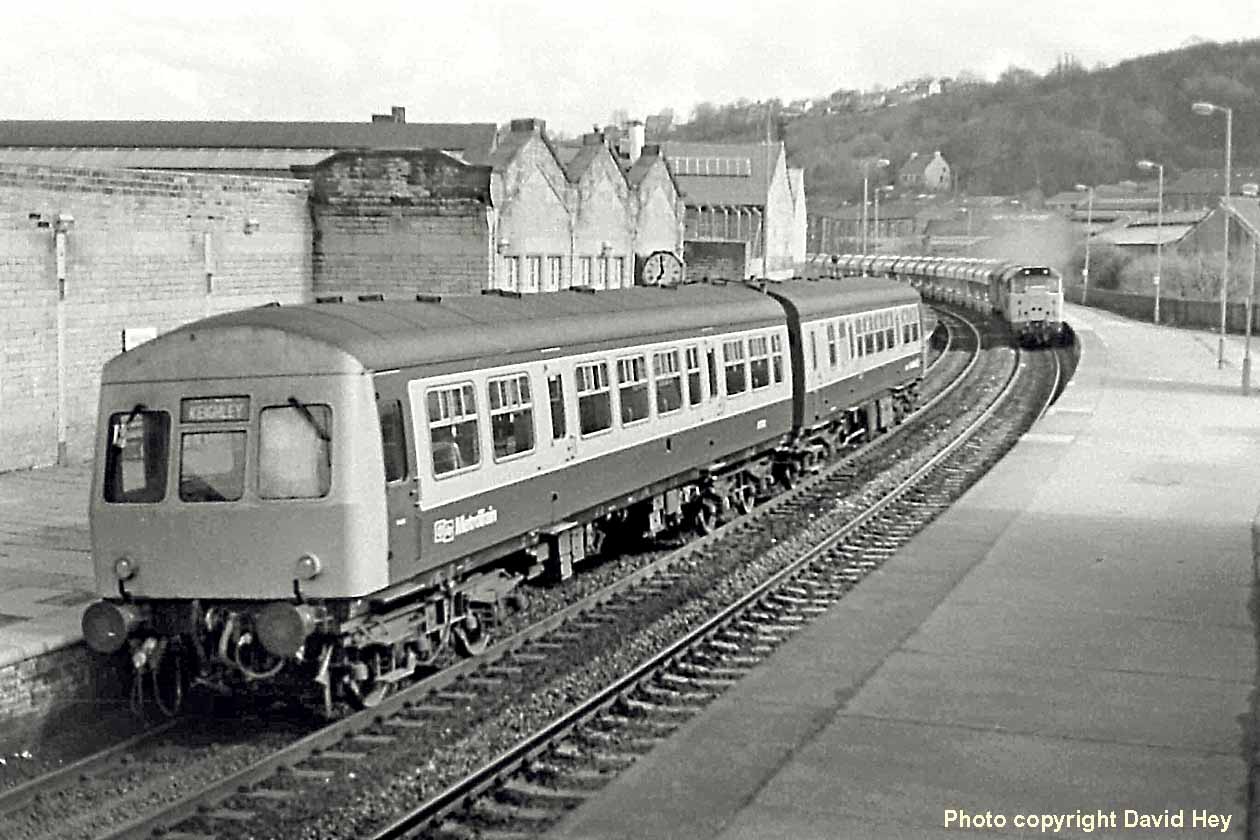
(Above-Below) Successive introductions in 1890, 1898, 1905 and 1910 (this includes both new and rebuilt engines) led to 330 L&YR 2-4-2 'Radial Tank' class locomotives in various sub-classes due to different weights, cylinder sizes, coal capacity, tank size and tractive efforts. Aspinall's 2-4-4T No 50636 was built at Horwich Works in June 1890 with smaller cylinders and 2 tons coal capacity; the 1898 rebuilds had longer tanks and extended coal bunkers of 4 tons capacity. When Hughes took over at Horwich in 1904 he was responsible for rebuilding the 2-4-2Ts with Belpaire fireboxes and extended boilers. Here, a Manningham locomotive for much of its life, No 50636 awaits departure from Keighley with the 13.30 Bradford-Skipton in September 1955. Withdrawn in July 1957, the engine was cut up at Horwich. 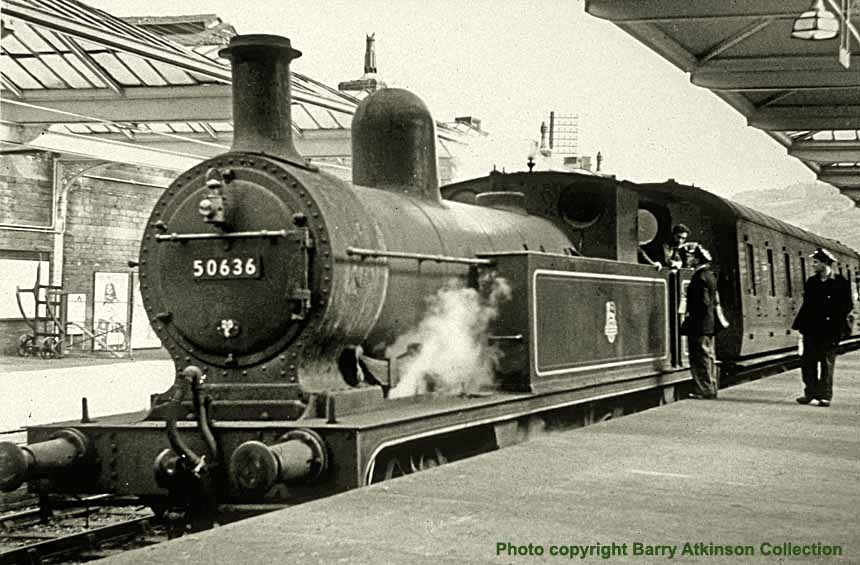
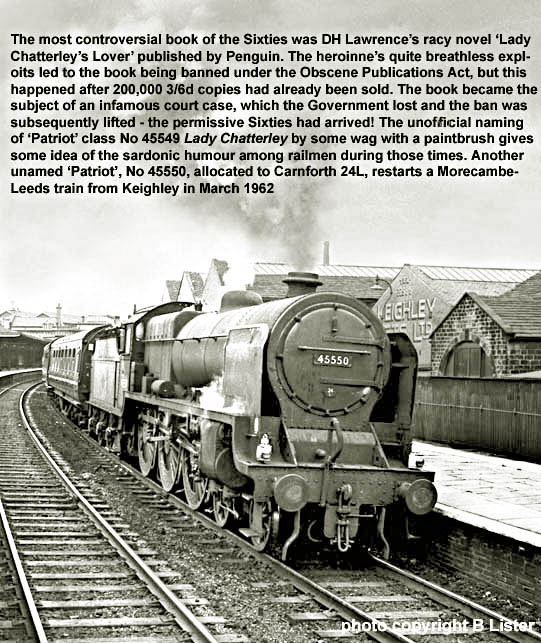
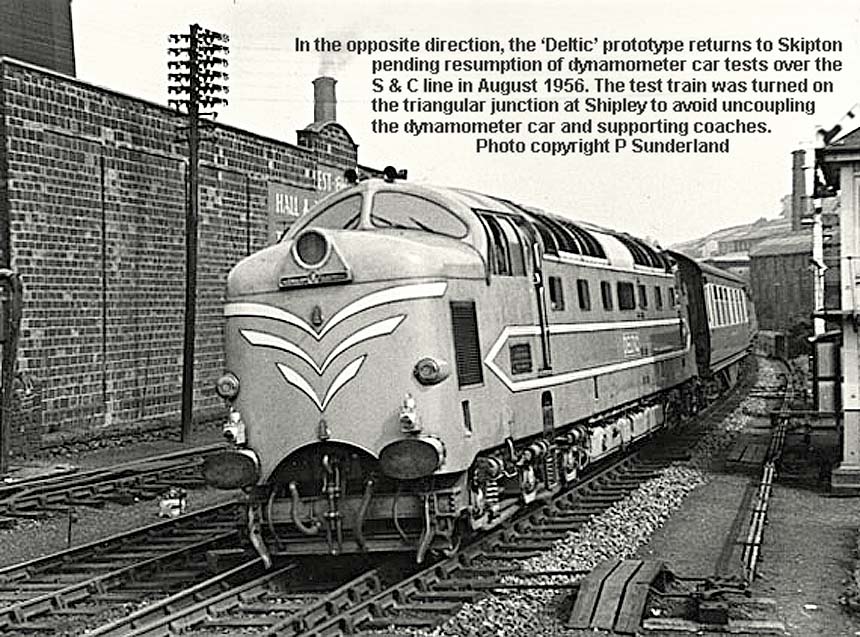
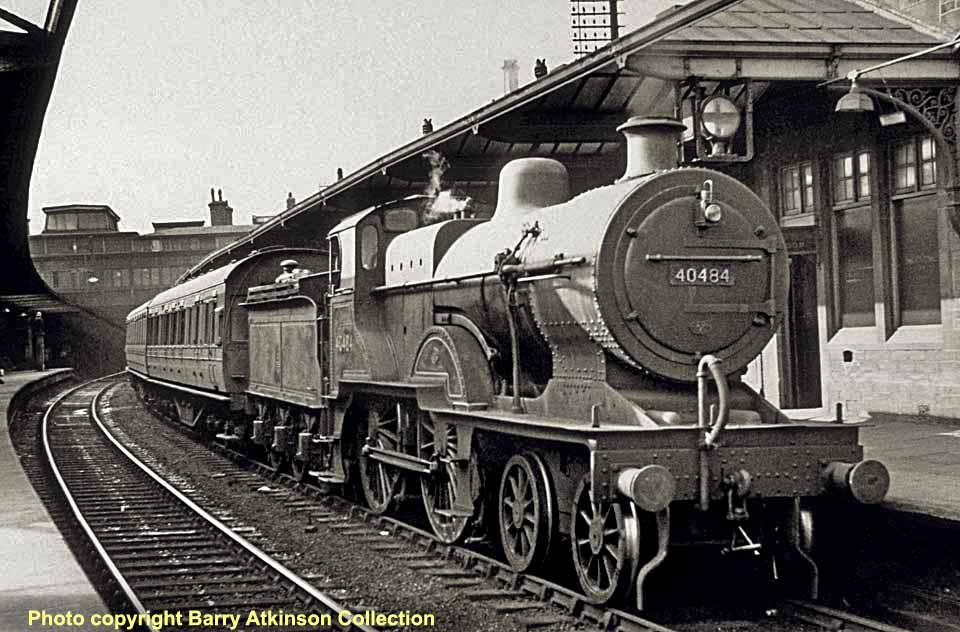
(Above) Another old timer captured at Keighley is Class 2P No 40484 seen here arriving at the 'up' main platform in September 1955. Built at Derby Works in December 1896, Samuel W Johnson's original Midland 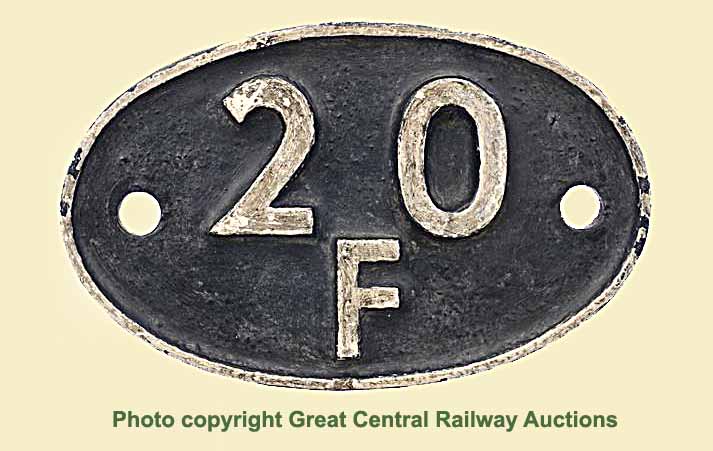 Railway 483 Class 4-4-0 was designed for passenger work on the Midland Railway, and later formed the basis for the LMS Class 2P 4-4-0 (introduced in 1928). No 40484 was among the locomotives rebuilt by Fowler with superheater in 1912; the Stephenson valve gear was retained but the 18" X 26" cylinders with slide valves were replaced by 20½" X 26" cylinders with piston valves, and the 6' 6½" driving wheels were replaced by 7' 0½" driving wheels. The engine is sporting a Skipton (20F) shedcode (see inset). This 20F shedplate went under the hammer for £180 at a Great Central Railway Auction in January 2012. The ex-MR shed at Skipton was allocated four different codes during a 33-year period; from 1948 to 1950 (20F) - 1950 to 1951 (23A) - 1951 to 1957 (20F) - 1957 to 1963 (24G) - and finally 10G from 1963 up to closure on 30th April 1967.
Railway 483 Class 4-4-0 was designed for passenger work on the Midland Railway, and later formed the basis for the LMS Class 2P 4-4-0 (introduced in 1928). No 40484 was among the locomotives rebuilt by Fowler with superheater in 1912; the Stephenson valve gear was retained but the 18" X 26" cylinders with slide valves were replaced by 20½" X 26" cylinders with piston valves, and the 6' 6½" driving wheels were replaced by 7' 0½" driving wheels. The engine is sporting a Skipton (20F) shedcode (see inset). This 20F shedplate went under the hammer for £180 at a Great Central Railway Auction in January 2012. The ex-MR shed at Skipton was allocated four different codes during a 33-year period; from 1948 to 1950 (20F) - 1950 to 1951 (23A) - 1951 to 1957 (20F) - 1957 to 1963 (24G) - and finally 10G from 1963 up to closure on 30th April 1967.
(Below) This panoramic view of upper Airedale shows the splendid Yorkshire countryside between Keighley and Skipton, though the landscape can change very quickly after a heavy rainfall; the flat valley floor is prone to flooding by the River Aire and a train ride across the open pastureland between Keighley and Skipton is not dissimilar to travelling by ferry.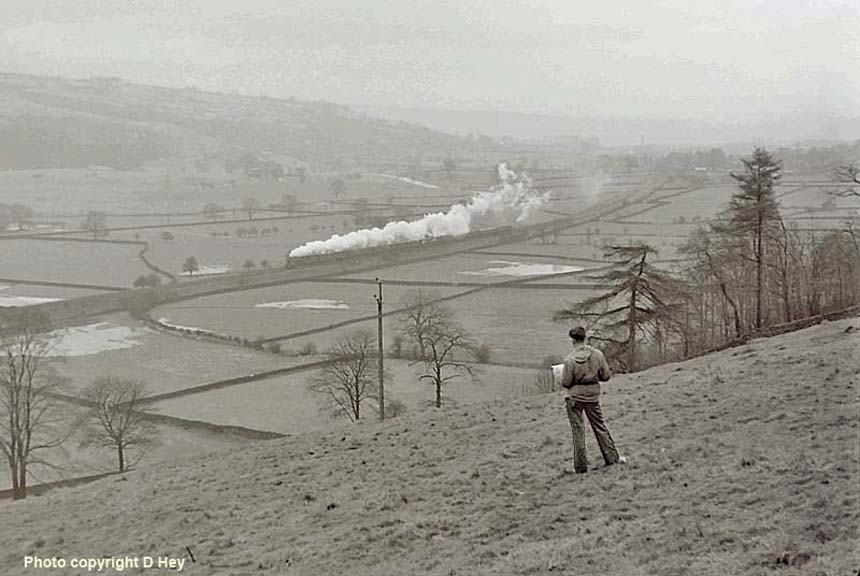
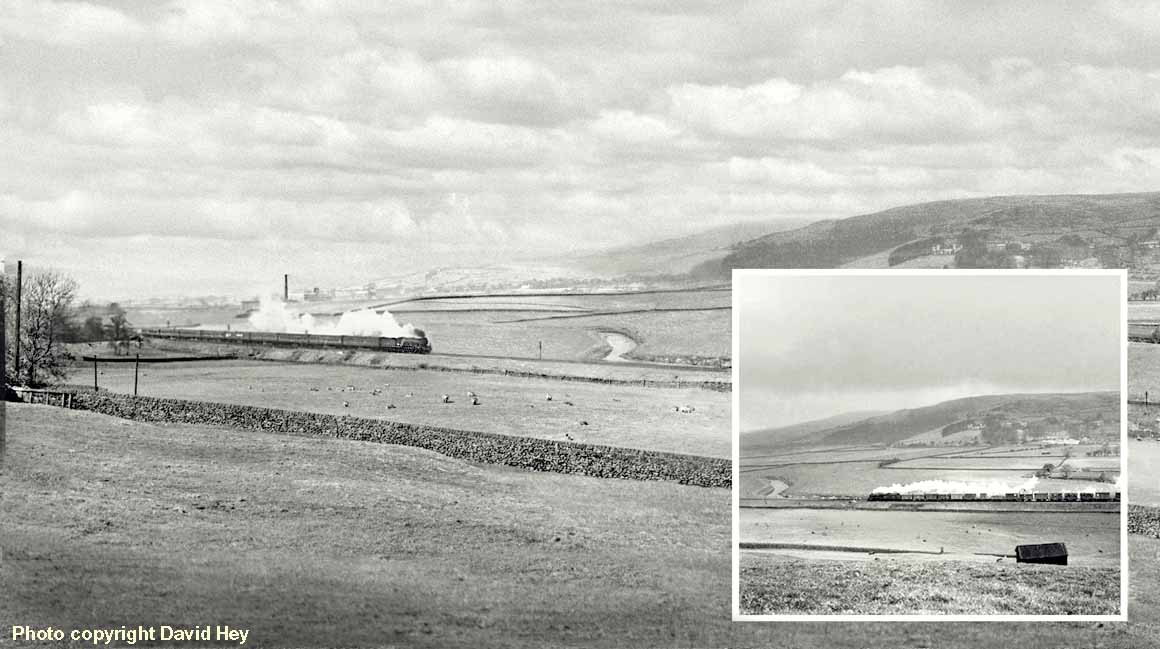
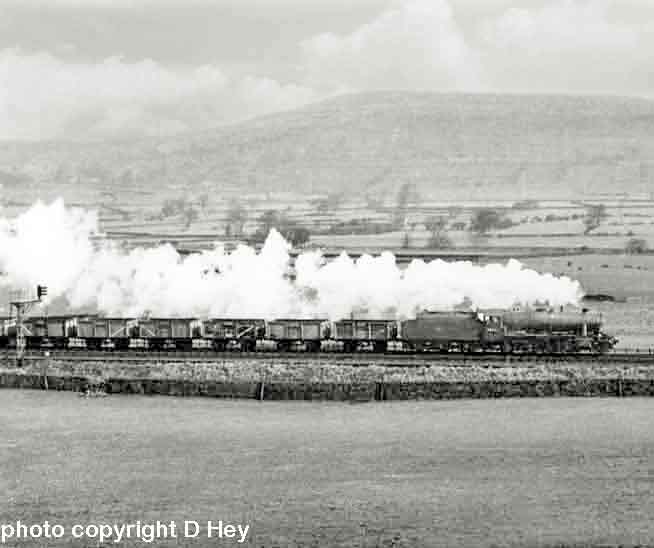
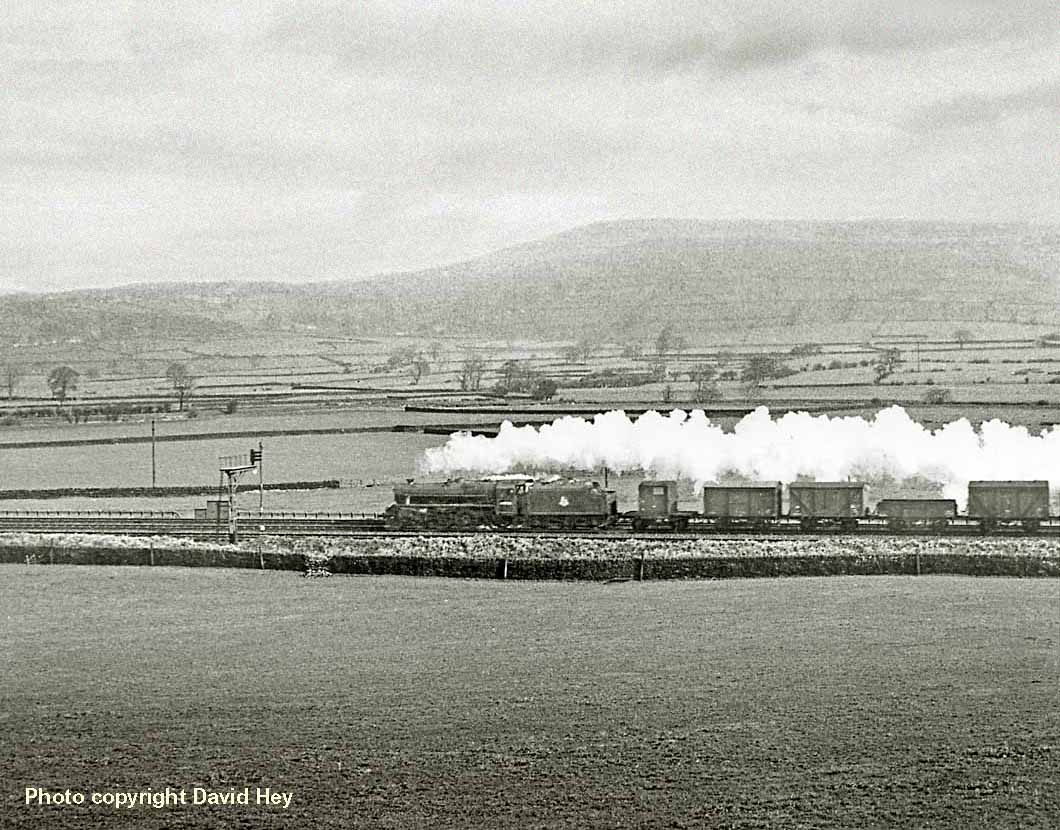
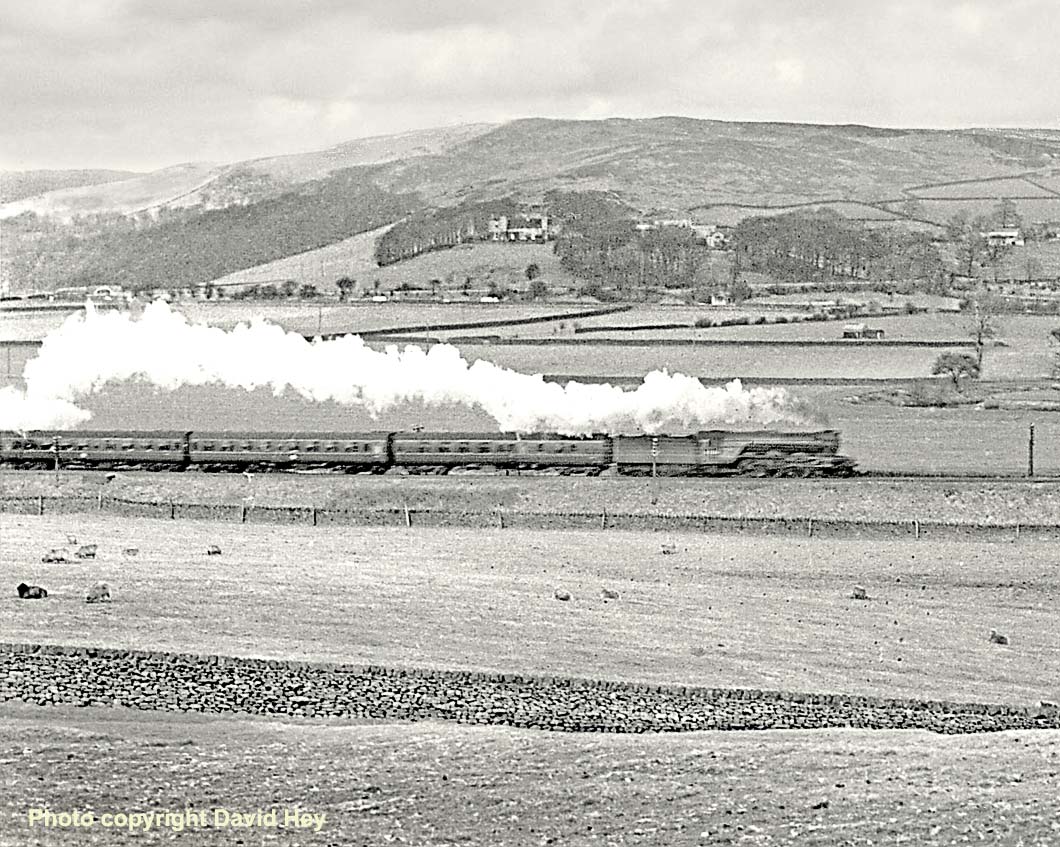
(Above-Below) Class A3 No 60092 Fairway speeds down the valley between Cononley and Kildwick with the southbound 'Thames-Clyde Express' in 1961. (Below) From an elevated position it was a simple task to point the camera and record at random the procession of goods trains as they ambled past. 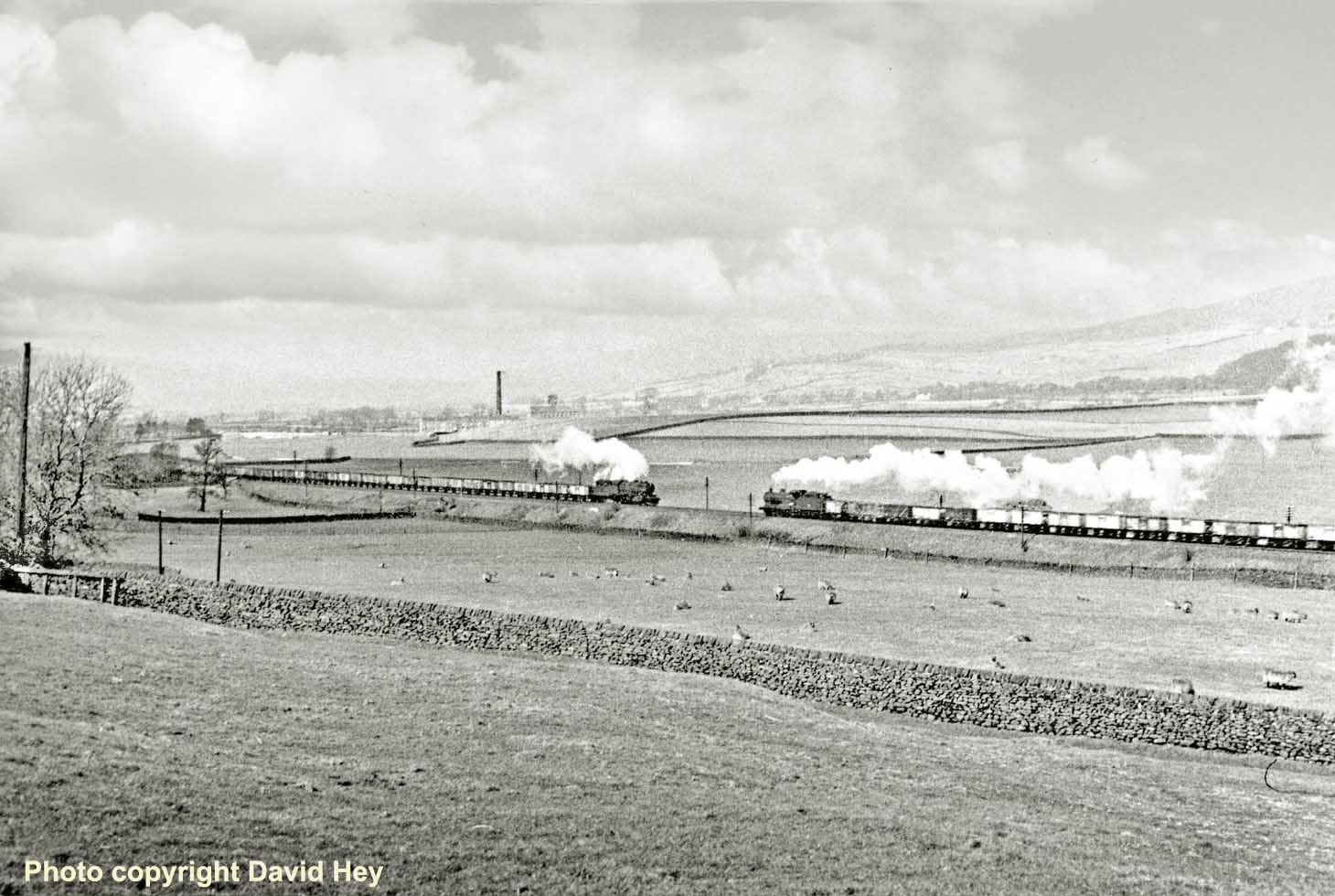
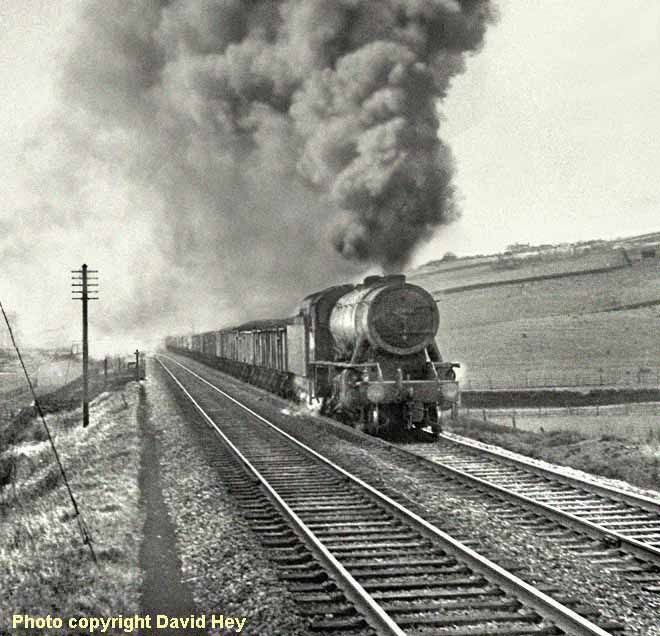
(Above-Below) North British-built WD 2-8-0 No 90056 makes heavy work of a northbound coal train at Cononley in March 1961. The design and construction of the 'WD' (War Department) 2-8-0s was prepared by R.A. Riddles CBE, then Mechanical and Electrical Engineer for Scotland, LMSR, and attached to the Ministry of Supply as Deputy Director General of Royal Engineering Equipment. The first batch of 'WD' Class locos were built by the North British Locomotive Company in 1943 for general war service overseas. This was followed by a second batch constructed at the Vulcan Foundry Ltd, and no fewer than 733 returned for service on BR, with 261 going to the London Midland region, 260 to the ER, 109 to the NER, 49 to the WR and 54 to the ScR. The North British locomotives were numbered 90000-90100 whilst the Vulcan Foundry locomotives were numbered 90422 to 90732 - the last to be built carrying the name Vulcan high up on the cab side. Although built for austerity conditions overseas, these locomotives played a vital role in ordinary freight service on British Railways. (Below) Class 9F..... 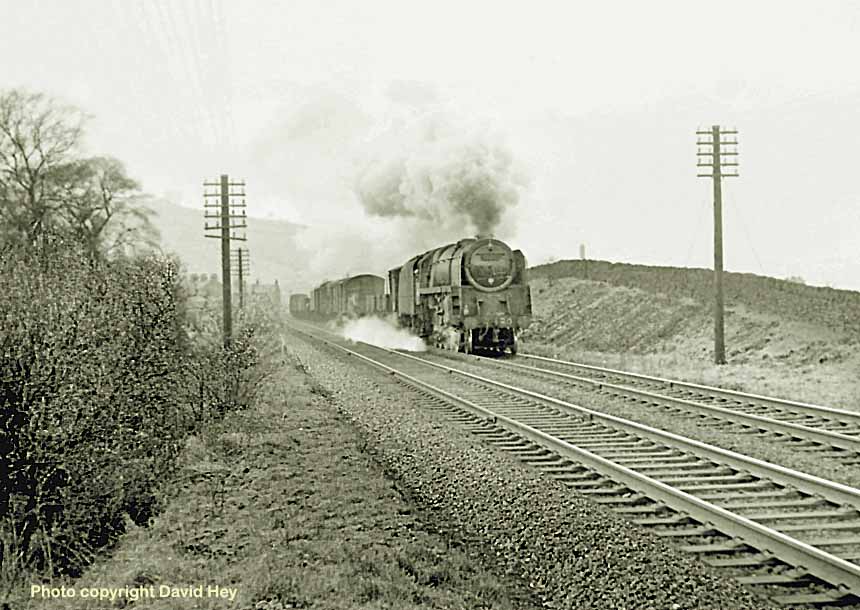
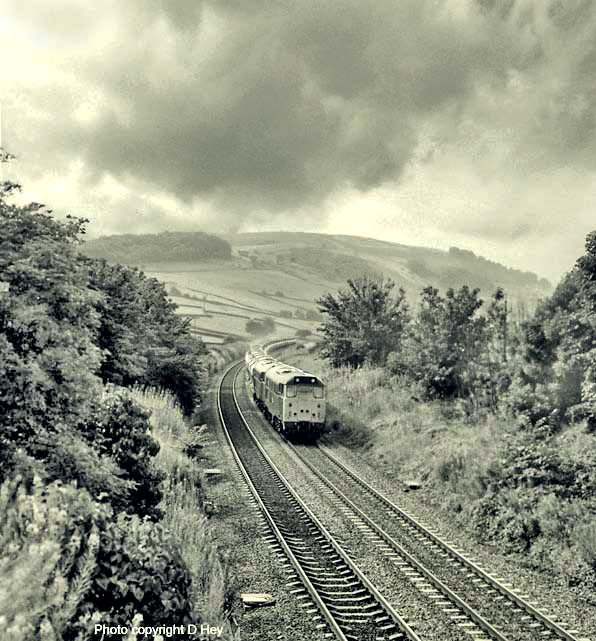
(Above) Fast-forward twenty-odd years and Class 31s 31203 and 31343 are photographed heading down the Aire Valley at Crosshills with the 10.18 Rylstone-Dairycoates Tilcon train in September 1983. The Brush  Type 2s (Class 31s) regularly worked this train in the Eighties. Designed and built by Brush Traction at the company's Loughborough works between 1957-1962, the locomotives were originally equipped with a Mirrlees V8-type 12-cylinder power unit, but due to a number of mechanical and fatigue problems all the production models were re-engined with EE Co units between 1965-69. Under the numerical classification system the original pilot scheme Type 2s fitted with Mirrlees engines were classified Class 30, whilst the production fleet fitted with the revised English Electric power units became Class 31; these were sub-divided to Class 31/0 (fitted with electro-pneumatic control) and Class 31/4 - equipped with electric train heating (ETH) equipment…a standard diesel class my foot!
Type 2s (Class 31s) regularly worked this train in the Eighties. Designed and built by Brush Traction at the company's Loughborough works between 1957-1962, the locomotives were originally equipped with a Mirrlees V8-type 12-cylinder power unit, but due to a number of mechanical and fatigue problems all the production models were re-engined with EE Co units between 1965-69. Under the numerical classification system the original pilot scheme Type 2s fitted with Mirrlees engines were classified Class 30, whilst the production fleet fitted with the revised English Electric power units became Class 31; these were sub-divided to Class 31/0 (fitted with electro-pneumatic control) and Class 31/4 - equipped with electric train heating (ETH) equipment…a standard diesel class my foot!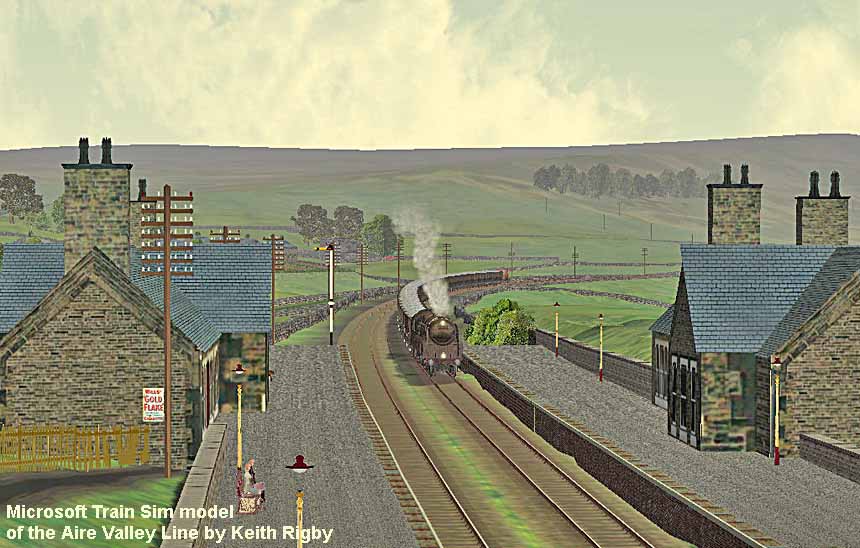
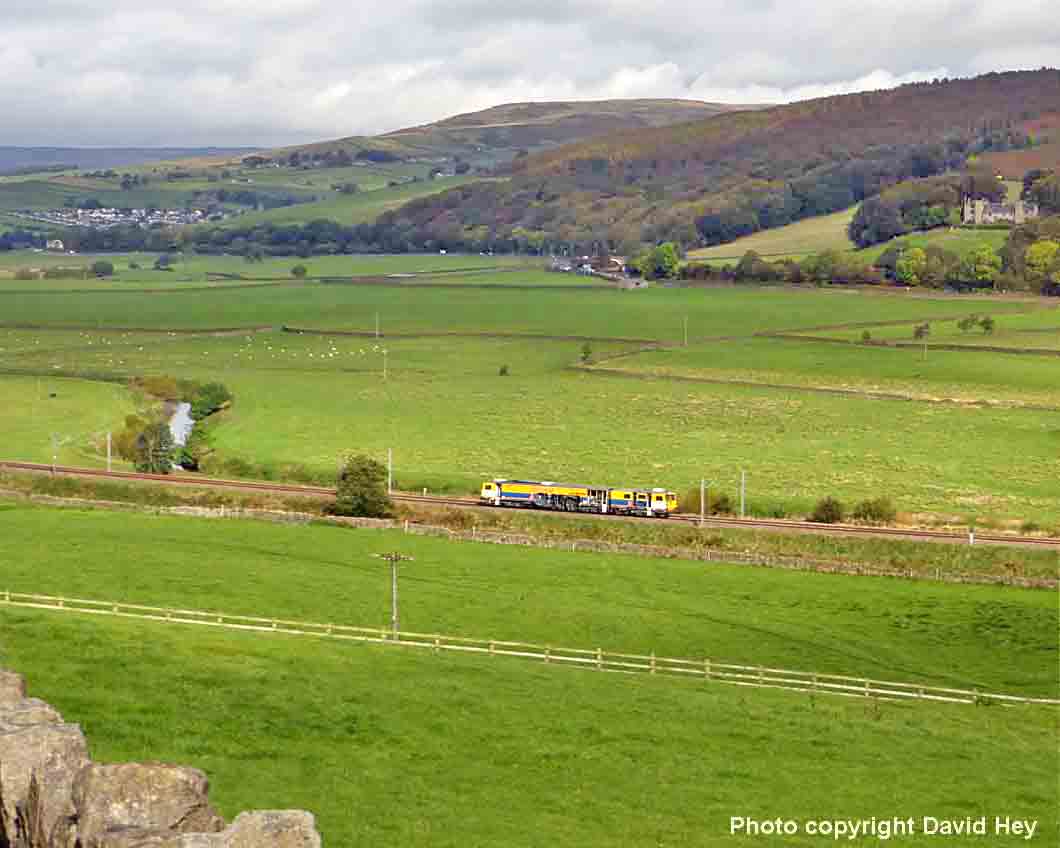
(Above-Below) This odd-looking rail vehicle is something of a mystery to me. I'm aware that VolkerRail supply, maintain and operate a fleet of On-Track Machines (OTMs) which tamp track and regulate ballast on Network Rail's infrastructure, but what this Plasser & Theurer vehicle was doing heading towards Skipton is unknown…judging by its slow speed perhaps it was taking rail measurements of some kind? Of particular interest is the course of the infant River Aire which remains exactly the same as in the photos I took earlier in 1961.
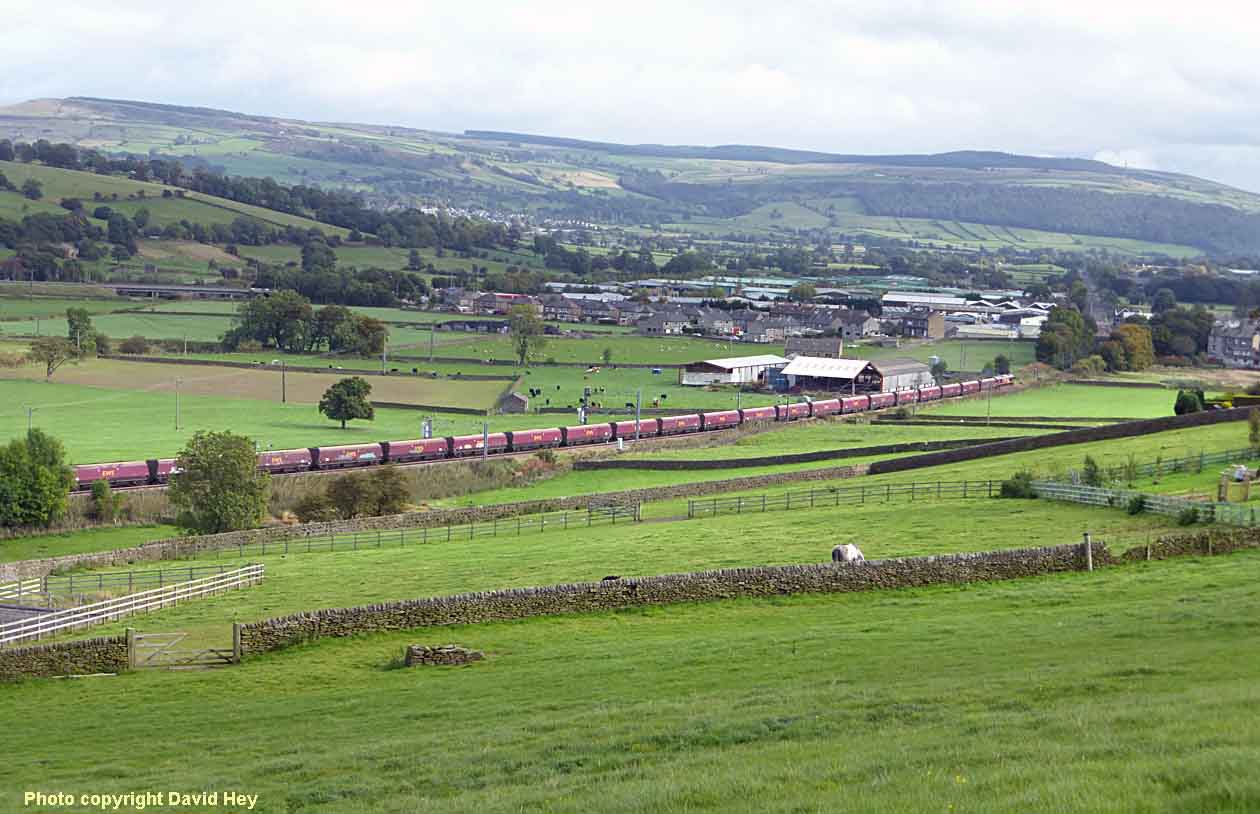

(Above-Below) I include this 'snatched' shot of a 'Black 5' heading towards Cononley for two reasons - it reminds me of Colin T Gifford's 'arty' shots in his classic book - 'Each a Glimpse' published by Ian Allan; it also gives me the chance to mention Neil Harvey's superb pictures of modern traction on his Flickr website HERE. It's reassuring to know that today's railway scene - tomorrow's archive - is being recorded by a new generation of railway photographers. (Below) Fast-forward to the 1980s, and this shot was taken from the same spot with a Canon A1 and 200mm telephoto lens; it shows preserved Stanier Pacific 46229 Duchess of Hamilton heading a northbound steam charter over the level crossing at Cononley. The illusion created by a telephoto lens belies the true nature of the landscape; yes the view is quintessentially upper Airedale but the hills in the background - Roughaw and Sharphaw - look a lot closer than their 5 miles or so distance. Needless to say, this photo is not possible today; the lineside vegetation has grown considerably since 30-odd years ago. 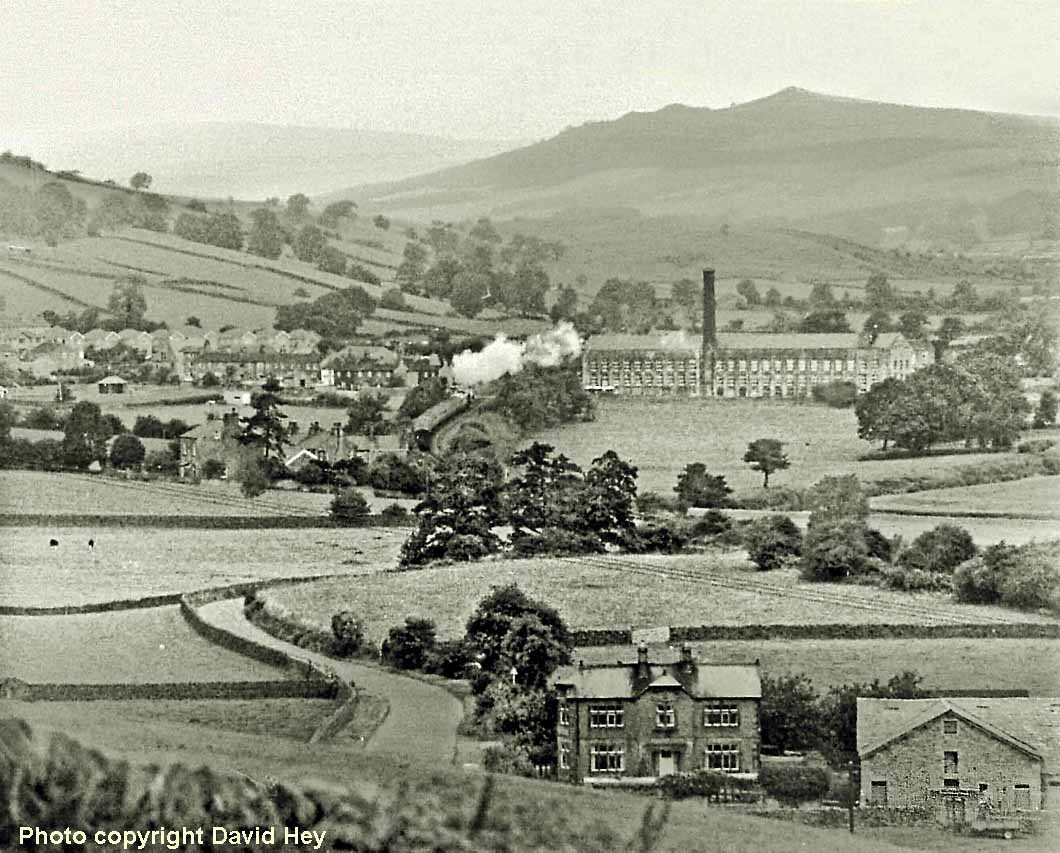
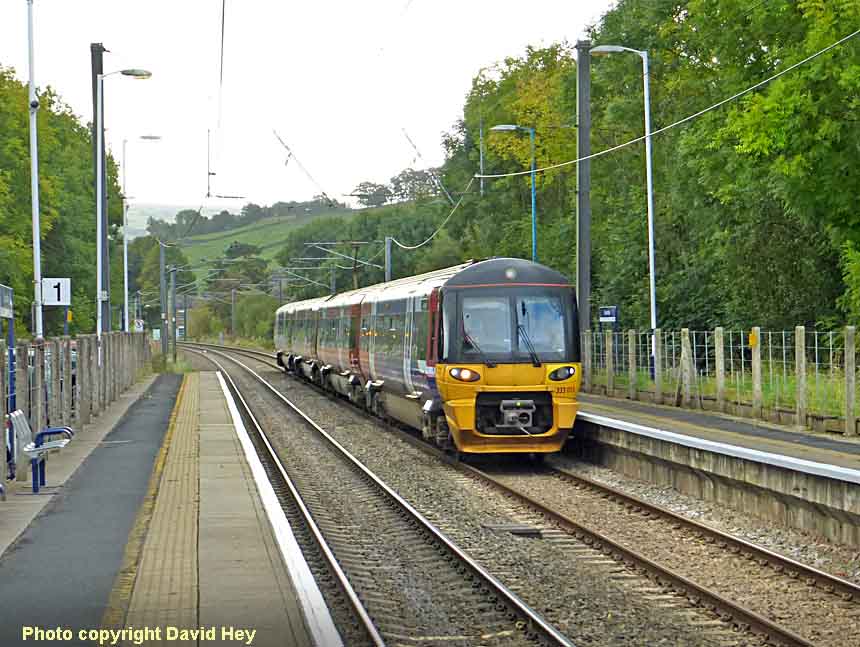
(Above-Below) The service between Bradford Forster Square and Skipton saw closures of stations at Manningham, Frizinghall, Saltaire and Steeton & Silsden on Saturday 20 March 1965. Both Kildwick & 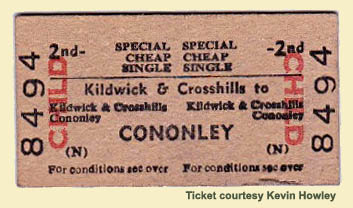 Crosshills and Cononley stations remained open for the Sunday service before closing at the end of that day. The station at Cononley reopened in 1988 at a relatively low cost of £34,000, doubtless due to both platforms remaining intact during its 23-year closure; in 1991 the line was electrified with 25kV AC overhead wires and local rail services are operated by modern rolling stock. Now I am not claiming these photos of Cononley station are anything out of the ordinary, but I do confess to being most impressed at the arrival of this Skipton-bound Class 333 emu; it simply glided into the station - no squealing of brakes, banging of couplings or slamming of doors - then after a brief stop it slipped away with the minimum of fuss, barely disturbing the peaceful ambience of Cononley village.
Crosshills and Cononley stations remained open for the Sunday service before closing at the end of that day. The station at Cononley reopened in 1988 at a relatively low cost of £34,000, doubtless due to both platforms remaining intact during its 23-year closure; in 1991 the line was electrified with 25kV AC overhead wires and local rail services are operated by modern rolling stock. Now I am not claiming these photos of Cononley station are anything out of the ordinary, but I do confess to being most impressed at the arrival of this Skipton-bound Class 333 emu; it simply glided into the station - no squealing of brakes, banging of couplings or slamming of doors - then after a brief stop it slipped away with the minimum of fuss, barely disturbing the peaceful ambience of Cononley village. 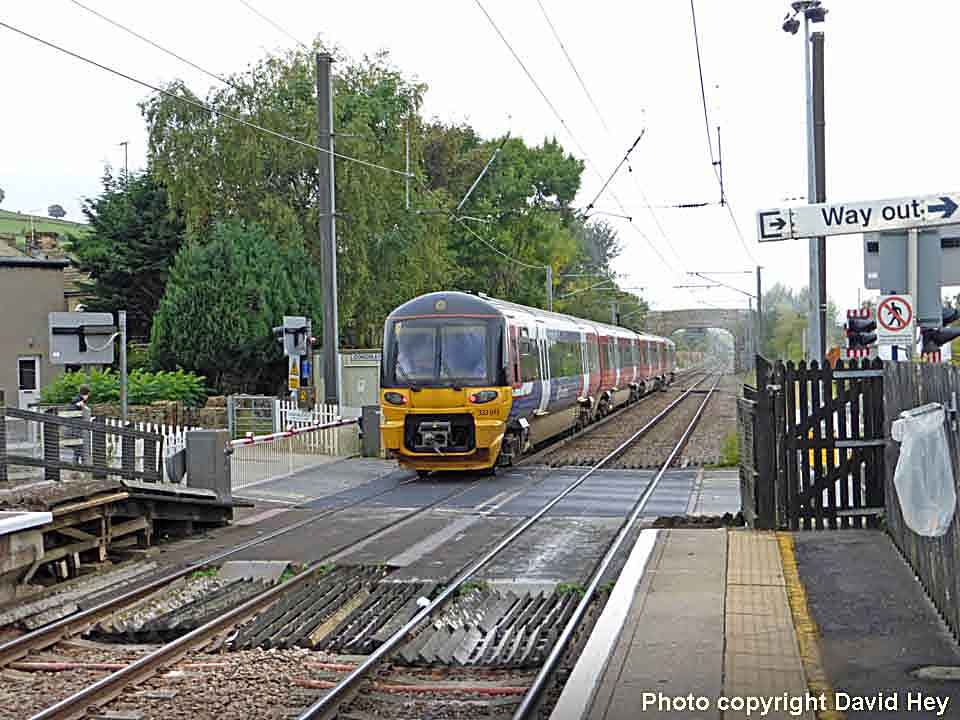
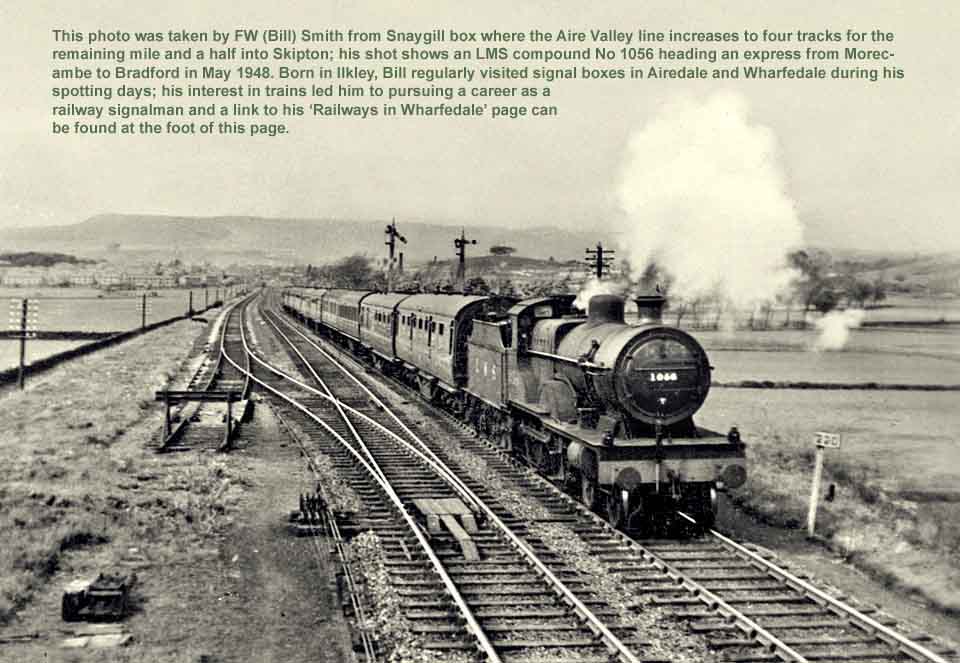
(Above-Below) Beyond Cononley the Aire Valley line increases to four tracks for the remaining mile and a half into Skipton; this shot by FW (Bill) Smith shows an LMS Compound No 1056 heading an express from Morecambe to Bradford past Snaygill signal box in May 1948. Born in Ilkley, Bill regularly visited signal boxes as a small boy during his train spotting trips to Airedale and Wharfedale; his interest led to a long career as a railway signalman working various boxes on the Wharfedale line...a link to his excellent 'Railways in Wharfedale' page can be found at the bottom of this page. (Below) As it will have done countless times before, ex-LYR 2-4-2T No 50671 of 20F Skipton shed passes Snaygill box with a Skipton to Bradford train on 8th May 1948. 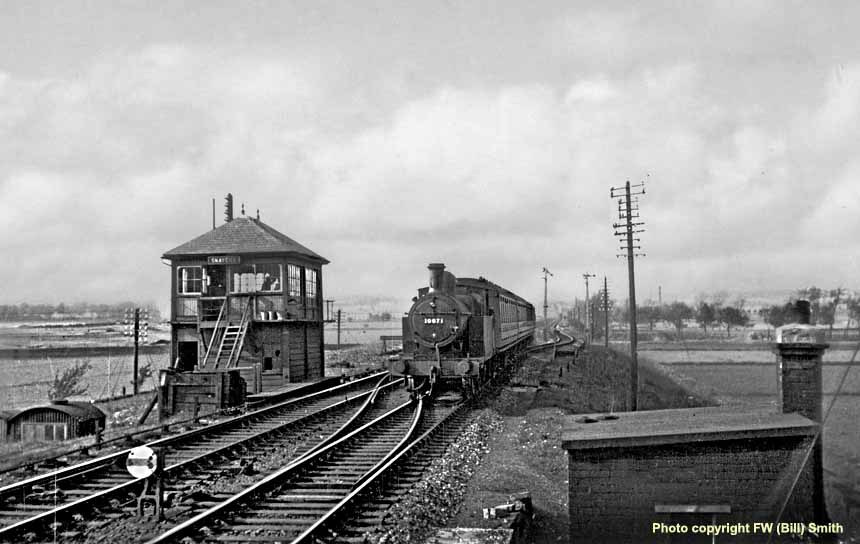
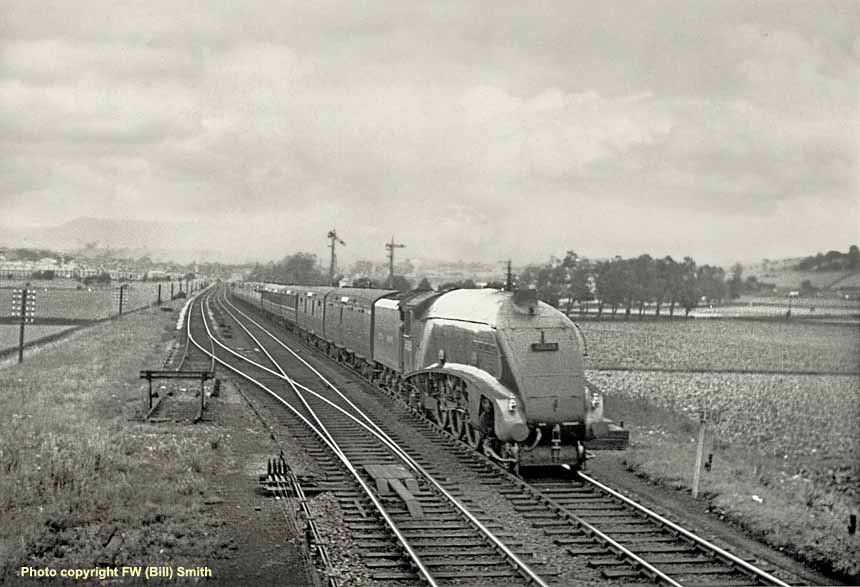
(Above-Below) On August 12 1948 a freak rainstorm over the Scottish borders led to a third of the region's annual rainfall to flood a large area of Berwickshire in just six days; this resulted in the East Coast Main Line being closed forcing Anglo-Scottish trains between London and Edinburgh to be diverted via the Waverley and the Settle-Carlisle lines. One of the earliest casualties was the southbound 'Flying Scotsman' which Bill photographed passing Snaygill box just south of Skipton behind Class A4 60009 Union of South Africa on 14th August 1948. (Below) Class 8F No 8070 plods along the up goods line towards Snaygill box on the same day. 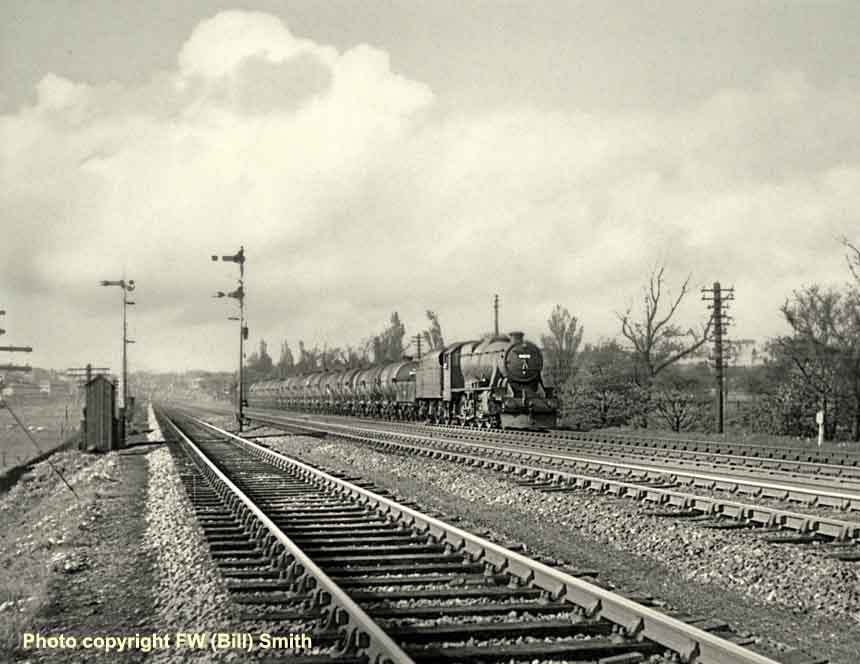
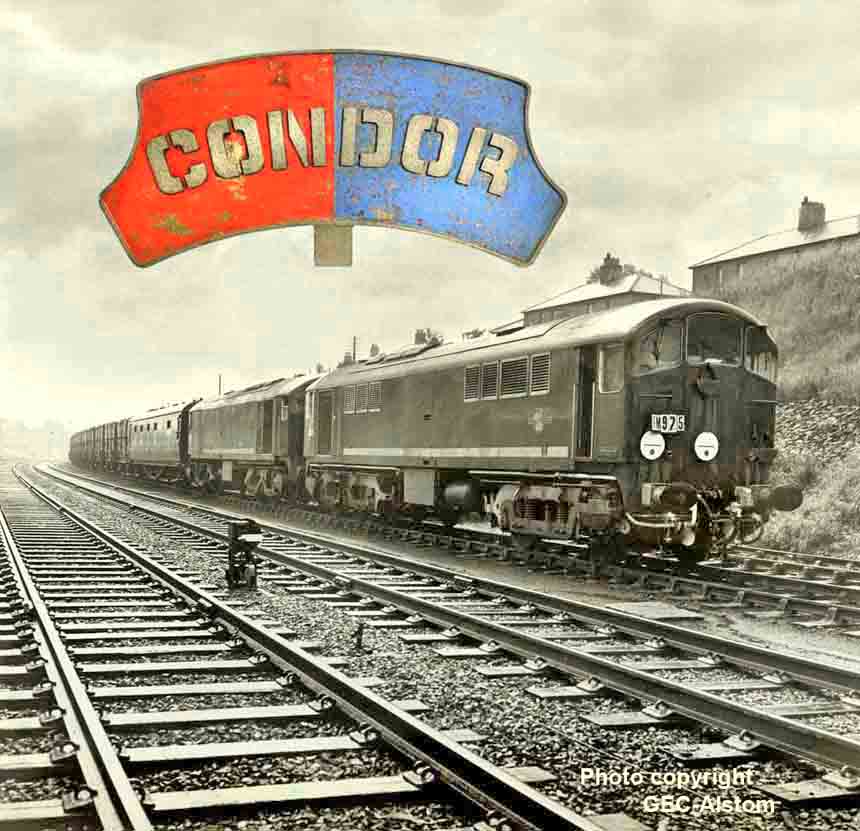
(Above) Before arriving at Skipton, we feature a 'named' goods train 'The Condor' which was introduced in 1959. In October 1958, the first of the Metro-Vick pilot-scheme Co-Bos Nos D5700 and D5701 hauled a test train comprised of 25 fitted 'plateflats' from Hendon to Glasgow in order to evaluate their capabilities when working as a pair on a new 'Condor' overnight freight service. The Condor (an abbreviation of container door-to-door) was one of the first attempts at container freight traffic in Britain, and made its inaugural run on March 16th 1959, its main attraction being a guaranteed overnight delivery between London and Glasgow. Prior to its introduction, tests were carried out under controlled trial conditions, comprised of a dynometer coach and 25 short wheelbase vacuum braked flats. The test train is awaiting signals at Skipton South Junction on October 1st 1958. Inserted in the photo is a locomotive headboard, 'The Condor', as carried by the Co-Bos on this London (Hendon) and Birmingham (Aston) to Glasgow (Gushetfaulds) overnight freight services. The London train ran from March 1959 to October 1967 and the Birmingham service from January 1963 to November 1967. This unique style of headboard carries LMR and ScR colours and has split lettering. The headboard - clearly in ex-loco condition - went under the hammer at a Great Central Railwayana Auction in July 2012. 
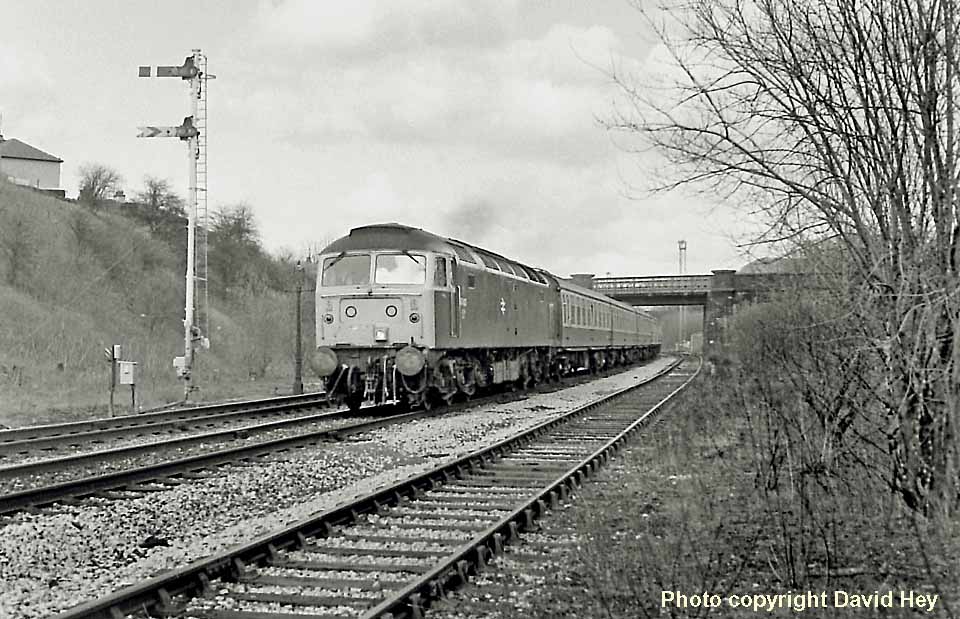
(Above-Below) In the opposite direction, Class 47 .............. 'Black 5' No 44943......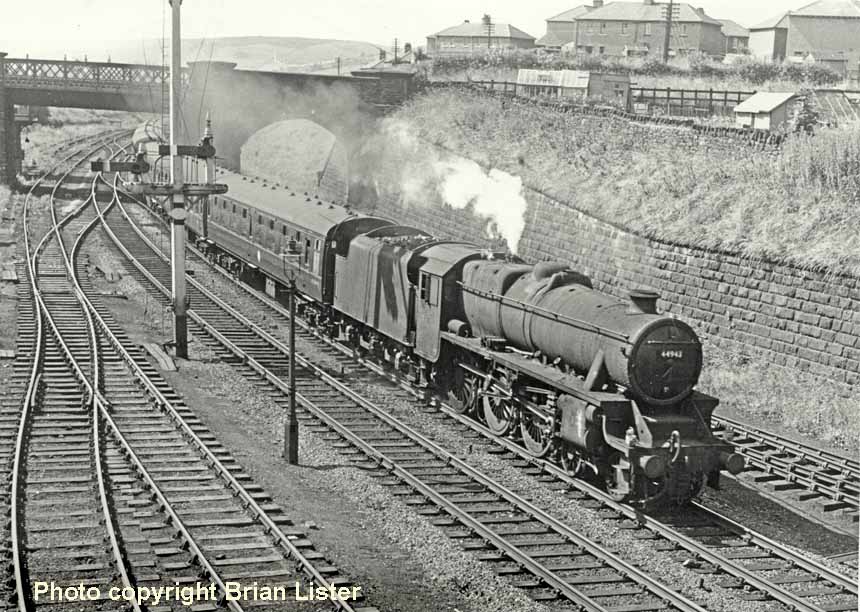
(Below) Skipton in Craven, to give it its local title, was first reached by the MR Aire Valley Line in 1847. The Ilkley line was opened forty years later which gave an alternative route to leeds via the Wharfe valley up to closure in March 1965. Fast-forward to 1983, and Class 31s Nos 31203 and 31343 head past the abandoned Ilklley platforms with the 10.18 Rylstone-Dairycoates Tilcon train in September 1983. The train will reverse in Broughton Yard before continuing the journey to Hull via Leeds. In the background, the centre platform loop is occupied by a 2-car Metro-Cammell unit, however the eagle-eyed may spot a Leeds-Lancaster Trans-Pennine set awaiting departure in the main running platforms on the left. By the early 1980s the Settle-Carlisle line had lost its Anglo-Scottish passenger service following the rerouting of the scheduled Nottingham-Glasgow expresses via the Hope Valley line. This effectively left a meagre two passenger trains in each direction daily between Leeds and Carlisle; the inadequacies of the service attracted unfavourable attention, and BR introduced the elderly Trans-Pennine sets to provide a fast connecting service from West Yorkshire to west Scotland via the WCML at Lancaster. Introduced in 1961, the Trans-Pennine units had plied the Standedge route between Liverpool and Hull for more than a quarter of a century, but by the 1980s they were well past their best. The entire fleet was withdrawn in May 1984 which led to the reinstatement of a loco-hauled service at the start of the 1984 summer timetable. 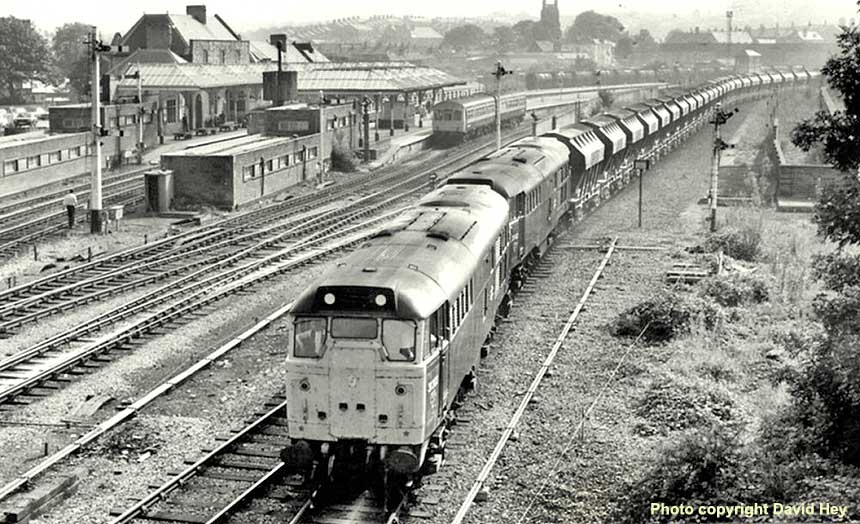
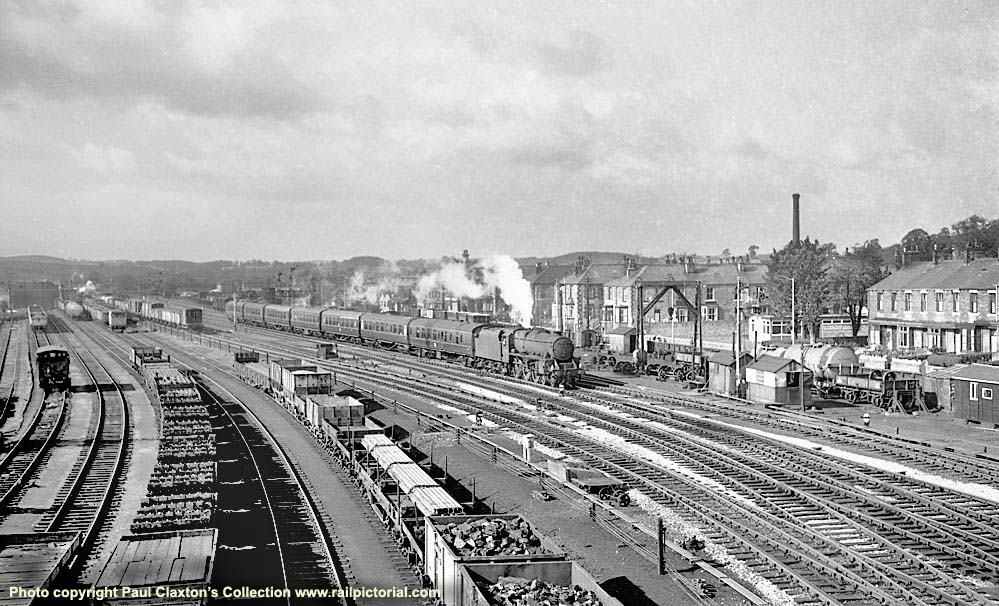
(Above-Below) Looking in the opposite direction from Carleton New Road bridge, Paul Claxton captures this evocative shot of 'Black 5' No 45306 slowing for its obligatory stop at Skipton with a Carnforth-Leeds train on 27 September 1963. This photo came from Mike Claxton's www.railpictorial.com - a superb website dedicated to the memory of his brother Paul, who sadly passed away in April, 2009. Paul began train spotting at a very early age, and like most young boys during the late 1950s he started taking railway photographs, a natural adjunct to train spotting, and Mike has created this superb website for the simple reason that it gives enthusiasts a chance to enjoy his late brother's photographic collection online...and what a collection it is! Rarely have I see such quality and in such high numbers on one website. Needless to say, I am a big fan and a visit HERE is highly recommended. (Below) Comparisons can be made with this shot of Class 47 No 47114 arriving at Skipton with the 10.22 7E54 Ribblehead-Healey Mills stone train in July 1983. 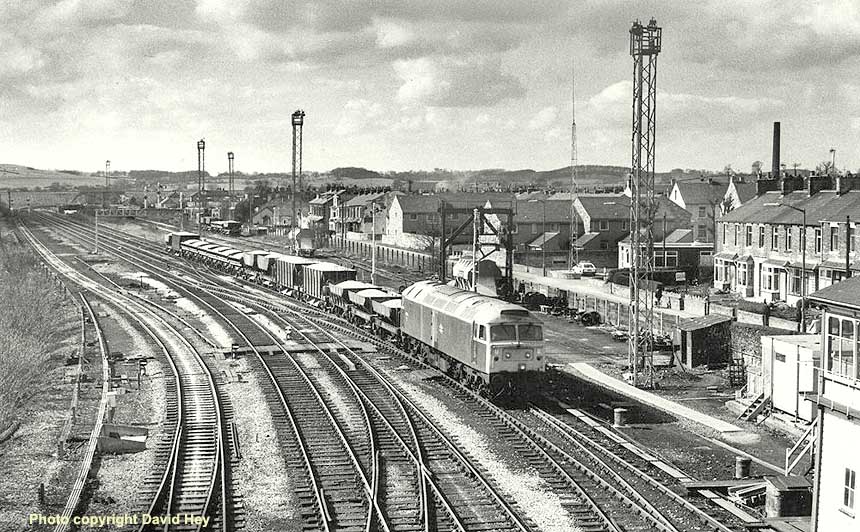

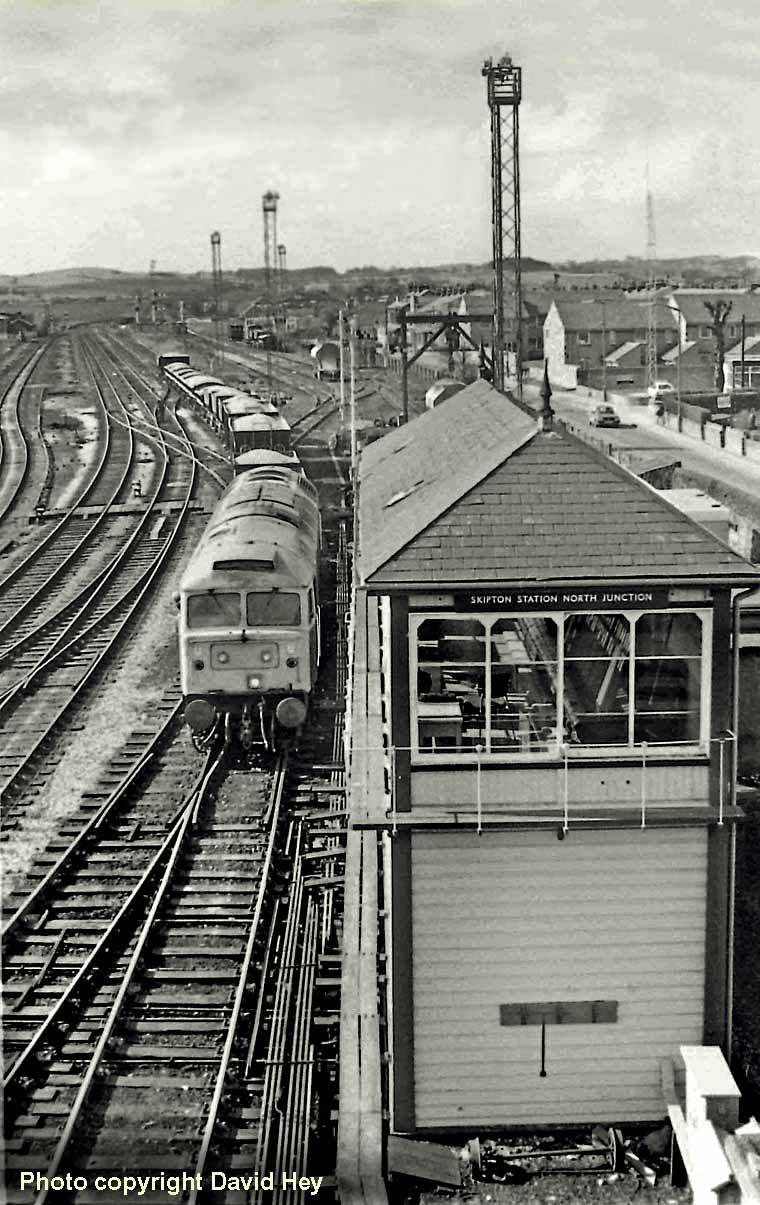
(Above) This is another view of Class 47 No 47114 arriving at Skipton with the 10.22 7E54 Ribblehead-Healey Mills stone train in July 1983. The former goods yard in the background was used for stabling the  Tilcon wagons at weekends. Any wagons with problems could be taken out and put to one side. The hoist enabled the wagons to be lifted at one end and axles removed or hot boxes mended. Some replacement axles were usually available and stored close by the siding. Axles with wheel flats were removed and replaced; a flat bed articulated lorry brought in 'new' axles and took the ones requiring attention away. I'm not sure if the axles were taken to Neville Hill or Doncaster. Maybe someone out there will know.
Tilcon wagons at weekends. Any wagons with problems could be taken out and put to one side. The hoist enabled the wagons to be lifted at one end and axles removed or hot boxes mended. Some replacement axles were usually available and stored close by the siding. Axles with wheel flats were removed and replaced; a flat bed articulated lorry brought in 'new' axles and took the ones requiring attention away. I'm not sure if the axles were taken to Neville Hill or Doncaster. Maybe someone out there will know.
(Below) The ravages of the Beeching cuts completely eradicated Britain's rail network in the 1960s, and railway photography became something of a lackadaisical affair in the 1980s, but during a reconnaissance with a camera to Skipton in 1983 it was encouraging to see that little had changed, even though the station's importance as a railway junction had diminished following the withdrawal of passenger services to Ilkley on 22 March 1965 and the closure of the line to Colne on 2 February 1970. This led to an inevitable spate of track rationalisation, of course, but much of the 1960s infrastructure in the vicinity of the station remained intact along with the continued existence of semaphore signalling controlled by two signalboxes at Skipton Station Junction North and Skipton Station South. Fast-forward to 2014, however, and the changes were striking; the view below looking west from Carleton New Road bridge shows nature has taken its course and the sidings formerly used for repairing the Tilcon wagons have been relaid to stable EMUs and a washer plant has been installed at the neck of the turnouts. 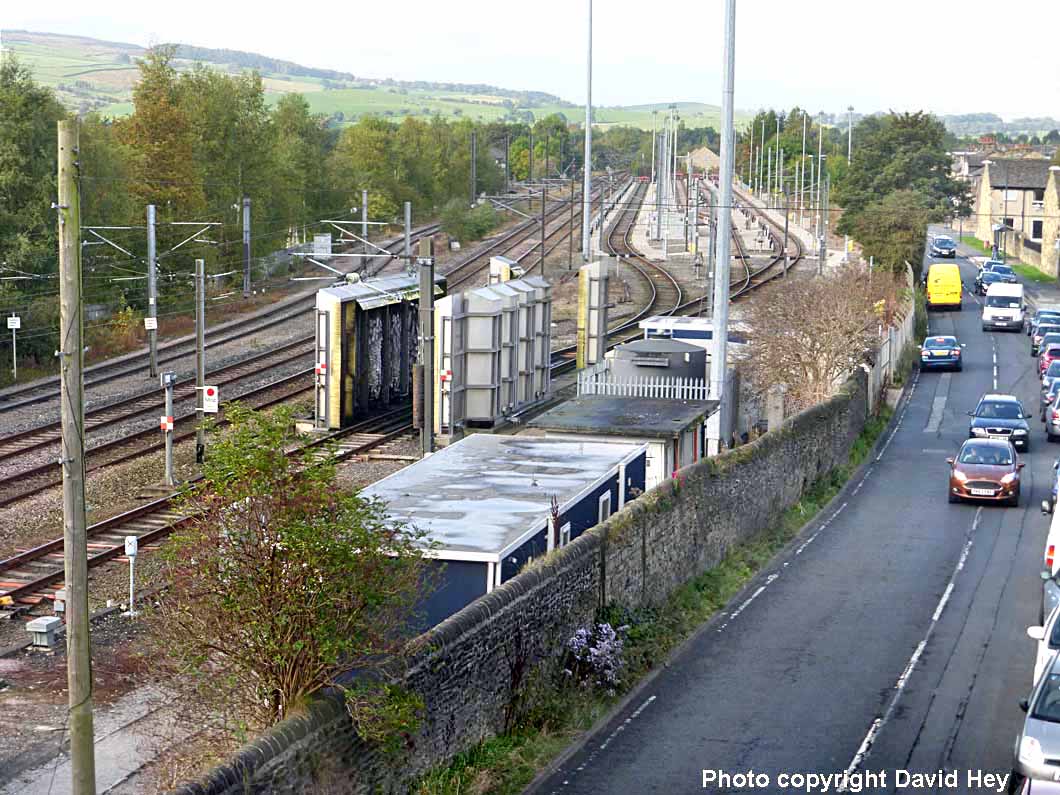
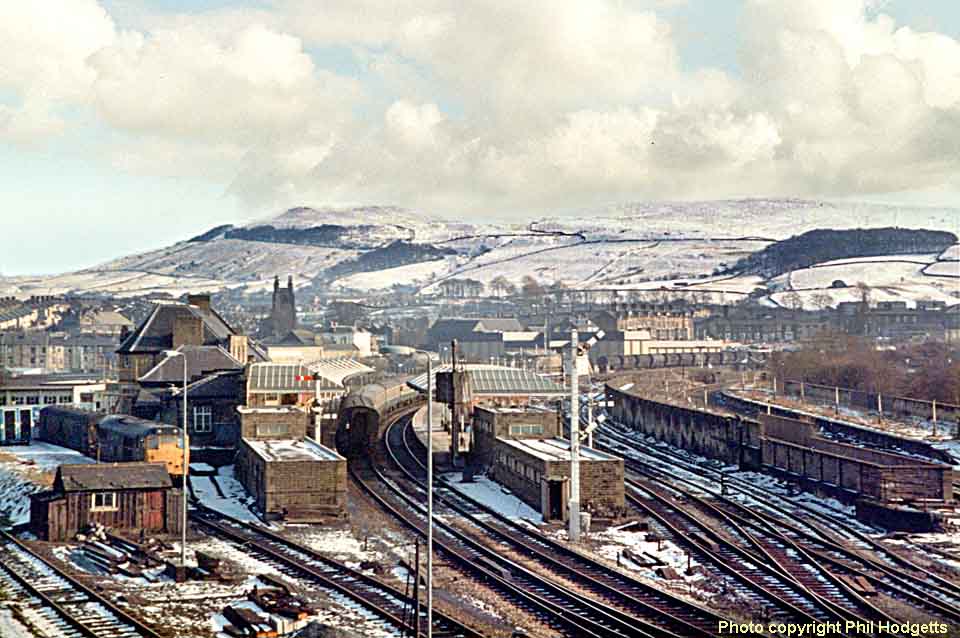
(Above) Located a ¼-mile away from the original station, the present-day Skipton station was opened 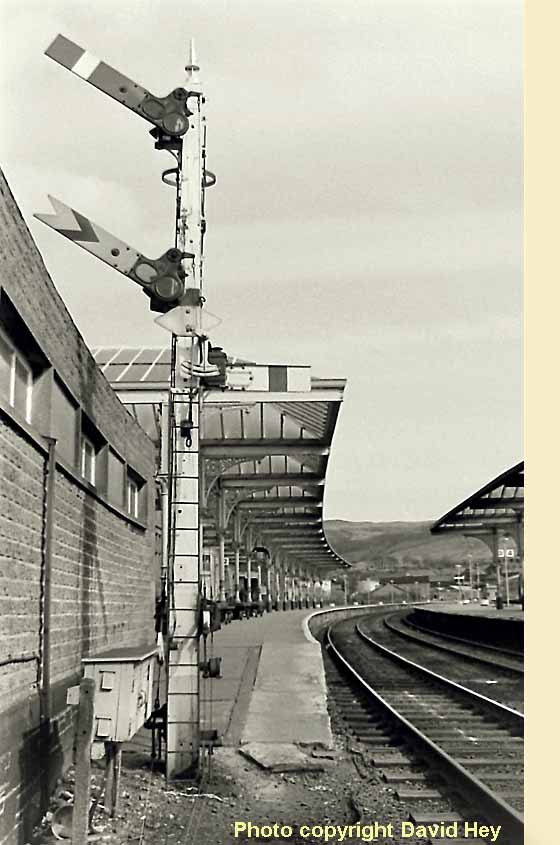 in April 1876, by which time both the Leeds and Bradford and North Western railway companies had been absorbed by the Midland Railway (MR). Construction of the new station coincided with the opening of the MR's Settle-Carlisle line, and consisted of four platforms: a bay platform 1 at the Bradford end, an 'up' platform 2 for through traffic, and platforms 3 and 4 formed an island platform for traffic on the 'down' line. In October 1888 platforms 5 and 6 were added following the opening of the Skipton-Ilkley line; these platforms also served the short branch to Grassington. Following withdrawal of passenger services to Ilkley in 1965, platforms 5 and 6 were abandoned and access via the subway closed, however a single freight-only line remains in use through platform 5 for the limestone trains to from the Swinden Quarry on the old Grassington branch. In the 1980s, the track serving the bay platform 1 was removed and platform 4 was relegated to a siding.
in April 1876, by which time both the Leeds and Bradford and North Western railway companies had been absorbed by the Midland Railway (MR). Construction of the new station coincided with the opening of the MR's Settle-Carlisle line, and consisted of four platforms: a bay platform 1 at the Bradford end, an 'up' platform 2 for through traffic, and platforms 3 and 4 formed an island platform for traffic on the 'down' line. In October 1888 platforms 5 and 6 were added following the opening of the Skipton-Ilkley line; these platforms also served the short branch to Grassington. Following withdrawal of passenger services to Ilkley in 1965, platforms 5 and 6 were abandoned and access via the subway closed, however a single freight-only line remains in use through platform 5 for the limestone trains to from the Swinden Quarry on the old Grassington branch. In the 1980s, the track serving the bay platform 1 was removed and platform 4 was relegated to a siding.
(Left) This photo of the bi-directional signal at the end of platform 2 rekindles old spotting days at Skipton for Craig Duncan. He writes - 'Imagine a world in slow motion as a cattle train lumbers along the platform and judders to a halt accompanied by the usual squeal of brakes, buffers clanking and occasional 'mooing' noises. After half a minute the back signal comes off and the 4F then pushes the train which rumbles off towards the North Box. And the cows ? They would likely finish up on our dinner plates accompanied by roast potatoes and Yorkshire pudding. It's interesting how a single shot can induce such a vivid memory...'
(Below) In 1994 the station reverted back to its original form with all four platforms; at the same time semaphore signalling was replaced by colour lights (controlled by Leeds PSB, later IECC at York) in readiness for electrification of the Aire Valley line and this involved closure of Skipton's two remaining signal boxes. In the 2014 view below, here too nature has reclaimed a large area and the abandoned Ilkley platforms are overgrown with trees and shrubs. Dominating the background is the Tesco supermarket which occupies the former bitumin terminal featured further down the page. Also the Skipton Christ Church tower features in a lot of views of the railway and station.
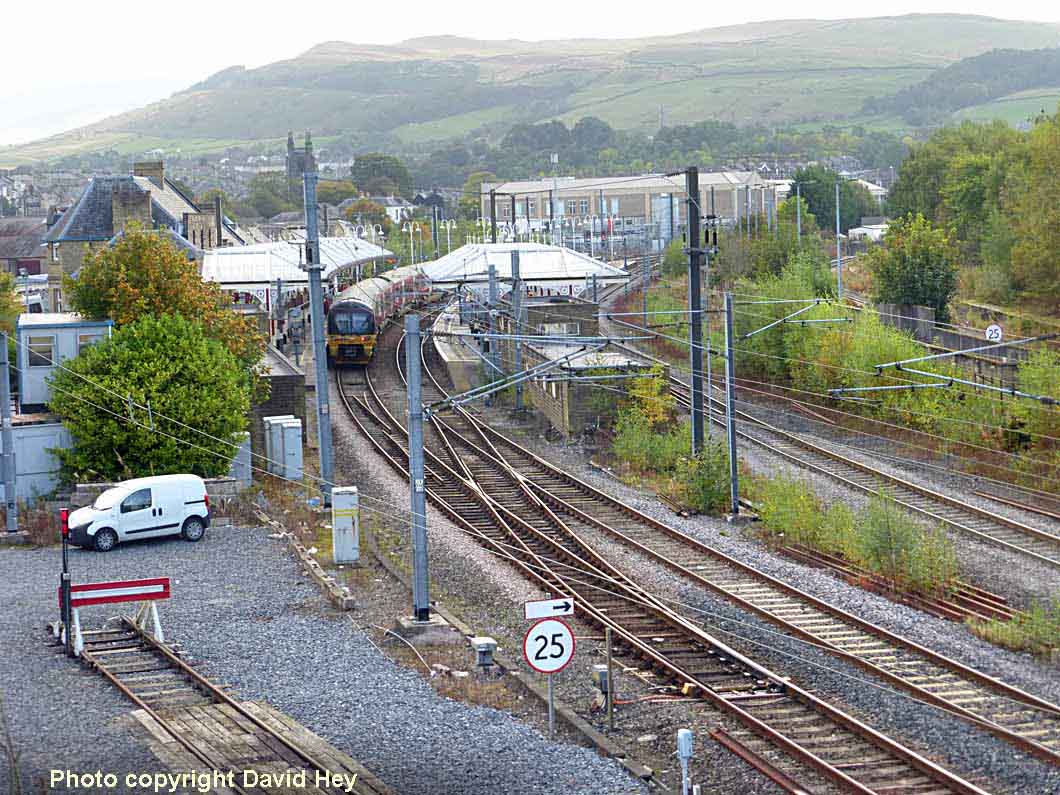
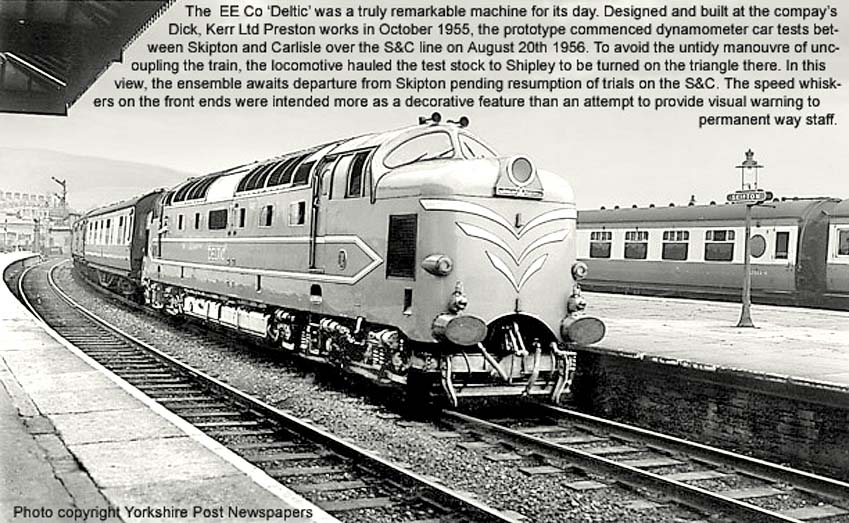
(Above) Built at the English Electric Co's Dick, Kerr Ltd Preston works in October 1955, the 3,500hp Co-Co 'Deltic' prototype commenced dynamometer car tests between Skipton and Carlisle over the S&C line on 20th August 1956. In this view, the ensemble awaits departure from Skipton pending resumption of trials on the S&C. During the early days of dieselisation, the British Transport Commission carried out trials using the same techniques as those established for assessing the capabilities of steam locomotives. The LMR had developed a method of constant speed testing using three mobile test units which could absorb the power being developed whilst maintaining a selected speed. A dynamometer car coupled with up to three mobile test units was used on maximum load runs to avoid the need for assembling a train of excessive lengths comprised of ordinary coaching stock. The test train could simulate a massive loading effect which enabled travelling technical staff to monitor the various performance characteristics of a locomotive working under full power. The S&C provided a natural testing ground with adverse gradients maintained almost without interruption at 1 in 100 on the climb to Ais Gill summit. The English Electric Co clearly had export potential in mind for the distinctive American-style nose end and non-functional headlight were a prominent feature of the prototype. 
(Above-Below) BR Standard 4 No 75019 heads a train of mineral wagons through platform 2 on the 'up' main line past the former MR Type 3A Skipton Station South signal box. Opened in February 1906, the box was fitted with a 29-lever Midland Railway tumbler frame; the 'pegged' distant indicates the loose-coupled freight has been signalled onto the slow lines. The box closed in 1994 on completion of the Aire Valley resignalling scheme and control of trains between Leeds and Hellifield was passed to Leeds PSB on 31st October 1994. (Below) Yet another evocative shot from the Yorkshire Post Newspaper's photo archive HERE; this image shows one of the true forerunners of the first-generation diesel railcar fleet, the 'Derby Lightweights' - a nickname coined by the use of a light alloy and steel in their construction at the Derby Carriage & Wagon Works. The first BTC order was placed for eight 2-car sets for the West Riding service followed by an order for thirteen 2-car sets for West Cumberland. On a misty February day at Skipton in 1955, this 2-car unit appears to be something of a novelty during a demonstration run to Carlisle. Just visible in the right background of both pictures is the original Skipton station building. 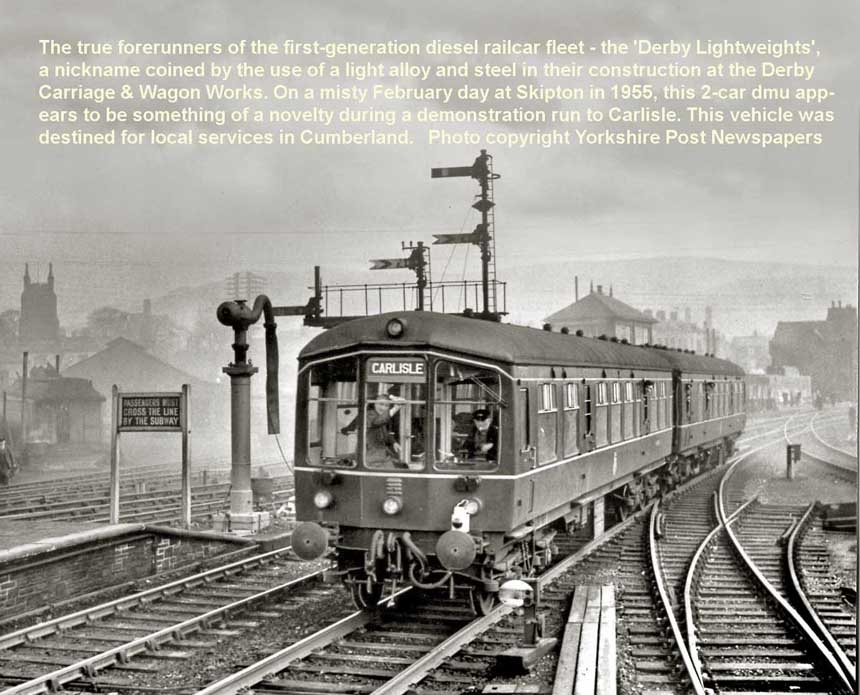
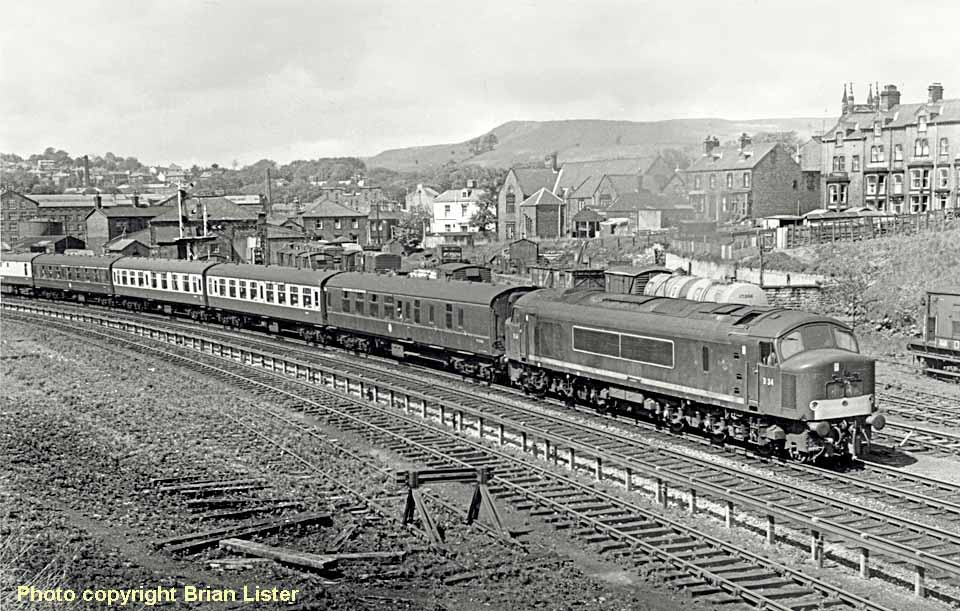
(Above-Below) Track rationalisation is very much in evidence in Brian Lister's superb shot of 'Peak' Class D34 (later Class 45 No 45119) heading the southbound 'Thames-Clyde Express' away from Skipton in June 1967. (Below) One of the biggest contributors to this site is Phil Hodgetts who recently dropped a line. He writes - 'Hi David, I came across these pictures on the superb Skipton Facebook page HERE. No idea of the names of the photographers. I'm sure the one of the original Skipton station (below) might well be a Donald Binns picture. Beneath it is a colour shot of a Metro-Cam 3-car set departing Skipton, however when I asked who owned the copyright of the photo, the poster replied 'there is no copyright'. This photo encompasses everything we talked about when we met up at Skipton recently; it was taken in 1967 prior to the old Goods Shed being demolished and the Hillards Supermarket going up on the site. Best wishes, Phil...'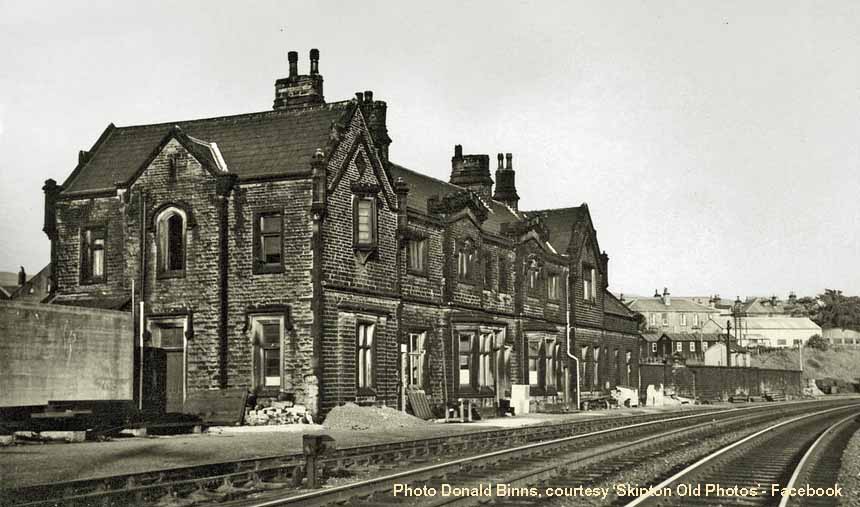

(Above-Below) A Metro-Cam 3-car set departs Skipton for Leeds in 1967. (Below) Fast-forward eighteen years to March 1985, and Class 31 No 31101 was photographed sorting out a train of bitumin tankers. In the background is the 'new' Hillards store which stands on the site of the old goods shed; the goods shed was demolished 1981-1982 to make way for the new supermarket. The little wooden hut and the wall down the back of the row of tanks were remnants of the original Skipton Station - terminus of the line from Leeds and Bradford before the extension to Colne was built. 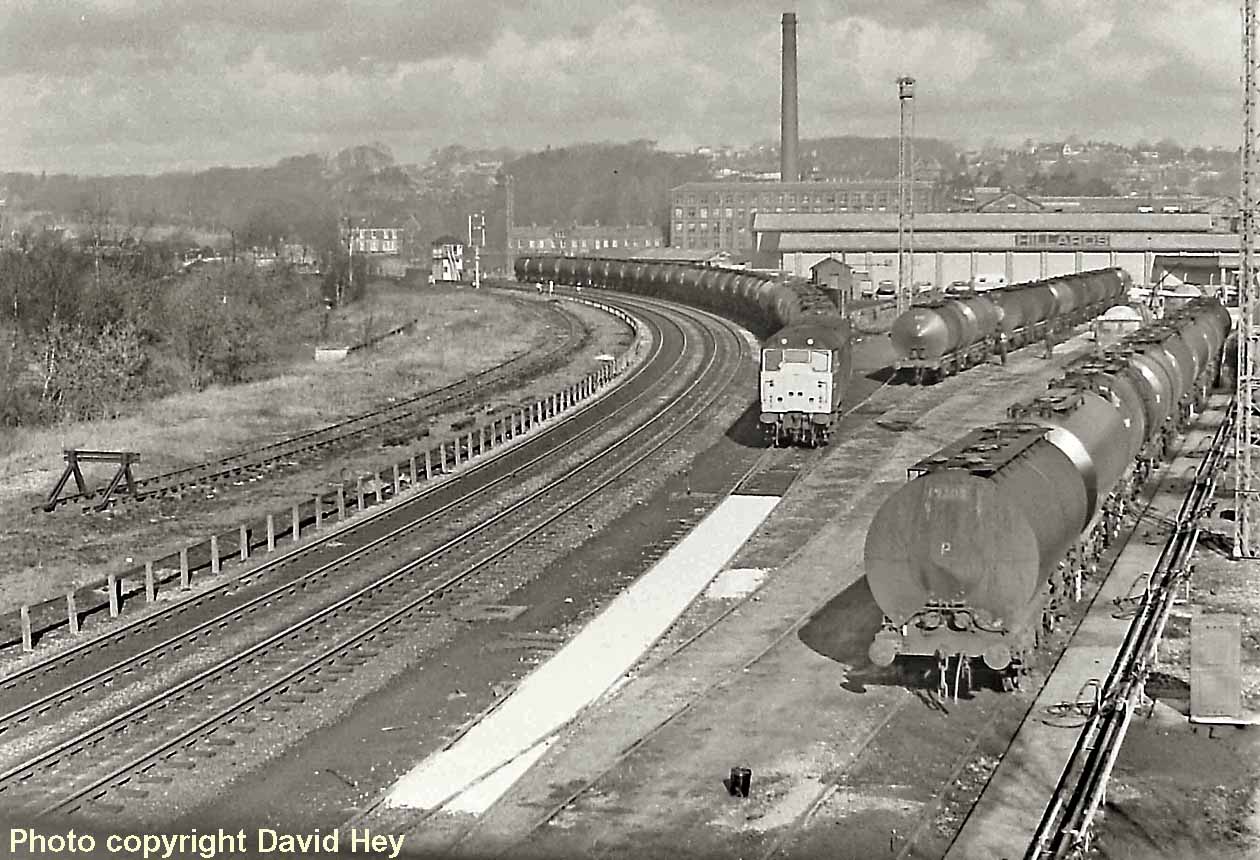
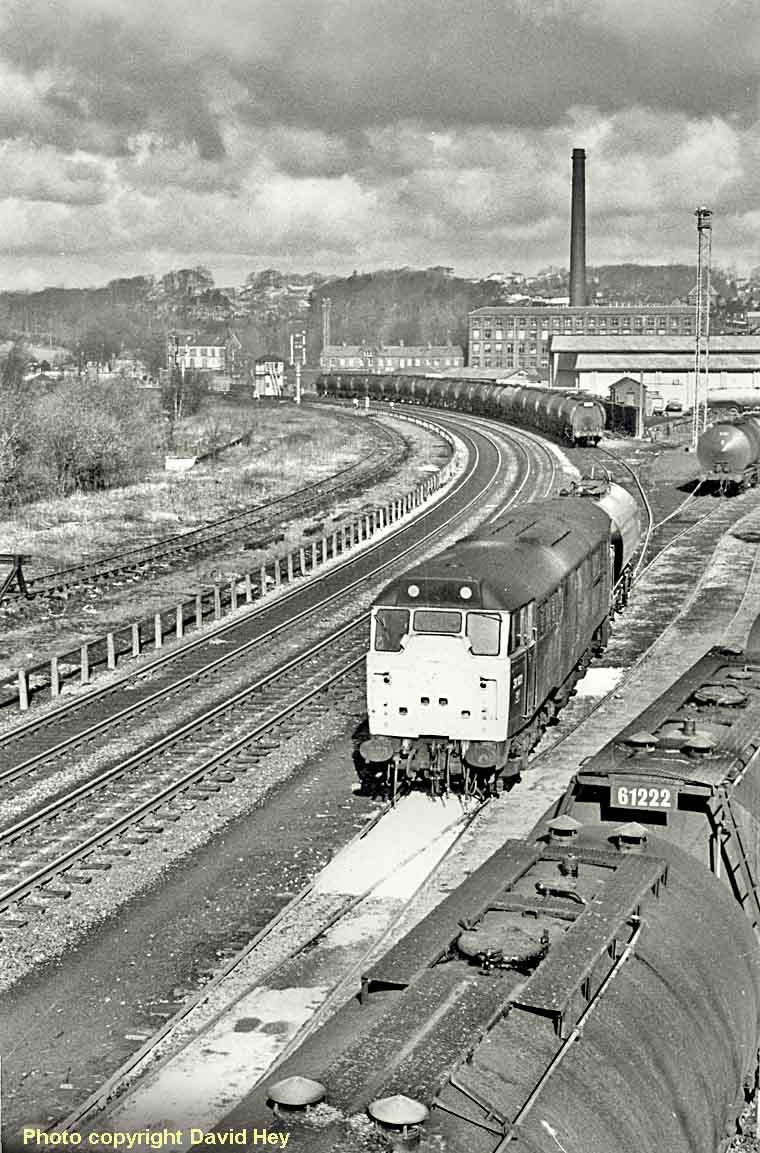
(Above) Here is another view of the Class 31 performing shunting activities; this one showing the conical ends of the tank wagons plus details of the vents and associated pipework. There's an interesting page on the excellent Derby-Sulzers website HERE featuring the memories of footplate cameraman, Michael Kaye, who regularly worked the Aire Valley Line; he writes - 'The oil tar tanks regularly travelled through Skipton as the eastbound 6E48 18.25 Tuesdays Only Whitehaven-Immingham, returning as the westbound Thursdays Only 6M59 01.10 Immingham-Whitehaven. After the bitumen was discharged, departure would be as the 6F55 13.45 to Stanlow.'
Meanwhile, a regular contributor to this site is Phil Hodgetts - check out his superb Cowpen & Blyth Pages on the left-hand menu. Phil spent a big part of his childhood living in the vicinity of the railway at Skipton; he writes - 'The bitumen traffic was usually Class 31 hauled; the empties were shunted out of the yard onto a siding which ran back into the old bay platform 1 at Skipton. The Class 31 in these shots is drawing the empties off that siding. A resident class 08 used to do all the shunting activities. I recall late Saturday nights (after the last passenger workings) the 08 set off light engine to Neville Hill for refuelling. I cannot say for sure if it was back at the Skipton terminal for Sunday morning or whether it arrived later on the Sunday, but it was always back at work Monday morning. All the bitumen tankers were brought into the yard and immediately connected to the mains gas supply; I remember a low level roar from the burners when the gas was lit. The burners on the wagons kept the bitumen warm, so that it could be pumped as a liquid into the waiting road tankers...'
(Below) Phil continues - 'In this photo you can see three road tankers in the yard. The vehicles were insulated and fitted with onboard gas bottles to keep the bitumen in a fluid state. The MK1 carriage on the loader was one of two or three that arrived in the goods yard for delivery to the Yorkshire Dales Railway at Embsay. Click HERE to visit their website. At one time new carriages were delivered by rail to the YDR, but the rail link at Embsay Junction was taken out in the mid 1980s; however a citation on the Wikipedia website states that Network Rail has carried out a study into the possible reinstatement of a rail connection between the Grassington and Embsay lines, along with the restoration of platform 5 at Skipton. This has been rumbling on for years, of course; subject to the availability of funding it would be wonderful to see the Embsay and Bolton Abbey Railway running trains into Skipton; the abandoned Platform 6 could be reinstated as a run-round loop as part of the project. In the background can seen a new housing development, beyond which is a clear view of the former Ilkley line dropping down to Skipton…a view now obscured by trees and shrubs.'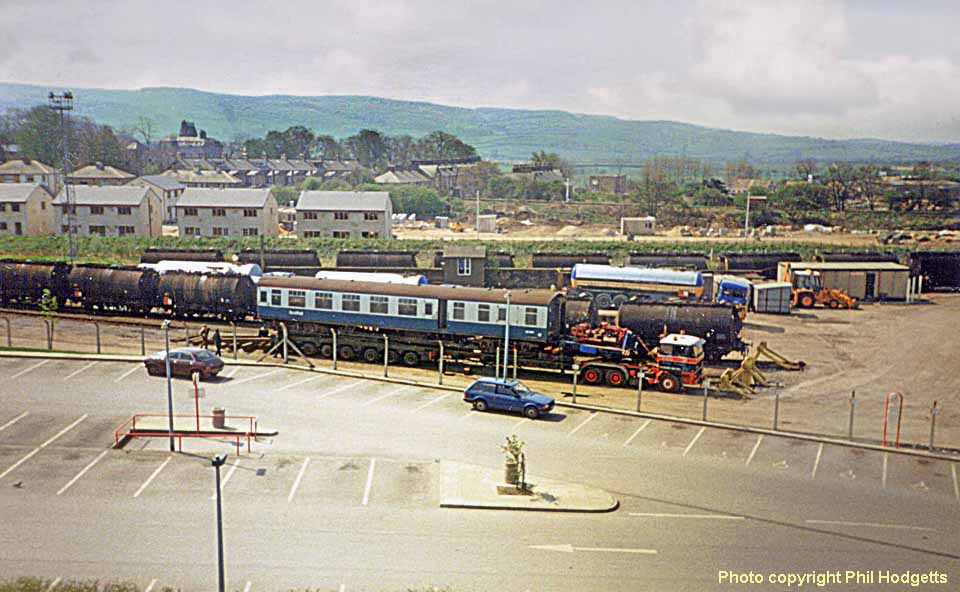
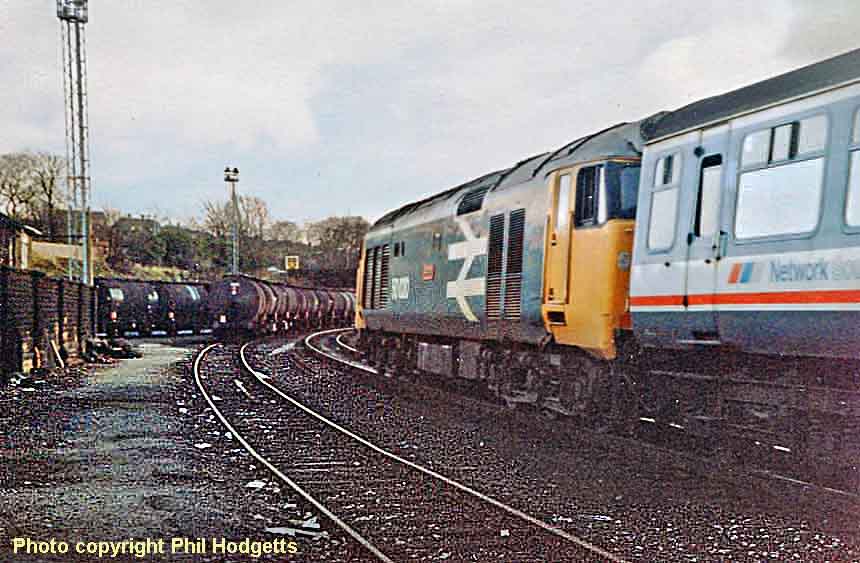
(Above) Phil was trackside at the bitumen terminal to take this shot of Class 50 No 50020 Revenge departing Skipton on the return leg of the 'Skipton Skipper', an enthusiasts special organised by Pathfinder Tours on 14 November 1987. The old station wall can be seen on the left. Departing Bristol Temple Meads, 50020 headed north to Sheffield then via Barnsley, Penistone, Huddersfield, Mirfield, Wakefield Kirkgate, Normanton and Woodlesford to Leeds Whitehall Junction; it continued its journey up the Aire Valley line and diverged at Apperley Junction via Guiseley to llkley. As there were no run-round facilities at Ilkley, Class 31 No 31463 hooked on for the short trip via Esholt Junction and Shipley East Junction to Bradford Forster Square. The Class 50 followed the ensemble light engine and hooked on for the run from Bradford to Skipton. The Class 50 then ran round its train for the return leg via Leeds, Sheffield, Derby, Burton-on-Trent, Tamworth, Birmingham New Street and Cheltenham Spa to Bristol Temple Meads. This information came from the excellent 'Six Bells Junction' website HERE; you'll find a vivid personal review of the trip by Melvin Teale, who writes - 'This was simply a 'must do' tour for me as it covered the area in which I grew up…' You can read the rest of Melvin's comments on the Six Bells Junction website.
(Below) During the 1980s Skipton's freight traffic was composed mainly of limestone trains from local quarries plus train loads of ammonia from Teesside to the ICI plant at Heysham and bitumen from Stanlow to the distribution plant at Skipton. However BR's freight services were greatly reduced in 1986 following the closure of the Heysham chemical plant and the loss of the Stanlow - Skipton bitumen traffic to road haulage, but steam-hauled charter specials remained a big draw for enthusiasts, either operating from the Steamtown museum at Carnforth or working over the Settle-Carlisle line. Here Phil captures Class V2 Green Arrow approaching Skipton from the south. This shot shows the truncated track at the entrance to the oil sidings. After Tesco bought the site they used the land to extend the car park. No rails were buried; they were all lifted. The new fencing is the Tesco boundary. If you look carefully at the structure between the porta-cabins in the background, you can see the very last vestige of the original Skipton station - the toilets! They were finally done away with when the new Tesco store was built.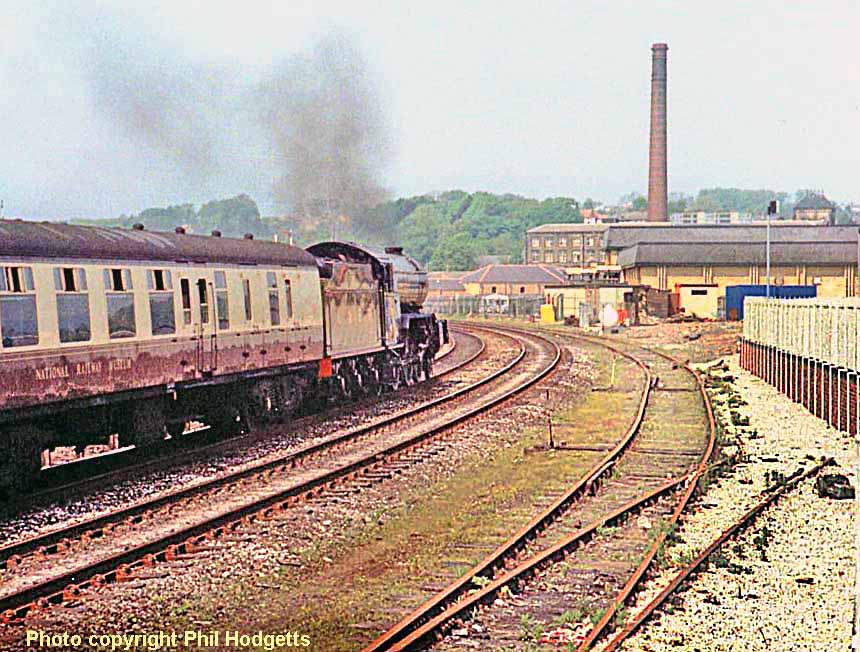
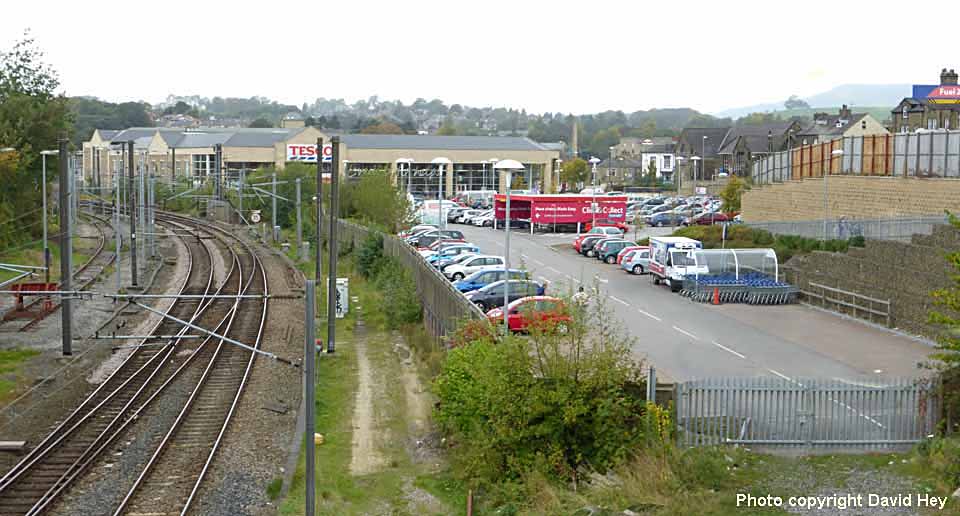
(Above-Below) In this 2014 view the bitumen terminal is now a Tesco supermarket car park and a new facing crossover has been installed to give access to the newly reopened side bay in Platform One. (Below) But getting back to steam days, when 'Britannia' Class 7MT No 70044 Earl Haig rolled off the production line at Crewe Works in June 1953, it was the last of the second batch of 'Britannias' Nos 70025-70044 to be built; the final batch of ten engines Nos 70045-54 were paired with the larger BR1D tenders which had a capacity of 9 tons of coal and 4,725 gallons of water; they were also equipped with a steam operated coal pusher to aid firemen. Ben Brooksbank captured this image of 'Britannia' class No 70044 Earl Haig drawing into Skipton Station with the 'down' 'Thames-Clyde Express' in April 1961. The engine spent nearly four years at Leeds Holbeck and would have made this journey to Scotland many times over the Settle and Carlisle Railway route. 
(Below) The twilight years of steam was marked by the huge enthusiast following it commanded, particularly in the number of steam specials organised. To give credit where it's due, BR usually produced a clean locomotive for the occasion, and the shed staff at Holbeck (55A) did just that when 'Jubilee' class No 45562 Alberta was rostered for a S&C special in June 1967. This is another cracking image from master cameraman, Brian Lister, who, during the 1960s set about the task of capturing the last throes of Britain's Pacific locomotives before virtual extinction took place...the results of his reconnaissance with a camera can be found in a superb self-published book - 'In Pursuit of the Last Pacifics' published in 1999 by Rail Art Publications. In his shot of 'Peak' class No D23 departing Skipton with the 10.00 Leeds-Glasgow, the scant attention paid by photographers is typical of the period. 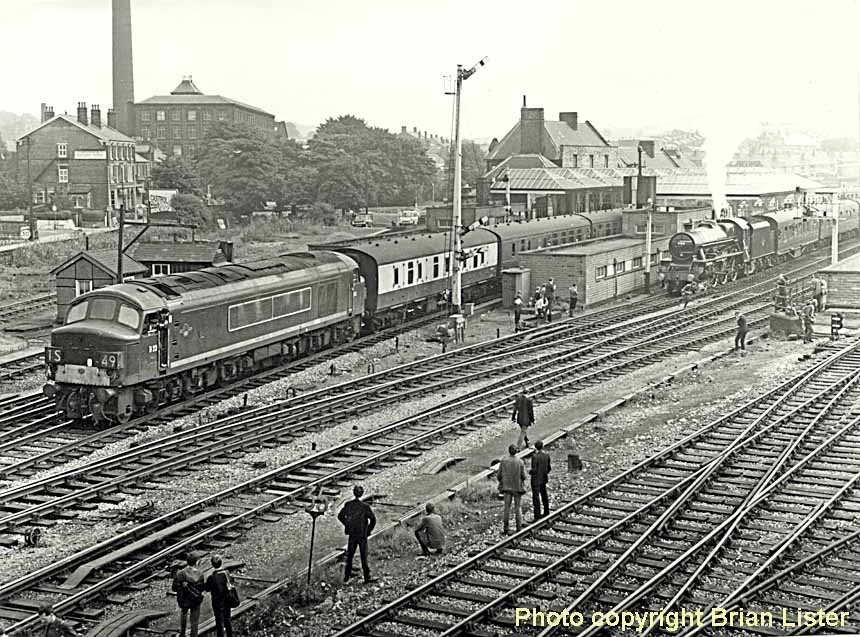
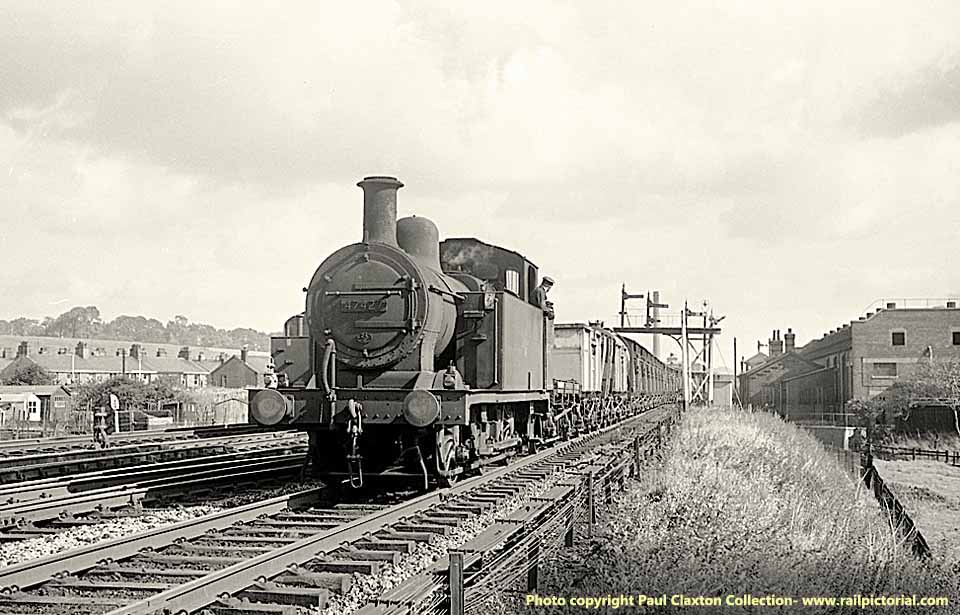
(Above-Below) Another great shot by master cameraman, Paul Claxton, who captures this image of Fowler 0-6-0T 'Jinty' No 47427 shunting a motley collection of goods vehicles comprised mainly of cattle wagons at Skipton North Junction on 27 September 1963. (Below) The transition from steam brought with it a new diesel dialogue and familiar prose like 'Crabs', 'Lizzies', 'Streaks' and 'Semi's' were soon replaced by a new choice of language: 'Bo-Bos', 'Co-Cos', 'Sparkies', 'Hoovers', 'Choppers', 'Duffs'; 'Rats' and 'Whistlers' to name just a few. The EE Co machines (later Class 40) were dubbed 'Whistlers' due to their prominent turbocharger whine. In this shot the raking light reveals that the unofficial 'Warrior' name has been removed from the bodyside of veteran 'Whistler' No 40104 as it heads the 6M37 Haverton Hill-Moss Sidings ICI tanks out of the goods loop at Skipton. The severed track in the foreground once formed Skipton North Junction where the MR line diverged to Colne. Passenger services were withdrawn in February 1970 and the track was lifted soon after. 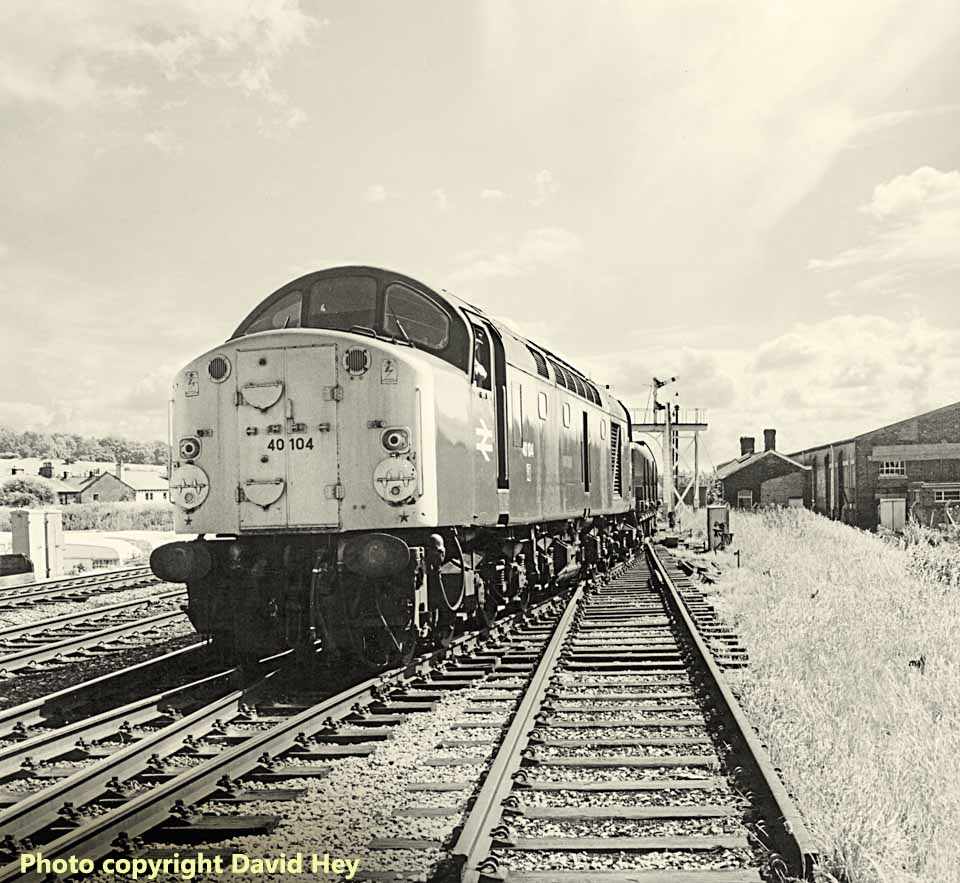
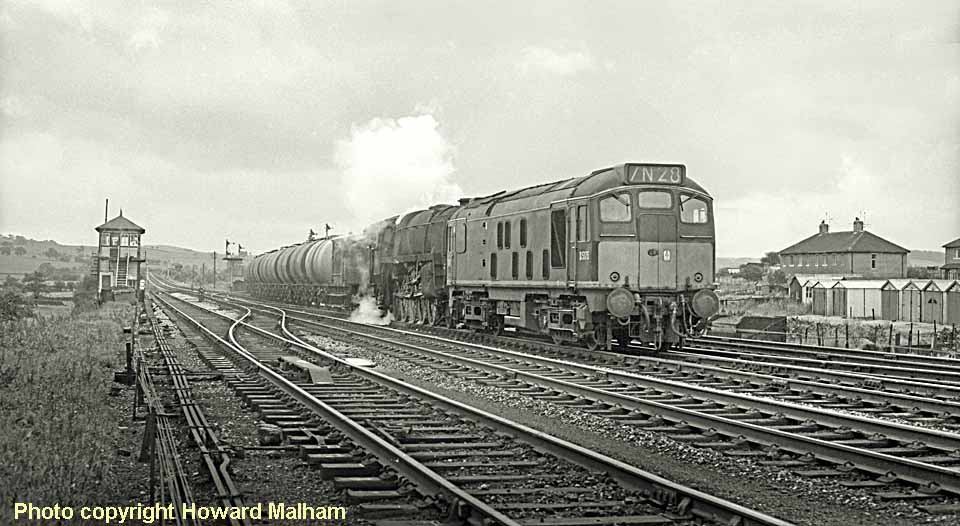
(Above-Below) Apart from spotters nicknaming the various diesel classes, a whole new jargon entered a railwayman's vocabulary and 'double-headed' diesels operated by one driver became known as 'multiple working' whereas coupled locomotives driven independently were called 'tandem workings'. Neither is the case here as Class 25 No D5175 (dubbed 'Rats' by spotters) pilots an unidentified Class 9F 2-10-0 on a Heysham-Hunslet tank train at Skipton North Junction on 30 September 1967. When the operating department was required to provide double-headed steam-diesel combinations, it was obligatory for the steam locomotive to be coupled inside in order to avoid the risk of hot ashes dropping from the leading steam locomotive which could ignite the accumulative oil deposits on the underside of the trailing diesel; there was also the risk of coal tumbling from the tender and smashing into the diesel's cab window. The Class 25 is sporting a Thornaby (51L) shedplate on its warning panel. 
(Above) Despite the costs saved by the Beeching closures, BR's deficit continued to grow whilst the rail network grew smaller. The relationship between these is a moot point. Taking social considerations out of the equation, however, it was foolhardy to advocate the retention of some lines, yet an increasing number of areas with a high-density population were to lose their vital railway facilities. This included the line connecting the industrial West Riding of Yorkshire via Skipton to Colne and beyond to Burnley, Blackburn, Preston and Manchester. The line to Colne can be seen directly ahead as 'Jubilee' class No 45562 Alberta heads a Carlisle-Leeds goods past Skipton North Junction. Out of a total of 190 'Jubilees', No 45562 was among the final three to be retired from Leeds Holbeck shed in 1967. Today, four survive in preservation: Nos 45593; 45596, 45690 and 45699.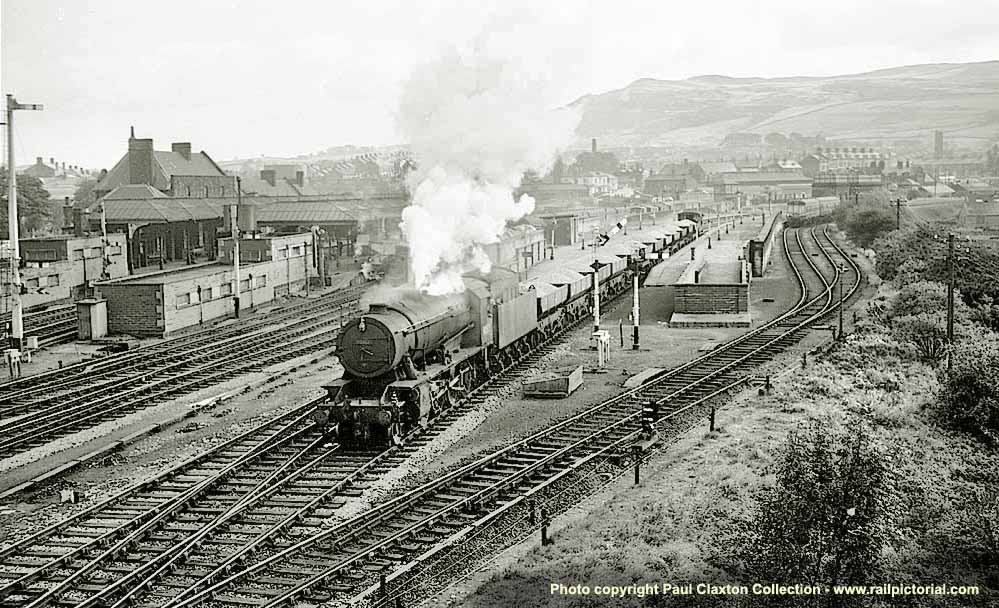
(Above) When I first posted this splendid Paul Claxton shot taken from Carleton New Road bridge of WD 2-8-0 No 90517 arriving at Skipton on 27 September 1963, I described it as hauling the Tilcon train from Rylstone...WRONG!
I am advised by FW (Bill) Smith, then signalman at Embsay station in 1963, that it is not a Tilcon train.
Bill writes - ' On looking in my 1963 diary I see I was on duty at Embsay station box that morning, and this was a special train of ballast hoppers from the Skipton Rock Company at Embsay destined for New Hey in Lancashire. I signalled this train out at 9.55am that morning. Special ballast trains from Embsay were common at this time mostly on Thursdays and Fridays for reballasting work at weekends...'
Thanks Bill, corrections are always welcome, and thanks also for your contribution to a new page featuring the railways through Wharfedale...
A link to Bill's new page can be found HERE...
FOOTNOTE
I have received an email from ex-spotter Craig Duncan, now living in South Africa...
Craig writes - 'Hi David, I started train spotting in north-east Lancashire in 1944, and purely by chance I came across your site when researching the times that the 'Thames-Clyde' and the 'Thames-Forth' came through Skipton in the mid-to-late 1940's. I was living in Colne at the time and regularly accompanied my mother on the journey north to visit relatives in Scotland. Imagine struggling to board the crowded 11.07am (10.25am 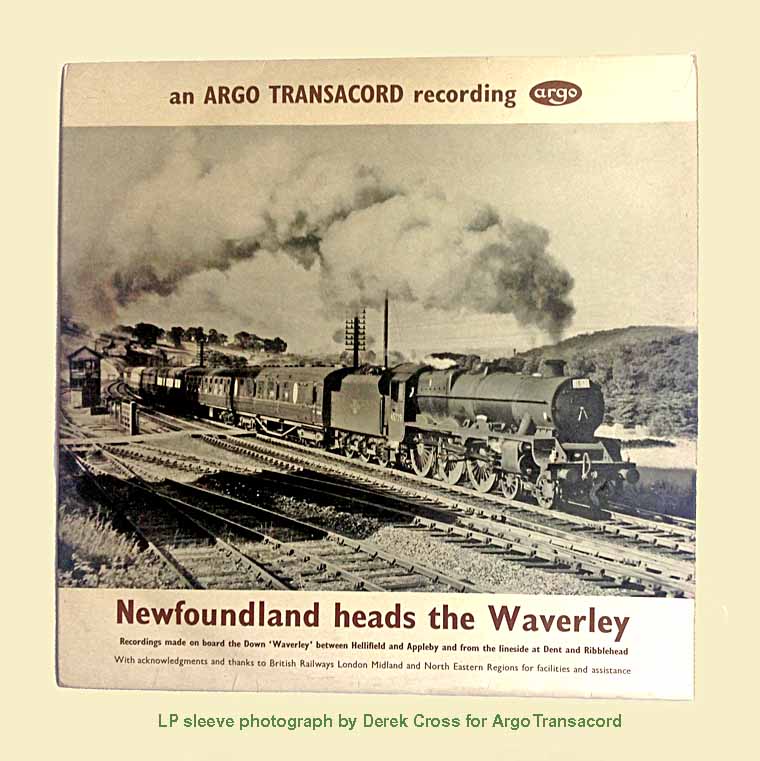 ex-Leeds) at Skipton in early 1945. The only seat was on a soldier's kitbag or one's suitcase in the smoke filled corridor. And on the return Sunday trip, I'm not sure if it was a vision or reality seeing a distant group of North-Eastern engines tucked into the hillside near Kirkby Stephen? This is a journey that I would do many times and it always delivered its own brand of magic.
ex-Leeds) at Skipton in early 1945. The only seat was on a soldier's kitbag or one's suitcase in the smoke filled corridor. And on the return Sunday trip, I'm not sure if it was a vision or reality seeing a distant group of North-Eastern engines tucked into the hillside near Kirkby Stephen? This is a journey that I would do many times and it always delivered its own brand of magic.
I can still relive the experience here in South Africa by switching on my record player and playing (at loud volume) an Argo Transacord LP - 'Newfoundland heads the Waverley'; it was recorded on board the 'down' 'Waverley' between Hellifield and Appleby with lineside recordings added at Dent and Ribblead. The cover features a splendid Derek Cross photo of 'Jubilee' class 45729 Furious blasting upgrade past Staniforth Sidings, and the evocative notes on the sleeve never fail to jog childhood memories of rattling through the tunnels or the apparent increase in speed as the train traverses the MR 30ft rails. And I can add visuals; the rain lashed windows, the becks in spate; drifting steam and the ever present wisps of smoke hanging over the ventilation shafts of Blea Moor seen from the top of Ingleborough...'
Craig continues - 'Skipton was almost my second home as a young locospotter which left me with BIG memories. Attached is my sole photograph (below) which shows a 'Crab' about to run along platform 2 while a DMU is standing in platform 4 awaiting departure for Colne or Barnoldswick. After a lengthy subway walk, one accessed platforms 5 & 6 which served the Ilkley line, shown on the extreme right. This part of Skipton station was almost a law unto itself and in the mid to late 1940's produced many engines of interest. These included LNER G5 0-4-4Ts supplied by Neville Hill, Stanier 0-4-4Ts Nos 6400-4 (later renumbered 1900-4) and Aspinall 2-4-2Ts. In January 1947 ex-Caledonian 0-4-4Ts Nos 15130 and 15192 started to work the line and made a novel sight. In April 1947 they were replaced by Nos 15169 and 15227, however this was a short sojourn and never repeated. A routine working over the line was the Colne-Harrogate coal train always hauled by double-headed J39s from Starbeck. This consisted of approximately 30 full wagons with a similar load of returning empties back to Colne. In June 1946 the 'Saltburn' commenced operation and ran each Saturday to Blackpool throughout the summer months. It started from West Hartlepool, ran through Ilkley and upon reaching Colne an exchange of engines took place. The train consisted of delightful Gresley teak stock and was hauled by B16, K3 or B1 classes. The service ceased operation in 1963. 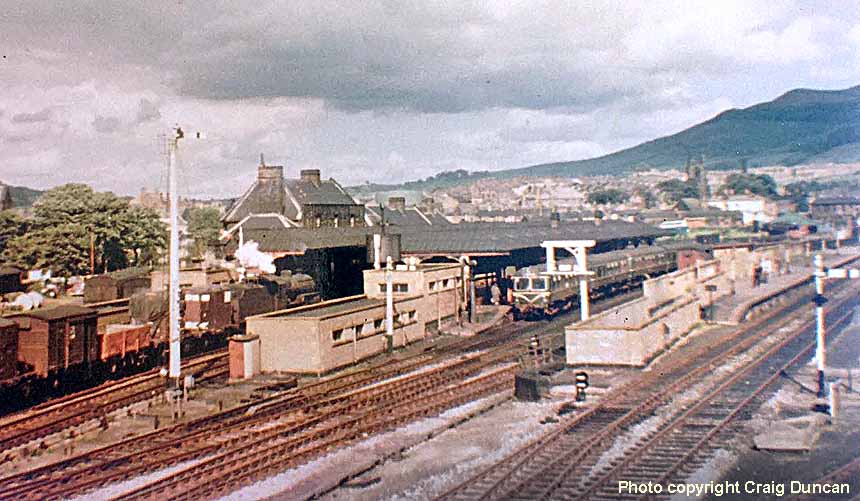
Polite notice: All text and photographs are protected by copyright and reproduction is prohibited without the prior consent of the © owners. If you wish to discuss using the contents of this page the email address is below. Please note - this is not a 'clickable' mail-to link via Outlook Express. You will have to email manually.
dheycollection@ntlworld.com




